
Publications The Great Buy-Out: M&A In China
- Publications
The Great Buy-Out: M&A In China
- Michael Tierney
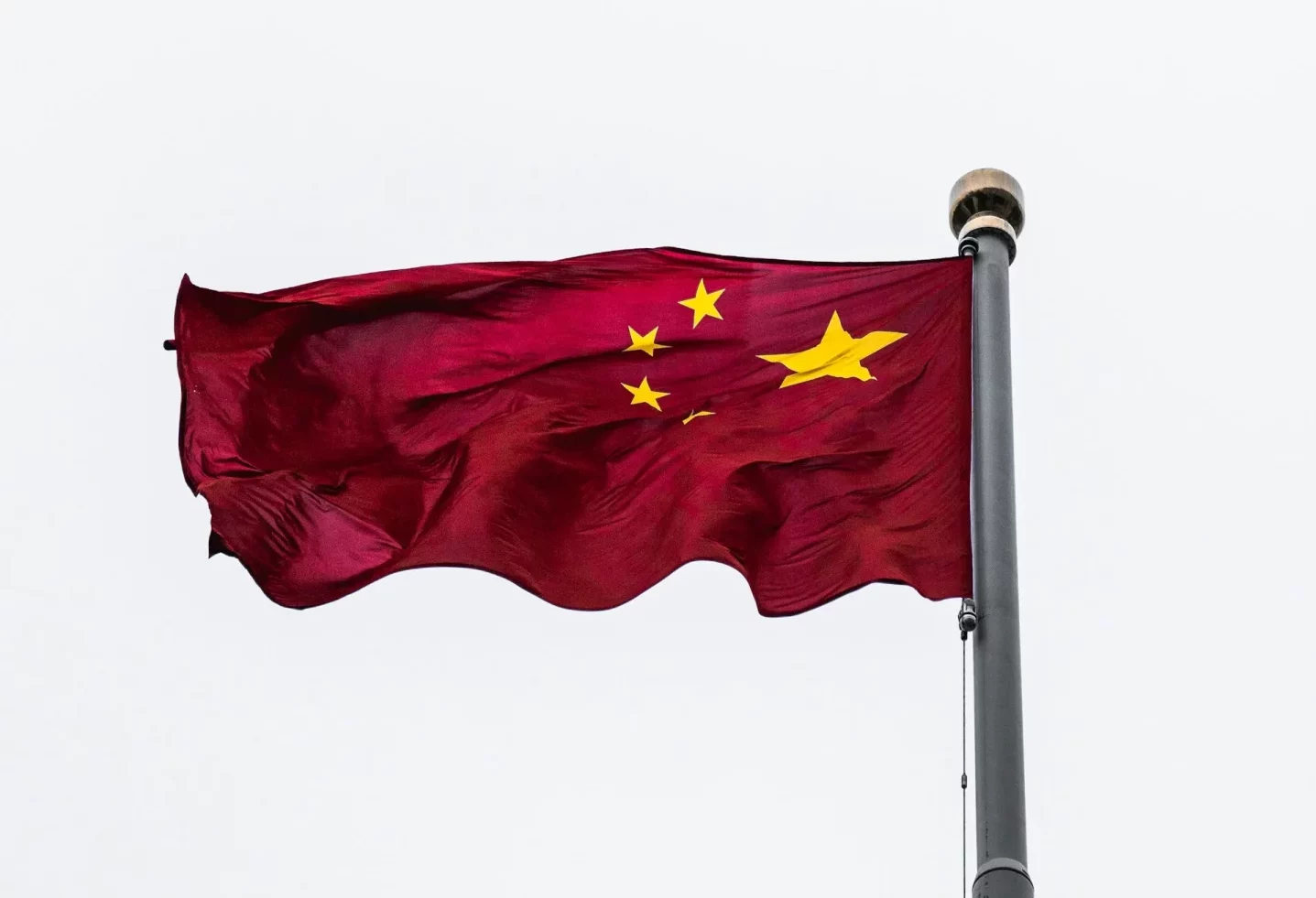
SHARE:
Introduction
One of the first merger-and-acquisition (M&A) transactions in China was completed in 1985, barely seven years after Deng Xiaoping started opening communist China to the world. It was the purchase by Singapore’s Hong Leong Enterprises, for an undisclosed sum, of Rheem (Far East), a maker of steel drums established in pre-communist 1946 China by Rheem International USA. Hong Leong upgraded Rheem’s facilities and injected its businesses into its China unit, which today owns 15 plants that churn out steel drums and pails, plastic bottles, jerry cans and other plastic and steel containers.
Fast forward 20 years to 2005. The world was stunned by news that US icon IBM, a company synonymous with personal computers (PCs), was selling its PC business for U$1.75bn in cash and assumed debt—to China’s Lenovo Group. It was a great leap forward from the humble steel drum to the IBM ThinkPad. As tracked by global data provider Thomson Financial, completed M&A deals involving China totalled just US$124m in 1985. The tally jumped to US$1.9bn in 1995, and to a record-breaking US$28.5bn last year, making China the largest M&A Asia-Pacific market after Japan and Australia. China passed South Korea for the No 3 spot in 2002.
How will China’s rise as both M&A target and acquirer affect domestic, regional and global businesses? What opportunities await acquiring companies? How can they avoid the inevitable pitfalls? Which mainland industries are ripe for consolidation at this time and which ones look ready for the picking going forward? Conversely, what are the foreign assets that are attracting the attention of emerging Chinese multinationals? And what about the morning after? With the frenzy of deal making behind them, how can companies increase the chances of success for their new acquisitions?
This white paper aims to answer those questions through a survey of 231 companies in China and the rest of the world on their M&A intentions, activities and experiences. We also conducted in-depth interviews with acquired companies, those that did the acquiring, Chinese regulators, investment bankers, management consultants, private-equity investors, lawyers, academics and others engaged in the M&A process. The data and insights gleaned are set forth in five chapters.
Chapter 1 The playing field takes a macro look at M&A in China, at the economic, regulatory and business drivers within and without the country that are influencing the trend, and the key sectors experiencing M&A activity.
Chapter 2 Who are the players? focuses on the M&A dramatis personae, including multinational companies, private-equity firms and other foreign enterprises seeking to buy a piece of China, and the eme rging Chinese transnationals that are starting to acquire companies and assets abroad.
Chapter 3 On the ground: survey results forms the heart of this white paper and is the chapter where we analyse the findings.
Chapter 4 Operational issues is devoted to the M&A process, looking at among other topics, due diligence, valuation, regulatory approvals and post-merger integration.
Outlook: The way forward is the concluding section that outlines what lies ahead for M&A in China. The current trend of rising M&A activity will continue gathering strength in the foreseeable future as China overtakes Germany to become the world’s third-largest economy.
(Last year, China surged past France, the UK and Italy to claim the No 4 slot.) The other key M&A drivers include China’s fulfilment of its pledges to the World Trade Organisation to fully open to foreigners its financial, telecommunications, retail and other service industries, and the growing maturity and sophistication of domestic Chinese enterprises.
This expectation is consistent with the Economist Intelligence Unit’s survey results. Four out of ten respondents globally say their company has conducted or is considering an M&A transaction in China. Domestic Chinese companies are even more aggressive, with nine out of ten saying that they have participated or intend to participate in an M&A. This is not to say that everything will go smoothly: 64% of global respondents worry about lack of transparency at a target-company, 61% about the risk of culture clashes in the merged organisation, and 51% about China’s restrictive regulations.
They have reason to be wary. In a report to be released in April 2006, the Organisation for Economic Co-operation and Development (OECD) lauded China for streamlining project approval procedures and promulgating landmark legislation on cross-border M&A in 2003. But the OECD still judges the regulatory framework “fragmentary, over-complex and incomplete,” and notes that “foreign ownership restrictions persist and are not wholly transparent.” The report recommends a number of policy responses, among them further easing of foreign-ownership restrictions, adoption of best-practice and transparent merger notification procedures, more improvement in corporate governance, and full opening of capital markets to foreign investment.
While the government grapples with these complicated issues, foreign and domestic businesses appear to be increasingly willing to take their chances with the imperfect M&A rules. China and the rest of the world are simply moving too fast. It is clear that M&A and the industry consolidation it brings would soon become a significant part of China’s business landscape. The farsighted enterprise, whether a multinational or a Chinese company, would do well to take this into account in conducting its business today and in planning for tomorrow.
Executive summary
For many investors, China is a land of limitless opportunity. There, they can sell their goods and services, feed their supply chain, invest in companies—or buy them out. The first merger-and-acquisition (M&A) transaction was completed in China in 1985, and since then the country has become a prominent target and a prolific acquirer. Completed M&A deals involving China totalled a mere US$124m in 1985. Two decades later, that figure has soared to US$28.5bn, and China has dislodged South Korea as the third-largest M&A market in Asia after Japan and Australia.
Will this frenetic M&A activity continue in China? Absolutely, says The great buy-out: M&A in China, a new report by the Economist Intelligence Unit (EIU), sponsored by Ernst & Young, Mercer Human Resource Consulting and Morgan Stanley. M&A activity will maintain its sizzling pace, with foreign-domestic transactions rising over the next five years, according to 65% of respondents to a global survey of 231 executives. About half of respondents also believe that in the same period there will be an increase in domestic-foreign, and domestic-domestic, M&A transactions. China-based respondents were even more positive about domestic-domestic M&A in China—six out of ten expect it to climb even higher.
The report, which is based on the survey results and interviews with local and foreign companies, as well as government agencies, lawyers, consultants and other M&A professionals, suggests that the main reasons for the acceleration are the rise in purchasing power and private consumption in China, and the government’s desire for foreign funds and expertise for its state-owned enterprises (SOEs) as it opens sectors of the economy to foreign competition. A more relaxed regulatory regime also has expanded the scope and geographical reach of wholly owned foreign enterprises. Underpinning many of these drivers is China’s commitment to liberalise its economy on its entry into the World Trade Organisation in 2001.
Other main findings of The great buy-out: M&A in China include:
• Many foreign companies are making limited M&A forays into China. The reasons are to get a feel of the process and learn the ways of the local competition in anticipation of the economy being opened fully. Domestic private-sector companies are being propelled by the same imperative, often upon the prodding of private-equity investors.
• Domestic demand is leading to the creation of local private companies, which often become M&A targets. Surging domestic demand has led to the emergence of hundreds of thousands of local private-sector firms that are competing with state-owned companies. Sino-foreign joint ventures, which in the early years focused on China as a cheap source of labour to make goods for export, are now targeting Chinese consumers themselves.
• The sector of choice in foreign-domestic M&A last year was finance. This sector, particularly the banks, attracted US$9.7bn in completed acquisitions—not surprising, given the Chinese government’s focus on strengthening the fragile financial system and the scheduled further deregulation of the banking industry. At a distant second was high technology, including computers, followed by industrials. In domestic-domestic M&A, the hottest sectors last year were industrials, energy and power, materials, high technology and real estate. The deals tended to cluster around state-owned companies purchasing their own subsidiaries or each other. In domestic-foreign M&A, energy and power accounted for 46% of all outward investments in 2005, with high technology coming second at 33%.
• Foreigners, primarily from the US and Europe, are the main acquirers of Chinese assets. They fall under two broad categories. The first category comprises strategic investors, which are operating companies buying other businesses to expand or defend market share and enhance profitability. Among the foreign companies that made the biggest M&A waves in China in 2005: Bank of America, HSBC, Royal Bank of Scotland and Goldman Sachs. The second category comprises private-equity investors, which buy minority stakes in start-ups, mid-growth enterprises and mature businesses. They use funds pooled from individual investors, with the aim of eventually selling out at a profit through such exits as an initial public offering or a sale to strategic investors.
• Chinese private-sector companies are the most interesting targets. Most of these are still too small to interest foreign strategic investors, but they are attractive to private-equity investors and to larger Chinese companies. There are three other categories of targets for foreign (and some domestic) acquirers: SOEs that are under pressure from the central government to consolidate as China allows foreigners into their industries (including iron and steel, automobiles and financial services); money-losing SOEs selling off non-core assets or whole operations; and state enterprises set up to build and operate infrastructure facilities such as toll roads that are now selling off concessions.
• Synergies with their core business and rates of return on investment are the main attributes in targets. Half of respondents to the global survey believe these are the key factors when identifying targets. Four of ten (40%) also cite the prospect of the target-company improving their firms’ position in the China market. Respondents in the China-only segment of the survey also identify synergies and rates of return as important factors, but 34% of them also point to low-cost manufacturing as a factor for considering a company for acquisition.
• Lack of transparency at a target-company is a major hurdle facing M&A transactions in China. So say 58% of survey respondents; 46% cite lack of information about a target. These opinions make it particularly imperative for an acquirer to conduct due diligence on a target. This is not easy, however, because of incomplete or inaccurate information on a target.
• Maintaining relationships post-deal is a major concern. Fully 43% of respondents to the global survey are worried about keeping their relationships with customers, suppliers and government authorities after an M&A transaction. Not surprisingly, foreign companies are more worried about this aspect than are domestic firms, which operate in their own territory.
• External advisors are considered valuable to the M&A process. The majority of respondents say they will call on outside specialists for help on legal issues (72%) and tax matters (53%). Some welcome assistance with facilitating negotiations (44%), analysing financial issues (41%), and identifying potential targets (36%). Few see the need, however, for outside help in tackling organisational and human-resources issues.
• Cultural integration is a critical people issue in the M&A process. In the global survey, 67% respondents say this is so. Of the China-based respondents, too, 62% are leery of the risk of culture clashes in merged organisations. (Nine out of the of the China-only respondents have conducted or are considering an M&A deal.) Differences in culture between firms are generally acknowledged as a major source of attrition after a merger, and yet these differences are rarely investigated closely as a deal nears closure. One common mistake is for managers in foreign companies to view Chinese companies as a bloc, and vice versa. In reality, corporate culture is much more complex, involving both national cultural mores, the culture promoted by the senior management and often a melding of both.
• Retention of key talent is a challenge in an M&A deal. The larger people issue is keeping key talent (59% of respondents mention it). Leadership or management style and control are seen as important by 56% of global respondents. There are no marked differences on these issues among China-only respondents. While an acquirer will want to have as strong a role as possible in running the target-company, it also knows that the original management team has the vital experience and contacts important in doing business in China. Companies interviewed for this study are split between using soft options like training programmes and benefits, and hard options like higher pay scales or post-acquisition contract agreements of up to three years. Companies seem to be still considering different approaches and have not settled on one method of retention.
• Redundancy is not a major people problem in China M&A deals. Only 12% of the total respondents consider redundancy to be a people issue in a merger and acquisition. One reason is that many M&A agreements require a target-company to clean up the rolls before a handover, and the cost of redundancies is often included in the selling price. Moreover, contrary to popular perception, letting workers go is much easier in China than it is in Western countries, and the costs and timeframe for doing this are relatively smaller and shorter. However, while it might be easy to let workers go, this can be time-consuming for human- resources managers who have to deal with the possible fall-out. This includes handling complaints made to local bureaux by workers made redundant.
• A poor understanding of the operating environment in China is the main reason for a merged or acquired company to fail. Almost half of the respondents to the global survey say this is so. Three out of ten respondents also point to the failure to achieve financial targets, lack of proper due diligence of the target-company, poor protection of intellectual property rights, and resistance and negative pressure from local and central authorities. Surveyed executives in the China-only segment, however, put a higher emphasis on failure to achieve financial targets (45% say so), and then a poor understanding of the operating environment (42%). However, the majority of surveyed executives define the success of a merger in terms of its effect on profits (77%), followed by its effect on market share (59%), and effect on share price (37%).
Who took the survey?
A total of 231 senior executives from companies worldwide participated in the study, with a little over half of respondents based in North America (20%) and Europe (33%). Fully 17% of respondents were based in China and another 20% elsewhere in Asia-Pacific. The remainder were from Latin America, Middle East or Africa.
The respondents were chief executives/ presidents/managing directors (17%), heads of department (13%), senior vice-presidents/vice-presidents/directors (11%), heads of business units (10%), chief financial officers/treasurers/ comptrollers (9%) and board members (5%). The rest included other C-level executives and managers.
Manufacturers accounted for 17% of respondents, followed by financial services (13%), professional services (9%), information technology and technology, and consumer goods (8% each). Other industries include energy and natural resources, telecommunications, automotive, and construction and real estate.
In terms of global annual revenue, 32% of respondents were from companies with US$100m or less, 19% were from firms with US$100m to US$500m, 8% from firms with US$500m to US$1bn, 15% from firms with US$1bn to US$5bn, 7% from firms with US$5bn to US$10bn, and 18% from firms with US$10bn or more.
Chapter 1
The playing field
Amerger-and-acquisition (M&A) spree in China is almost inevitable. The GDP has been expanding at an annual average of 9.5% since 1981, propelling the country to the ranks of the world’s largest economies. Moreover, the Chinese government is actively encouraging consolidation in such industries as banking, steel, aviation and automobiles, and is seeking foreign money and expertise for hundreds of state-owned enterprises (SOEs). It also seems serious about its commitment to the World Trade Organisation (WTO) to liberalise key industries, and to level the playing field for Chinese and non-Chinese companies alike in many (though not all) business sectors.
The early results are already showing up in league tables compiled by Thomson Financial, a data provider. Completed M&A transactions involving China clocked in at a paltry US$124.4m in 1985 (see table, Great leap forward). The volume had grown to US$1.9bn ten years later. In 2005 M&A activity involving China, as target and acquirer, topped US$28.5bn, 14 times the deal volume ten years ago. The headline transactions included the US$3.9bn purchase of minority stakes in China Construction Bank by Bank of America of the US and Temasek Holdings of Singapore, as well as the nearly US$4bn takeover of PetroKazakhstan by China National Petroleum.
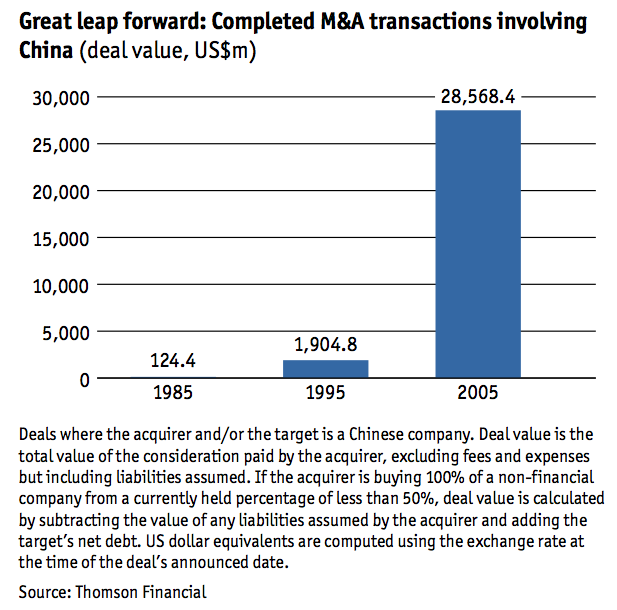
Room to grow
Over the past five years, China-related M&A has totalled US$107.4bn, the value of 2,936 transactions (see table, Asian action). This is 17% larger than the value reported for South Korea, which until 2002 was ahead of China in M&A league tables. Compared with Australia and Japan, however, China’s M&A deals are still up to three and six times smaller, respectively.
What this tells us is that the M&A market in China still has a lot of room to grow, especially since the country’s GDP and its private consumption have been robust.
Another relevant trend here is the rising proportion of inward M&A investment in China to total foreign direct investment (FDI). The United Nations agency for trade and development, UNCTAD, estimates that cross-border M&A sales as a percentage of FDI into China reached 5% in 2001, decelerated to 3.9% in 2002 and then jumped to 7.1% in 2003.
Last year, according to Thomson Financial’s tracking, inward M&A deals in China topped US$13bn. Total China FDI in 2005 was US$60.3bn, suggesting that the proportion of M&A transactions to FDI last year had surged to 21.5%. That’s an impressive increase, but still far behind the global average of 53.1% in 2003—again implying more room for growth for M&A activity in China.
Last year, however, China was slightly behind South Korea in completed M&A transactions, whether foreign-domestic, domestic-domestic, or domestic-foreign (see table, Target practice).
But like South Korea and India, China remained more of a target for mergers and acquisitions than a net acquirer of assets, as Japan and Australia were in 2005. China, of course, is still a less developed economy than either Japan or Australia, despite its world-beating GDP growth rates in the past two decades.
At US$7.9bn, China’s outward M&A set a record last year (see table, China’s outward push), but it is doubtful whether that fast a pace can be sustained. Oil companies under state orders to secure national energy accounted for nearly half of that amount.
Other Chinese companies remain hobbled by restrictions on the outward movement of capital and, in any case, many still lack the “management bandwidth”, as an M&A professional puts it, to successfully run global entities. The overwhelming majority, in fact, are focused inward. In an Economist Intelligence Unit study in 2005 entitled Domestic companies in China: Taking on the competition, nine out of ten respondents to a survey said their company’s main target would be the home market in the next three years.
Politics can also be an impediment. Last year, Chinese oil company CNOOC alarmed the political establishment in the US when it unveiled a US$18.5bn bid for a mid-sized US firm, Unocal (see CNOOC: a Chinese oil company steps out). CNOOC dropped the proposed purchase when it became clear that the US Congress would oppose the deal in the belief that it would harm US interests.
Another announced bid, by Chinese appliance-maker Haier for US washing machine brand Maytag, also failed in 2005 when its US$1.28bn offer was topped by Whirlpool’s US$1.37bn tender.
Drivers of M&A
Not that Chinese outward M&A would dry up completely. There are oil and other resources in countries where the US and other developed countries fear (or are unwilling) to tread, among them Sudan and Myanmar. Even so, the expectation is that the bulk of M&A volume going forward will be accounted for by foreigners investing in, or acquiring, domestic companies, and by domestic companies merging with and acquiring each other. The key drivers here include rising purchasing power and private consumption, the government’s desire for foreign funds and expertise for SOEs as it fully opens sectors of the economy to foreign competition, and a more relaxed regulatory regime that, for example, has expanded the scope and geographical reach of wholly owned foreign enterprises (WOFEs).
As tracked by the Economist Intelligence Unit, private consumption in China has been growing by better than 6% annually (and more than 10% in some years) since 1991, and is forecast to continue expanding by 7%-9% a year from 2006 to 2012. Personal disposable income has been keeping pace at more or less the same rate, growing 9.4% and 8.9% in 2004 and 2005, respectively, and is forecast to expand by 7% this year and next. The country is rapidly emerging as a domestic market in its own right, particularly in the coastal provinces, where GDP per-capita now tops US$2,100. That rich crescent spanning Liaoning province in the north to Guangdong down south is home to 482m Chinese, larger than the entire US population of 298m.
Demand begets supply, and so hundreds of thousands of local private-sector firms have sprung up to compete with state-owned companies. Sino-foreign joint ventures, which in the early years focused on China as a cheap source of labour to make goods for export, are now targeting Chinese consumers themselves. Some industries have already become very crowded, including those for automobiles, home appliances, mobile phones and consumer electronics—and therefore ripe for consolidation. Cherry-picking is well under way in beverages, with the US’s Anheuser-Busch, Europe’s InBev (formerly known as Interbrew), South Africa’s SABMiller and Japan’s Kirin merrily snapping up Chinese breweries, brands and sales networks.
The central government is giving M&A a big push. It has mandated consolidation in such fragmented sectors as steel and aviation, although the companies themselves, many of them state-owned, have been dragging their feet. After approving the purchase by foreign giants such as HSBC, Bank of America and Temasek Holdings of small stakeholdings in state-owned mega-banks, regulators in Beijing are considering a proposal by a consortium led by Citigroup of the US to buy 80% of bankrupt Guangdong Development Bank, China’s 11th largest financial institution. Current rules limit foreign participation in banks at 25% in aggregate, so an exception made here would signal a significant change in thinking.
China’s efforts to streamline regulatory hurdles are also driving M&A activity. The central government issued the Provisional Rules on the Merger and Acquisition of Domestic Enterprises by Foreign Investors in 2003, which considerably clarified the M&A process in China. The next year, the Ministry of Commerce promulgated the Administrative Measures Governing Foreign Investment in Commercial Sectors. These rules allowed WOFEs to engage in commission agency, wholesaling and retailing (from just manufacturing for export previously) and abolished geographical restrictions on foreign- invested wholesaling and retailing operations.
Some joint ventures have been dissolved as foreign companies opted to acquire the assets of the partnership and inject them into a WOFE. One high-profile example is global logistics company UPS, which in 2005 took direct control of international express operations in 23 cities it previously co-owned with Sinotrans, a Chinese SOE. UPS paid Sinotrans US$100m, a windfall that the Chinese company will use to enhance its own operations — and perhaps to fuel its own M&A plans.
Domestic-domestic transactions are also on the rise (see table, Buy, buy, buy), peaking in 2002 and 2003 when state-owned companies like China Mobile and China Unicom hived off units for listing in Hong Kong and the US, and then injected their assets into the new public entities. The government is continuing its campaign to force state-owned enterprises to consolidate, which has resulted in such deals as Baoshan Iron and Steel’s acquisition for US$2.2bn of Shanghai Baosteel in 2001. But domestic private-sector consolidation is also taking place, exemplified by the merger this year of two Shanghai advertising companies, Focus Media and Target Media.
In a sense, what is behind many of these drivers is the WTO, or to be precise, China’s promises to open certain sectors of its economy to foreign players when it was accepted into the WTO in 2001. The country has delivered on a number of those pledges, such as raising the cap on foreign ownership in basic telecommunications services to 49% and abolishing requirements that had forced foreign car makers to enter into joint ventures with local companies. It has also promised to lift geographical restrictions on foreign operations in the banking and insurance sectors by late 2006.
The WTO commitments explain in part the Chinese government’s consolidation drive, which rests on the assumption that large entities will have a greater chance of competing against the anticipated entry of global giants. For their part, foreign companies are getting their feet wet with limited M&A initiatives to get a feel of the process and learn the ways of the local competition in anticipation of a full-scale assault when (or if) the gates are finally thrown open. This is the same imperative that is beginning to dictate the tempo of M&A activities among domestic private-sector companies. Often upon the prodding of private- equity investors, they are beginning to regard inorganic growth as a rapid way of achieving scale.
Private-equity investors can potentially play a key role in M&A transactions in China going forward. With seats on the board and their status as trusted advisers of the founding entrepreneur, they can make the case for a merger or acquisition that would maximise the company’s value, along with their minority stakes. It will take patience, given entrepreneurs’ understandable attachment to their enterprises, but there could be a snowball effect if a significant number of firms jump on board—particularly if bottom lines at some of the weaker players deteriorate in an economic slowdown. In turn, consolidation in China’s highly fragmented industries can stimulate M&A interest among foreign companies, since there would then be sizeable targets to pursue.

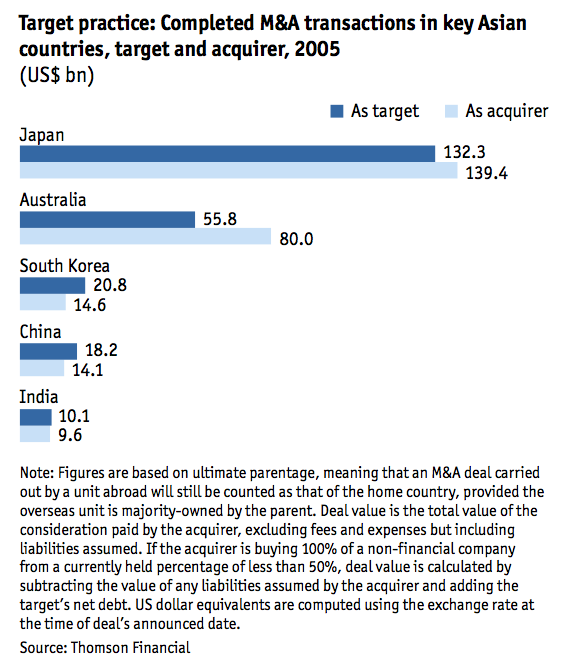
Sectors of choice
In foreign-domestic M&A, the overwhelmingly favoured sector last year was finance, particularly the banks, which attracted US$9.7bn in completed acquisitions (see Open for business). This is not surprising given the government’s focus on strengthening the fragile financial system and the scheduled full opening of the banking industry. Far behind in second place was high technology, including computers, followed by industrials, especially cars and ports, materials (aluminium, cement and paper) and consumer staples.
In domestic-domestic M&A, the hottest sectors last year were industrials, energy and power, materials, high technology and real estate. The deals tended to cluster around state-owned companies purchasing their own subsidiaries (for example, Huadian Power International’s acquisition of Huadian Xinxiang Power) or each other (e.g., PetroChina buying Liaohe Jinma Oilfield and Jinzhou Petrochemical).
In domestic-foreign M&A, energy and power accounted for 46% of all outward investments in 2005, with high technology (including Lenovo’s purchase of IBM’s personal-computer division) coming second at 33%. Telecommunications had an 11% share, industrials 7%, and financials a tiny 1%.
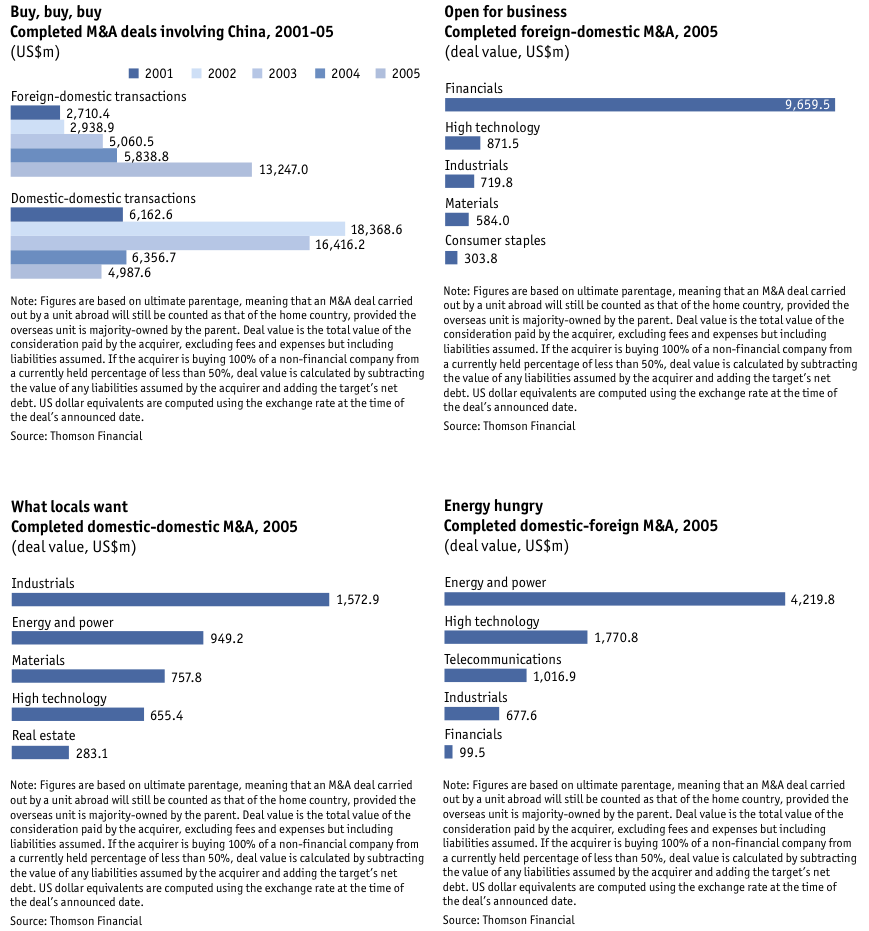
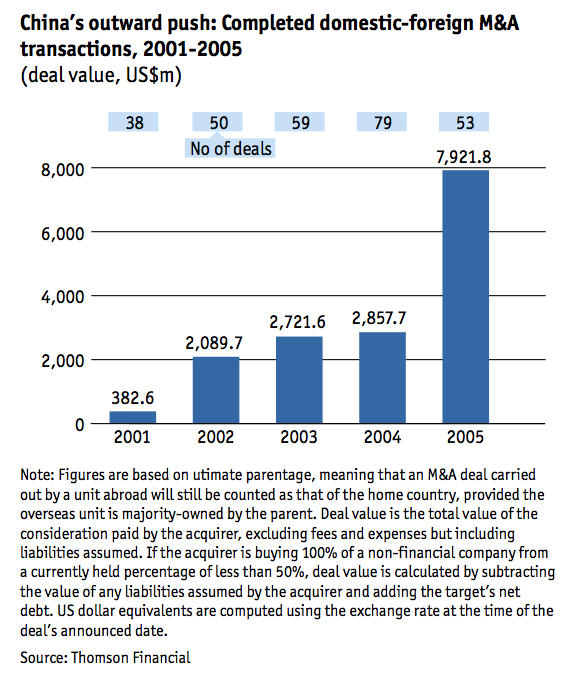
A glimpse of the future
While most completed transactions in 2005 were in financials, industrials, high technology, energy and power, anecdotal evidence suggests foreign interest spans the whole spectrum in China. Indeed, in this white paper’s survey results, discussed more fully in Chapter 3, at least three out of ten respondents from North America, Europe and Asia say their company has conducted or is considering an M&A transaction in China. North American firms are the most gung-ho, with 42% saying they are pursuing M&A in China. One reason for foreigners not moving as fast as they want is China’s restrictive regulations, cited as an impediment to M&A by 51% of respondents. Foreign participation in basic telecoms services is capped at 49% and 25% in banking, for example. Government approval is required for large and fixed-asset projects in infrastructure, agriculture and nine other industries, and for projects involving rare or precious mineral resources and in industries requiring central planning by the state, a catch-all requirement that can apply to any sector.
The paperwork becomes more stringent and time-consuming in an M&A, requiring scrutiny from regulators to ascertain, among many other things, that the amount to be paid does not exceed the allowed multiple of the acquirer’s registered capital. For example, firms with registered capital of less than US$1.2m can invest up to 1.43 times that amount, while those with more than US$12m can pay only three times that amount.
That said, M&A regulations have been revised a number of times over the past five years and a majority of multinational companies still view China as an opportunity not to be missed. “They have to come here,” says Brinton Scott, a lawyer in Shanghai with international law firm Herbert Smith. “It’s either die now or die later.”
These restrictions do not apply to domestic companies, although they have to comply with capital and other requirements. Fully 90% of mainland enterprises in our survey say they have conducted or are considering launching an M&A transaction in the domestic market. They are motivated by business reasons, mainly corporate restructuring and consolidation in their industry (51%), rather than by pressure from the government (5%). It seems that China’s companies, and the foreign firms that are courting and competing with them, are in for some very interesting times.
CNOOC: a Chinese oil company steps out
When CNOOC, China’s third-largest oil company, bought the Indonesian oil-and-gas reserves of Spain’s Repsol in 2003, the outward investment went off without a hitch. CNOOC paid US$585m, equal to US$1.64 per barrel of oil equivalent of proved reserves, a bargain then and even more so today, when oil is selling at US$60 or more per barrel. So when CNOOC made a bid in 2005 for Unocal, a mid-sized US oil firm, it was fairly confident it knew what to do.
How wrong it was. “We were very, very surprised,” Yang Hua, CNOOC’s chief financial officer, said of the firestorm the proposed acquisition created in the US. The lead negotiator in both the Indonesian and American M&A transactions, he spoke to CFO Asia, an Economist Intelligence Unit sister publication. CNOOC withdrew its offer in the face of opposition from the US Congress, but remains open to US deals. “It’s not like we’re going to take over your jobs or take your resources back to China,” Mr Yang said. “We’re happy to just take our profits and deliver them to our shareholders.”
This is, of course, the objective of any corporation—except that CNOOC is majority controlled by the communist government in China. It is listed in Hong Kong and New York, and Beijing has not been known to interfere in any way with CNOOC’s business decisions.
But oil is a strategic resource and China is desperate to have access to a lot of it to continue fuelling its economic expansion. The news that CNOOC’s acquisition will be partly funded by concessionary loans from a Chinese government bank further stoked US paranoia.
CNOOC points to its Indonesian purchase as proof of its benign intentions. It initially assigned only two Chinese managers to oversee the unit. Currently, just 20 of 900 employees are Chinese.
No worker was fired, and the Indonesian acquisition continues to operate in much the same way as it has always done. After all, extracting stuff from a hole in the ground requires the same technology and skills wherever you are in the world. CNOOC says nothing at Unocal would have changed had it succeeded in buying it.
Looking back, Mr Yang says CNOOC has learned valuable lessons for its next foray into the US. It will make sure to effectively communicate its benign intentions at the outset, in addition to ultra-competitive pricing.
Given the hysteria in March 2006 over a bid by Dubai’s state-owned DP World to buy several US sea ports, however, the climate for foreign investment, especially from China, is not exactly ideal. CNOOC may continue to look, but it is likely that its money would go to the world’s more hospitable places.
Chapter 2
Who are the players?
It takes two, as they say, to tango, and so it is with a merger and acquisition in China—you need an acquirer and a target to dance the M&A. At this time, the majority of acquirers of Chinese assets are foreigners, primarily from the US and Europe. They fall under two broad categories. The first are strategic investors, which are operating companies buying other businesses to expand or defend market share and enhance profitability. The second are private-equity investors, which buy minority stakes in start-ups, mid-growth enterprises and mature businesses using funds pooled from individual investors, with the aim of eventually selling out at a profit through such exits as an initial public offering or a sale to strategic investors.
The targets of these foreign (and some domestic) acquirers can be grouped into four general categories. The first are state-owned enterprises (SOEs) under pressure from the central government to consolidate as China allows foreigners into their industries, which include iron and steel, automobiles and financial services. The second group are money-losing enterprises owned by the central government or provincial authorities desperate to salvage what they can by selling off non-core assets or even the whole operations. The third group comprises state enterprises set up to build and operate infrastructure facilities such as toll roads that are now selling off concessions to monetise future cash flows.
The last group is in some ways the most interesting. It is composed of private-sector companies of varying sizes in various stages of development that need capital, management expertise and technology to compete in increasingly crowded markets. Most are still too small to be of much interest to foreign strategic investors, but they are attractive to private-equity investors and to larger Chinese companies. They typically operate in the newer, less high-profile sectors of the economy, such as the Internet and e-commerce, and non-strategic industries like apparel, fast food and consumer electronics. What they lack in individual size they make up for in collective volume—the private sector is now estimated to account for about 60% of China’s economic activities.
Also closely watched is a small coterie of large Chinese enterprises that are moving the other way, using capital accumulated in China to acquire assets abroad. Currently, these globalising companies are mostly resources companies, particularly those in oil, which do not necessarily need sophisticated management expertise to integrate into their operations what are essentially holes in the ground. The process of extracting, transporting and processing minerals is basically the same everywhere. The more challenging M&A deals are those that require post-merger global branding, marketing, research and development, and other management skills. This is where aspiring Chinese multinational companies may fall short, one reason why outward M&A in China is likely to remain limited at this time.
The acquirers
In 2005 mainland Chinese firms spent US$4.8bn on M&A deals with other Chinese companies as targets, according to Thomson Financial, a data provider (see Who are the buyers). The majority of the wheeling-dealing, however, was made by foreign companies, specifically those from the UK and the US, which accounted for a combined 48% of total M&A deal volume in 2005. The significant Asia-Pacific acquirers were Singapore (10%) and Hong Kong (6%), with Australia (2%), Japan (1%) and Taiwan (0.7%) far behind.
• Foreign strategic investors. The foreign companies that made the biggest M&A waves in China in 2005 and up until February 12th 2006 are the global financial giants, among them Bank of America, HSBC, Royal Bank of Scotland and Goldman Sachs (see Big deal).
Sceptics have criticised the billions of dollars that these acquirers have paid for what are, essentially, badly managed white elephants burdened by sub-standard earnings and poor assets. Balance sheets have begun to show improvements, it is true, but mainly because government bailouts allowed mega-banks like Industrial and Commercial Bank of China, Bank of China, and China Construction Bank to offload huge amounts of non-performing assets. The injections do not necessarily strengthen management and other systems, nor do they improve management quality and help ensure new loans will not turn bad.
But then these foreign buyers are strategic investors, not private-equity and portfolio managers intent on turning a profit at the shortest possible time. In our survey, a third of respondents from North America and Asia, and 28% from Europe, say the main driver for their company’s M&A activity in China is to gain access to the domestic market. Less than 3% cite as a motive the desire to increase shareholder value, at least initially—seven out of ten do say that the ultimate success of a merger should be measured by its effect on profits. A 20% stake in a mega-bank typically gives the foreign acquirer just one board seat, not enough to exert significant influence on strategy and control over operations.
Still, a minority stake can provide the foreign acquirer with a valuable asset, at least on paper. Bank of America paid US$3bn in 2005 for 8.5% of China Construction Bank, the mainland’s fourth-argest lender in assets, which works out to about HK$1.20 (15 US cents) per share. The initial public offering was priced at HK$2.35 in December that year, immediately giving Bank of America a 96% return on its investment. The stock reached HK$3.85 at one point in February 2006, valuing Bank of America’s stake at HK$73.6bn or US$9.5bn—a paper gain of 217%.
Of course, the stock price would crater if China Construction Bank were to fail to deliver on the great expectations. In any case, Bank of America cannot cash in on its paper profits now because of a three-year lock-up. Not that it wants to. The bank has the option to increase its holdings to 19.9% within the next five-and-a-half years. It can buy more if the government ever decides to increase the limit on bank foreign ownership. “A minority stake should place the investing bank in a prime position to increase its stake when, and if, the market fully opens,” says Standard & Poor’s, a credit-rating agency, in a recent report.
And even a minority stake can give a foreign investor access to an existing customer base and product range, knowledge of the Chinese market and lower regulatory risk. Royal Bank of Scotland is buying 5% of second-largest lender Bank of China for US$1.6bn. Part of the agreement is the formation of joint ventures in retail-based businesses such as credit cards and personal insurance. Thus, apart from possible paper profits on its stake when Bank of China lists in Hong Kong later in 2006, Royal Bank of Scotland could potentially leverage on Bank of China’s 80m holders of debit and credit cards, and more than 11,000 branches and offices nationwide.
Foreign strategic investors have had more luck taking outright control of businesses deemed not as sensitive as banking, such as hotels, fast-food chains and breweries. The leading example here is Anheuser Busch of the US, which paid US$765m to acquire Harbin Brewery (see case study in Outlook). Anheuser had figured in a bidding war with South Africa’s SABMiller, which had owned 29.4% of Hong Kong-listed Harbin. SABMiller had failed to secure an additional 29% stake in Harbin that was owned by the Harbin government.
This 29% was sold by the government to an investor group, rather than SABMiller, and was subsequently bought by Anheuser Busch. SABMiller then offered to buy the shares held by the public for HK$4.30 a share, but Anheuser countered with a much higher offer of HK$5.58. SABMiller decided to sell its stake, pocketing a profit of US$124m (a 143% gain on its original investment of US$87m made only 11 months earlier) that later came in handy when its joint venture with conglomerate China Resources paid US$154m for Lion Nathan’s Chinese breweries.
Some analysts say that Anheuser overpaid, but the company insists that the price was worth it for the synergies it expects from the purchase. Harbin’s Hapi brand, which has 30% of northeast China’s beer market, complements Anheuser’s super-premium Budweiser beer and premium Tsingtao (Anheuser has a 27% economic interest in Hong Kong-listed Tsingtao Brewery). Anheuser plans to use Harbin’s distribution and sales network in the northeast to strengthen the market positions of the Budweiser and Tsingtao brands there. Spanning as they do the entire beer-drinking price spectrum, the three brands are also expected to help each other in strengthening their respective market shares nationwide.
Other notable foreign-domestic deals include Emerson Electric’s US$750m purchase of 100% of Avansys Power from Huawei Technologies in 2001, Mittal Steel of India’s US$338m acquisition of 36.7% of Hunan Valin Steel Tube and Wire in 2005, and eBay’s US$150m takeover of eachnet.com in 2004. The flashiest M&A announcement in 2005 was Yahoo! Inc’s US$1bn acquisition of a 40% economic interest (with 35% voting rights) in e-commerce portal Alibaba.com. The range of sectors and players involved in these deals attests to the widening breadth of foreign-domestic M&A in China.
• Domestic strategic investors. Local companies, too, have not shied away from M&A (see table Home shopping). At US$53.6bn, Hong Kong-listed China Mobile’s series of purchases from 1998 to 2002 of the mobile-phone networks of its parent, China Mobile group, is the biggest-ever local M&A deal, followed by another telecoms transaction, that of China Telecom’s US$9.7bn acquisition in 2003 of the provincial fixed-line networks of its parent, China Telecom group.
The two acquisitions are examples of how SOEs go about getting listed. First, they inject their most profitable and cleanest assets into a new enterprise that will then go public. In subsequent years, the listed subsidiary uses its growing financial muscle to buy the rest of the assets from the parent. Because it is listed, typically in Hong Kong and often in New York as well, the subsidiary strives for transparency and arm’s length valuation in the M&A task of gutting its parent. Private-sector companies are now beginning to join the party. In February 2006, Hong Kong-listed Wumart Stores, the largest supermarket chain in Beijing, agreed to buy 75% of tiny Beijing’s MerryMart Chainstores for Rmb370m (US$36m). The acquisition helped to make Wumart even further ahead of rival Carrefour of France, Beijing’s second-largest chain. “We are now triple the size of the No 3 operator [Tiankelong],” Wumart’s chairman, Zhang Wenzhong, told reporters in March 2006. Wumart intends to squeeze more benefits from the purchase by introducing new information technology (IT) and management systems designed to enhance efficiency in operations and to strengthen cost control.
Another example is Target Media’s merger with Focus Media in January 2006. This particular deal was driven in part by private-equity investors that worked for months to nudge the founding entrepreneurs into the M&A, particularly The Carlyle Group, which has invested in Target Media. “It was 60% economic logic, 20% the trust that the entrepreneur had in us, and another 20% the consensus of other stakeholders [in both companies] who felt the same way and who were supportive,” says Wayne Tsou, Carlyle’s managing director for the Asia Growth Capital team.
• Private-equity investors. Mr Tsou believes that M&A in China will continue to surge, prodded in part by private-equity stakeholders like Carlyle. These financial investors are getting more involved in China. According to Dealogic, also a global provider of financial information, announced private-equity investments in the mainland have made a spectacular jump from just US$132.6m in 2001 to US$5.4 bn last year (see Flooding in).
Unlike strategic investors, most private-equity firms have a set time limit to exit their investments in order to realise profits for their investors—or to cut their losses, if the problems at the invested company prove intractable. They are in a hurry to enhance shareholder value by raising capital, squeezing efficiencies through improved financial, operational and IT management, growing revenue by brokering relationships among the companies they have stakes in—and these days, pushing inorganic growth, such as the Focus-Target merger.
Almost all the world’s major private-equity firms are now in China. They include Carlyle, International Finance Corporation (IFC, the private-sector arm of the World Bank), Newbridge, Temasek Holdings (Singapore’s government-linked investment company), Warburg Pincus, 3i and specialist players like Peak Capital. During the technology craze of the late 1990s, private-equity players were throwing money at anyone in China with a seemingly bright idea. They are more selective today, but are looking at every industry and company needing venture capital (for start-ups), growth equity (for mid-stream targets) and buy-out funds (for mature enterprises).
Private-equity deal sizes are growing larger, led by deep-pocketed Temasek (see Private money), and in the last two years, increasingly targeted at mature companies, including state-owned enterprises. Carlyle’s 24.9% investment in 2005 in No 3 insurer, China Pacific Life Insurance, in partnership with US insurer Pramerica Financial, is a case in point. The deal is notable for the remarkable concessions Carlyle and Pramerica extracted from the state-owned enterprise, including four board seats, veto power over key decisions, and the right to appoint the chairman of the management committee, chief actuary, chief investment officer, chief audit officer and other managers.
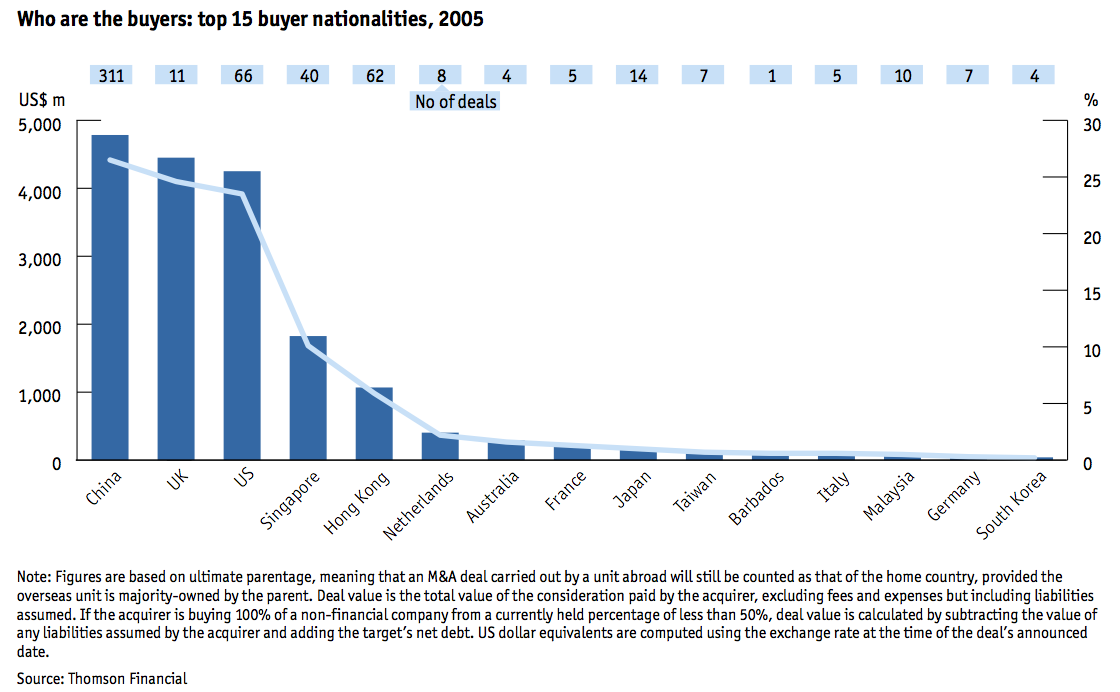
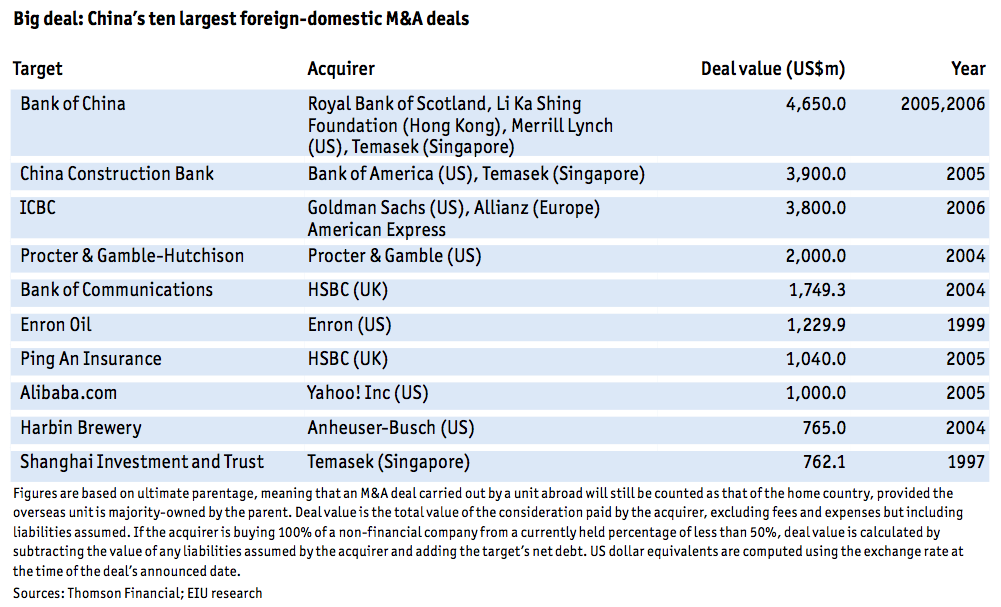




For Sinotrans, M&A is a way to become competitive
Sinotrans has hardly been monogamous. The Hong Kong-listed arm of Sinotrans Group, a Chinese state-owned enterprise, Sinotrans has partnered some of the best and biggest companies in express mail and freight forwarding: UPS, DHL and TNT among them. The relationships started mainly because foreigners earlier could only enter China’s logistics and distribution business through partnership with a local company.
Although China’s entry to the World Trade Organisation has eased regulations for foreign multinational companies, domestic companies in the meantime have learned from their international partners and want to develop their own muscle. Many, including Sinotrans, plan to do this through mergers and acquisitions (M&As). Notes Zhang Jianwei, president and executive director of Sinotrans: “Our goal is to increase our competitiveness and market share, so we will use M&A to increase our chances of being competitive.”
According to Mr Zhang, the most important development will be in logistics. Sinotrans has already increased its capacities in freight forwarding (air and ocean), shipping agency, express mail, warehousing and terminal operations including regional distribution centres (freight stations and freight yards), and plans to move forward more quickly in the next three to five years.
To beef up its distribution network, Sinotrans wants to buy an air carrier. All major courier services already have numerous flights to China, as well as strategic partnerships to handle internal flights. But Sinotran’s bid for Sichuan Air, a domestic carrier, late in 2005 did not work out, and Mr Zhang says the company is “still looking at domestic targets, and possibly international targets”— a hint perhaps that Sinotrans may well be China’s next conglomerate to look at conducting M&As overseas.
According to the Sinotrans president, the company has become more competitive since listing in Hong Kong in early 2003. Systems have been reorganised to allow for procedures such as performance reviews and incentive schemes, previously difficult processes to introduce in a state-owned enterprise. These changes allow senior managers and employees to focus on creating shareholder value. “Now lots of investment banks are approaching us about potential targets,” says Mr Zhang. “We’re thinking about those.”
Meanwhile, Sinotrans remains a strong partner for many foreign logistics companies. DHL-Sinotrans, DHL of Germany’s joint venture with Sinotrans, does not come up for contract renewal until 2036. DHL is a shareholder in the listed company.
Sinotrans’ other long-term partner was UPS, with whom it started co-operation in 1988, at a time when joint ventures defined the main way for foreign companies to do business in China. “Companies had to have a partner to enter China, and because of our status and strong government backing, Sinotrans was the first choice,” says Mr Zhang. In 2005 UPS bought out its 23 joint ventures with Sinotrans for US$100m.
To Mr Zhang, this stage of development is part of Sinotrans’ history. “Because of China’s regulations on courier services, UPS had to use a partner. But UPS’ s own strategy is to develop on its own,” he says, explaining why the relationship with UPS ended.
The targets
China Pacific Life’s concessions illustrate the eagerness of potential Chinese target companies for foreign capital and expertise, and their increasing willingness to bite the bullet in order to attract acquirers. Earlier, China Pacific had spent two years negotiating with Australian insurer AMP, which eventually made an offer but then abruptly withdrew it in 2001. Carlyle signed a memorandum of agreement in 2003, spent four months on a comprehensive due diligence, and then presented China Pacific with a restructuring proposal. The two parties signed a definitive agreement in April 2004, but the deal looked on the verge of collapse when media reports circulated about disagreements over pricing and other fundamental issues.
Carlyle sought to bolster its bid by bringing in Pramerica, possibly the first time in China that a private-equity firm teamed up with a strategic investor to win a deal. That was the cue for various other strategic investors to make their own bids. But Carlyle and Pramerica prevailed. The agreement provided for a top-to-bottom revamp, from standardisation of recruiting procedures to adjustment in the product mix to centralisation of the IT, finance, underwriting and claims systems to the implementation of control and risk management mechanisms. China Pacific also agreed to sell up to 49% of the company to Carlyle and Pramerica if the regulations were changed to allow it.
While some potential targets like Yangzhou Auto Plastic Parts are saying no (see case study), Chinese companies operating from a position of weakness are proving receptive to M&A overtures from both foreign and domestic suitors. These include SOEs like China Pacific Life that had built up market share in a protected environment, and now run the danger of losing it as their industry is opened to real competition; those in fragmented industries like steel, coal and cars, and thus under pressure from Beijing to merge; and provincial and township enterprises aiming to monetise future cash flows by bidding out concession rights to the toll roads, bridges and other infrastructure they had built.
For domestic acquirers, the main objective of M&A appears to be to gain market share or fulfil a business strategy. Focus Media’s acquisition of Target Media and the ongoing deal with Framedia will increase its market share of the relatively new advertising sector of lifestyle media, advertising posters and LCD monitors placed in commercial and residential buildings to over 90% in Shanghai. For large SOEs like Sinotrans, M&A primarily serves operational growth. Sinotrans reports that its acquisition of container ports in China is likely to increase over the next three to five years in pursuit of its freight forwarding business objectives.
Tracking talk of M&A deals in China, Thomson Financial has compiled a list of supposed targets (and their purported acquirers) from 1993 onwards. The rumour mill started to churn faster in 2003 and has not stopped since. So far in 2006, ten deals were rumoured, with one, Singapore bank OCBC’s purchase of 12.2% of Ningbo Commercial Bank, confirmed in January. (Some recent rumours are shown in Who’s in play.)
TCL and Lenovo: two for the world
Spare a thought for TCL Multimedia Technology’s long-suffering shareholders. When the Hong Kong-listed mainland Chinese electronics maker took over the television (TV) assets of French conglomerate Thomson in 2004 to form a new company called TTE, its stock price soared on optimism that it could extract more value from Thomson’s brands, which included the venerable RCA trademark in the US. TCL boldly promised to turn around TTE’s money-losing North American operation by the second half of 2005.
That didn’t happen, however. TCL then set the first quarter of 2006 as the new target for the recovery. Even that is looking iffy. In February 2006, TCL issued a profit warning on its 2005 results. In a statement, chairman Li Dong Sheng said that the company “will not meet its expected performance target” for last year because of TTE, but did not give financial details. On March 8th 2006, TCL’s share price closed at HK$1.14 (about 15 US cents), down 53% from what it was before it acquired Thomson.
Investors in Chinese computer maker Lenovo, which bought the personal-computers (PC) division of American icon IBM in May 2005, are doing better. As it happened with TCL, Lenovo’s share price surged on the news of the takeover. The optimism reached a high point in December 2005, when it looked like Lenovo would report solid third-quarter numbers. The stock price reached HK$3.90, jumping 50% from its pre-acquisition level. In January 2006, Lenovo said its third-quarter earnings were up 12% year on year. But worryingly, gross profit margins fell by nearly a percentage point to 13.2%, continuing a trend that began in the second quarter. The stock closed at HK$3.025 on March 8th 2006, still 23% higher than before the IBM acquisition but lower than its peak in December.
Similar, but different
Two companies, one goal—to become a Chinese multinational company. Both TCL and Lenovo have opted to take a short cut to the global stage through a merger and acquisition (M&A), not through time-consuming organic growth. Both are counting on their economies of scale, super-efficient factories inside and outside China, and lean supply chains to squeeze manufacturing costs, allowing them to sell the established brands they had acquired at fatter margins. And both retained most of the target-company’s senior management, resisting the urge to replace them with Chinese executives.
So why is TCL stumbling while Lenovo appears to be faring better?
One reason is the quality of the acquired brands. “We thought we could sell RCA as a premium brand, but in fact it had already deteriorated into pretty much a low-end brand,” Vincent Yan, managing director of TCL Multimedia, told CFO Asia, a sister publication of the Economist Intelligence Unit, in 2005. As a result, TTE did not have pricing power, negating the lower costs achieved by exercising its greater clout in sourcing materials and rationalising its two parents’ production bases and marketing networks. “Moving a brand up is extremely difficult in North America, and we’re not sure that’s the way to go,” Mr Yan said. “It’s always possible to introduce Thomson, TCL or another brand [as a premium name in the US], but it would be risky.”
By contrast, the IBM brand, particularly the popular ThinkPad, had not lost its lustre. This allowed Lenovo to raise selling prices while cutting manufacturing costs, thus turning around the previously ailing operation. But the fall in gross profit margins highlighted a weakness. IBM had no product for small-to-medium enterprises. “As a result,” Lenovo’s chief financial officer, Mary Ma, told reporters in January, “we had to offer higher-end products at the lower-end segment of the market, and compete there on price.” The home-grown Lenovo brand is more affordably priced, but is sold only in China and the rest of Asia.
New directions
That all changed in February when Lenovo introduced low-priced Lenovo-branded desktops and notebooks to the US and other Western countries. The new strategy was unveiled shortly after William Amelio was named chief executive officer to replace IBM veteran Stephen Ward. Mr Amelio was previously a senior vice-president at Dell, the world’s largest computer maker with 17.2% of the global market, miles ahead of Lenovo’s 7.2%. Mr Amelio is expected to apply Dell’s approach of squeezing savings from all aspects of its business. He has already declared war on operating expenses, which had ballooned in the third quarter to 11.5% of sales from just 6.9% a year earlier. “We have to unplug from the legacy system and cost structures that we are part of right now,” he declared. In its first major restructuring since Mr Amelio took over, Lenovo in mid-March 2006 announced that it would fire 5% of its staff (or 1,000 employees) and shift some offices. The measures are reportedly expected to save Lenovo US$250m annually.
TCL has yet to shake up TTE’s management—Al Arras, who headed Thomson’s television division, remains president—but it has moved to unplug the new company from Thomson’s legacy systems, too. TTE has taken over sales and marketing activities in Europe and North America, which were previously subcontracted to Thomson. It has also amended a service contract with a Thomson television-manufacturing facility in France to improve its cost structure and thus enhance price competitiveness in Europe. The best solution is to source from much cheaper eastern Europe, where TTE has its own facilities, but a clean cut from Thomson’s French factories is apparently too drastic a move at this time.
TCL is also retaining TTE’s multi-brand strategy, which means virtual silos of the different brands—RCA in North America, Thomson in most of Europe, Schneider in Germany, TCL in China and the rest of Asia. For now, TCL has apparently decided the way to go is to rehabilitate the RCA brand, rather than position its other brands in the US’s premium segment. It recently unveiled a new line of 50-inch and 60-inch high-definition TV models under the RCA Scenium brand in the US. In February 2006, TTL signed a strategic alliance with LG Philips in the fast-growing Thin Film Transistor Liquid Crystal Display TV segment.
Time will tell whether Lenovo and TCL will achieve their global ambitions. What is clear, though, is that buying consumer brands that their original progenitors no longer want is the easy part for Chinese companies. The hard part is making all the complicated pieces work on the global stage. Other ambitious would-be Chinese multinational companies would do well to watch them closely and learn.
The globalisers
One interesting finding in our survey relates to the expectations of Chinese companies gobbling up overseas assets. Only 31% of respondents from China and 43% from the rest of Asia say that China’s outward M&A activity will increase. By contrast, a high 60% of North American and 56% of European executives surveyed expect more such deals. Who’s right? As in the hysteria over Japan’s supposed corporate raid of Western assets in the 1980s that did not really happen, it may be that the West is once again getting its back up over nothing much.
The exaggerated expectations (and fear) have been fanned by the high-profile forays in the last two years of would-be Chinese multinationals like Lenovo and oil firms such as CNPC and CNOOC (see Stepping out). With more than US$800bn in foreign-exchange reserves, goes the theory, China can finance any number of corporate takeovers of the world’s best and biggest companies in its quest to become the world’s next superpower.
This is nonsense, of course, and ignores the reality that there is much more to M&A than simply throwing money at foreign targets. TCL of China is not exactly experiencing a smooth ride after swallowing the television operations of Thomson; Lenovo is doing a bit better, but it too is meeting problems (see case study, Lenovo and TCL: two for the world). As mentioned earlier, China’s corporate management bandwidth is still far too limited, and its companies themselves know they are not ready for the prime time. The likes of General Motors, Microsoft, Citigroup and Sony have no cause for worry from Chinese takeover artists for a long time yet.
YAPP: the one that got away
Yangzhou Auto Plastic Parts (YAPP) decided to just say “no”. Despite its clear ambitions to become a multinational entity, in early February 2006, YAPP turned down a takeover bid from Paris-based Inergy Automotive Systems after nearly three years of negotiations.
Inergy had wanted to buy 55% of YAPP, China’s largest producer of plastic automotive fuel systems, from its majority shareholder, the State Development Investment Corporation (SDIC), China’s largest state-owned holding company. But takeover rules in China governing state-owned enterprises require an employee vote prior to approval of an acquisition by the board of directors and shareholders. YAPP employees apparently nixed the bid.
The reasons why the employees vetoed the acquisition were not disclosed. Perhaps the price was not right. But it seems more likely that management and staff believed that YAPP’s strategic plan to expand in Asia-Pacific on its own had more business potential than becoming a mere manufacturing arm to a multinational company. “Our basic objective is to establish plants in Thailand, to support some of Ford’s manufacturing facilities, and India,” says Sun Yan, president of YAPP.
Indeed, the company has the advantage of a strong base of multinational customers and suppliers, and well-placed domestic shareholders. Besides SDIC, which holds a 66% stake in YAPP, the other shareholder is Shanghai Automotive Investment Corporation, Shanghai’s automotive jewel, which holds the remainder. Most importantly, automotive remains a key national industry for China, and is both protected and promoted by the government. This bodes well for YAPP’s plan to become an international name and to make its fuel tanks an international brand.
Yapp’s refusal to accept Inergy’s acquisition bid is not as significant a step for one company as it is an indication of changes in the market, cautions one Shanghai-based automotive industry analyst: “Introducing a foreign partner to local enterprises is no longer the only way [for domestic companies] to get bigger and stronger.”
Traditionally domestic Chinese companies have looked to joint ventures or mergers as a way to acquire much-needed technology and newer management techniques. But nowadays, particularly in highly competitive industries, there are other options such as licensing agreements, strategic partnerships and purchases of imported machinery involving training courses.
Many successful domestic companies can now afford to spend on expensive consulting advice and training programmes, and thereby ease their management and technology shortfalls.
YAPP’s president acknowledges that technology was the main reason the company had considered the Inergy acquisition. But now it wanted to use a different approach to solve technology issues. “We have lots of co-operation with multinationals, and YAPP’s development has been very fast,” says Mr Sun.
Development initiatives include the scheduled opening of a research and development (R&D) centre at the Yangzhou headquarters in mid-2006.
Mr Sun adds that the company plans to invest a total of Rmb400m (US$49.7m) over the next five years on development; one-fourth of that amount would be on new R&D capabilities, including the Yangzhou centre. Also on the cards are joint ventures in Thailand and India to establish production facilities in those countries. According to Mr Sun, YAPP has already signed a technology-support agreement with Zoom Automobile Ancillaries of India, as a precursor to establishing a joint production facility.
What next for YAPP
And what about Inergy? For the French company, the acquisition of YAPP, due to be complete by end-2005, had been part of its plan for rapid expansion in Asia-Pacific.
Through YAPP, it had hoped to attain an immediate market share in China of over 30%, a customer base that included all major automotive manufacturers in the China market, and manufacturing or assembly facilities in all of China’s automotive centres: Shanghai, Wuhan, Changqun, Chongqing, Yangzhou, Wuhu, Tianjin and Shenyang.
Entering China with a stable production volume would have saved time and costs. YAPP and Inergy had worked together on projects since 2001 and began talking about acquisition in 2003. Negotiations finally led to the signing of a Memorandum of Understanding on January 20th 2005 for the acquisition of YAPP. Now that the deal is off, Inergy is considering establishing wholly owned facilities in China, but it hasn’t ruled out looking for other acquisition targets.
Chapter 3
On the ground: survey results
The world is looking at China—as a huge market of 1.3bn people and boundless opportunity in which to sell, buy and indeed invest. Ever since the first merger-and-acquisition (M&A) transaction was completed in China in 1985, the country has risen in prominence as both a target and an acquirer. From just US$124m in completed M&A deals involving China in 1985, the figure jumped to a record US$28.5bn in 2005, making China the largest M&A market in Asia after Japan and Australia, and nudging South Korea out of the No 3 spot.
How will the heightened M&A activity affect businesses in China, the rest of Asia and the world? Where are the fresh opportunities for foreign companies? What are the pitfalls for acquirers in China? Why do Chinese companies look to buy overseas and what are the assets they want to pick up?
The great buy-out: M&A in China aims to answer these questions. There are many things to see in aggregate numbers and big-picture trends, but nothing beats an on-the-ground look. The Economist Intelligence Unit conducted a survey in January and February 2006 of 231 companies in China and the rest of the world, questioning them about their M&A intentions, activities and experiences. The study also includes in-depth interviews with acquirers and target-companies, (including one that got away), Chinese regulators, investment bankers, management consultants, private-equity investors, lawyers and others engaged in the M&A process.
The heart of this white paper is the survey. The questionnaire tries to assess the main drivers of companies’ equity investments in China, and what the key factors are in their decisions when identifying an M&A target. It also examines what the main operational issues are for an acquirer taking over a mainland Chinese company: is it difficulty in conducting due diligence on the target, incomplete or inaccurate asset valuation or fraudulent asset valuations?
To enhance the findings of the overall global survey, the results are also segmented along geography. Hence, we can see what only China-based respondents think about the same issues; and in the same way, the responses in Asia-Pacific, excluding China; in Northern America and in Europe. The complete results for the global survey, as well as the geographical segments, are in the Appendix. The analysis in this chapter makes comparative use of the different survey results.
Demographics of respondents
The global survey drew a total of 231 respondents from among board members, chief executives, chief financial officers and other C-level executives. They are from companies in China (17%), elsewhere in Asia (20%), North America (20%) and Europe (33%). They operate in a variety of industries from manufacturing (16%) to financial services (13%) to professional services (9%) to consumer goods, and information technology and technology (both 8%).
The overwhelming majority of companies either have operations in China or are considering setting up there: 82% of respondents from North America, 71% of those from Europe and 65% from Asia, excluding China. More than half of total respondents (55%) have had a presence in China for at least five years; four out of ten have been operating there for more than a decade.
Most of the early settlers come from North America—45% of executives surveyed from that part of the world say their company has been operating in China for at least ten years. A third of respondents from Asia, excluding China (33%), say the same. The laggards are companies from Europe, where only two of ten companies (22%) have been operating in China for ten years or longer.
The majority of the non-Chinese companies in the global survey currently have a presence in China in the form of a joint venture (46%) or a wholly owned enterprise (38%). Only a few have been an acquirer of a mainland Chinese company: 11% each of respondents from Asia, excluding China, and Europe; and 9% from North America.
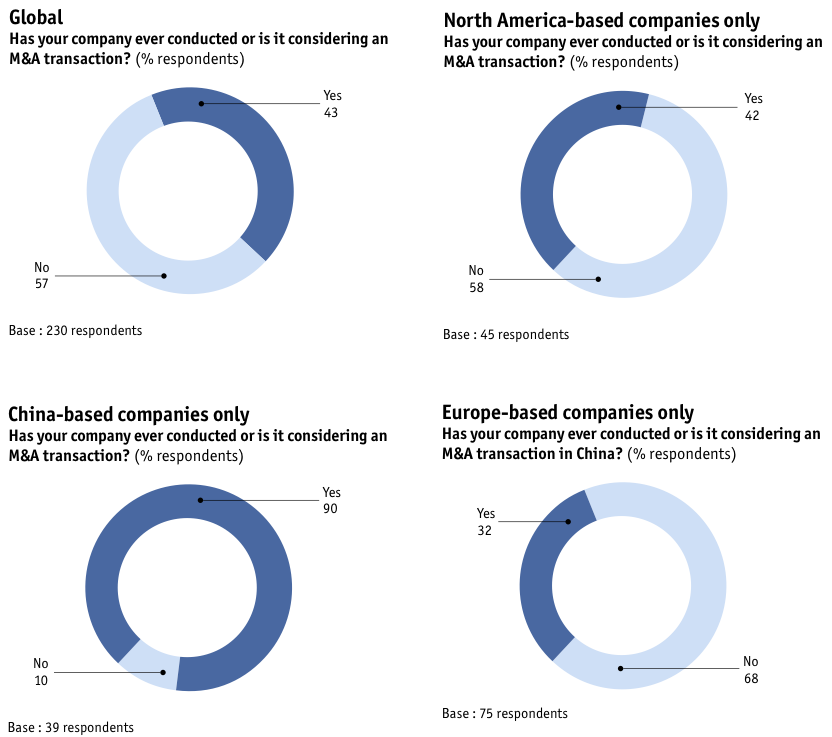
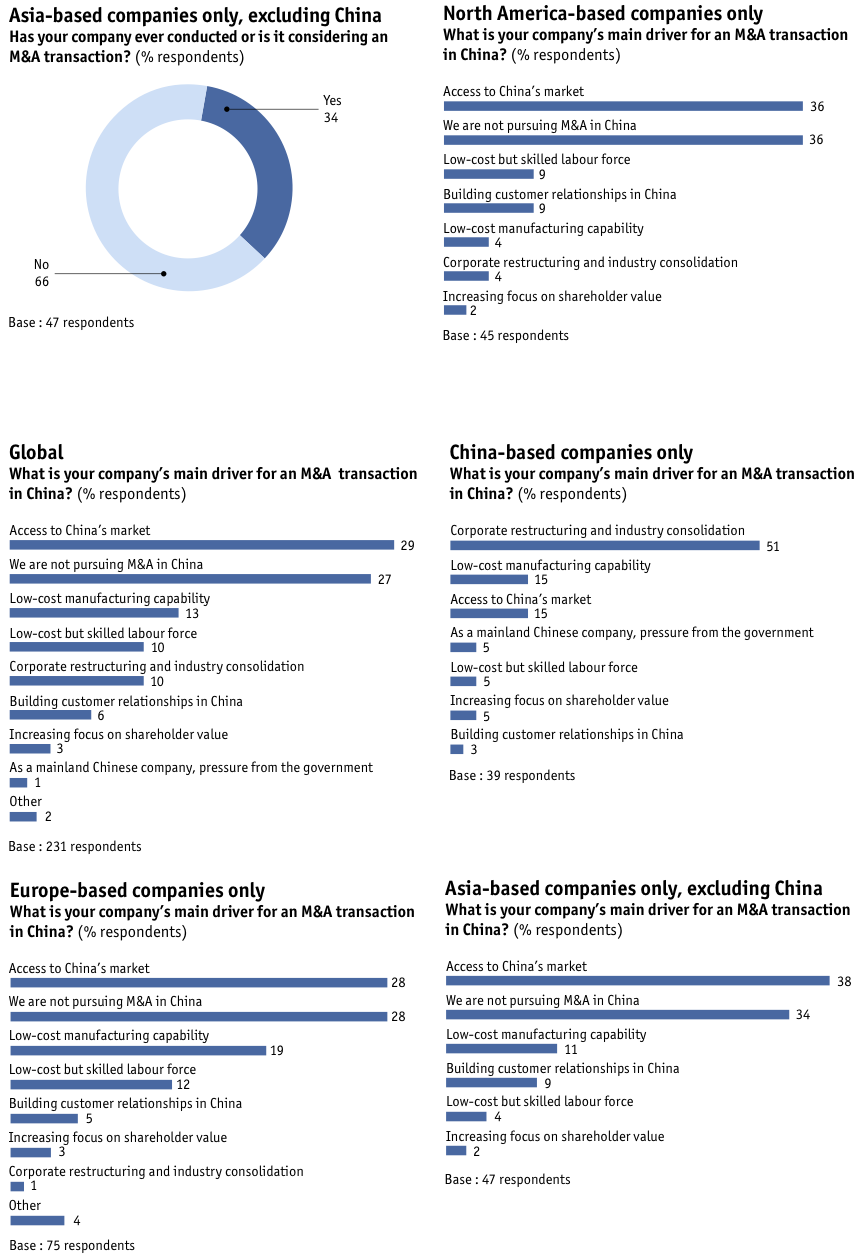
Trends in M&A activity
In the global survey, 43% of respondents agree that their company has conducted or is considering conducting an M&A deal in China. If you take out the Chinese companies from the equation, at least three out of ten respondents also answer in the affirmative. More than half expect foreign-domestic M&A in general to accelerate, particularly respondents from Europe and North America (both 69%).
Domestic-domestic M&A in China will climb even higher. An overwhelming majority of respondents from China only (90%) say their company has conducted or is considering conducting an M&A transaction. And six of ten expect domestic-domestic M&A transactions to increase. The momentum is evident in the recent merger of Focus Media and Target Media (see case study).
Why is M&A activity across the board accelerating? Access to China’s market is the key reason given by 29% of respondents to the global survey. This is also the reason cited by 38% of companies from Asia, excluding China, alone; and by 26% of respondents from North America alone. More Europeans cite low-cost manufacturing capability as an M&A driver (19%) than do respondents from North America (4%), an indication that Europe is playing catch-up with the US in using China as a cheap production base for exports. Having set up operations earlier in China, North American firms are now looking at the mainland as a market in its own right, while the relatively laggard Europeans have yet to get to this advanced stage. Among Chinese companies only, the overwhelming reason to participate in an M&A transaction is to respond to corporate restructuring and industry consolidation (51%). Government pressure is a minor driver (5%).
Focus buys Target, Framedia; Framedia does its own deals
If you can’t beat ‘em, join ‘em. That adage could certainly be applied to the decision to merge by Focus Media and Target Media. The two mainland Chinese advertising companies were fierce rivals ever since they both started out in mid-2003 to develop what they called the “out-of-home advertising network”. But on February 28th 2006 they officially joined hands—Focus Media bought Target Media for US$94m and 77m Focus Media ordinary shares, according to information filed with the US Securities and Exchange Commission. David Yu, Target’s former chief executive, was appointed co-chairman and co-president of Focus Media.
As analysts see it, the acquisition will help both companies because they can now take on others instead of each other. Even in China, famed for its massive building boom over the last decade, the number of commercial and residential buildings remains limited. Shareholders and management of Focus Media realised that two strong competitors in the limited market would mean advertisers could cut fees, while building owners could raise rents—a disastrous combination for the earnings of the fledgling companies.
So it was that after three years of intense competition, Jason Jiang, founder of Focus Media, and David Yu, founder of Target Media, agreed to merge. Focus Media’s investor relations manager, Chen Jie, says the two entrepreneurs met just three times to put their plan into action. “The merger will benefit the industry, making growth of lifestyle-media more stable,” she says, adding that absorbing Mr Yu into Focus Media gives the company another entrepreneurial senior manager to assist in strategic acquisitions that were initiated in 2005, and others that are still being planned. Ms. Chen doesn’t believe Focus Media will face any anti-monopoly problems because even after the acquisition of Target, its share of the total national advertising market is less than 1%.
The merger-and-acquisition (M&A) transaction was not without hiccups. Due diligence of Target proved a sticky issue, because Target refused to divulge all of its operational and financial issues pre-merger (perhaps prudently fearing the consequences should the M&A deal fail). Focus agreed to rely on audited financial information and market statistics provided by Target. For Focus, the risk was apparently worth taking in order to increase its market share in most cities. Post-merger, Focus will think about integration issues, but the two companies’ similar operational structures should make this a fairly straightforward exercise, says Ms Chen.
Indeed, Focus and Target have followed similar paths in their short histories, although, according to Ms Chen, Focus ended up with more market share than Target Media. In Shanghai alone, she says Focus had a 70% market share, while Target Media, the No 2 player, had 20% as of end 2005.
By late 2004, the Shanghai-based competitors both began looking at an initial public offering (IPO) as a way to obtain cash to spur the growth of their businesses. Both companies had attracted venture capital since start-up: 3i in Focus and The Carlyle Group in Target, and had restructured through opening holding companies in the British Virgin Islands and Cayman Islands in preparation.
But Focus got off the block first, listing on Nasdaq in July 2005. (The venture capitalists played a role in arranging the Focus-Target marriage, according to Wayne Tsou, Carlyle’s managing director for the Asia Growth Capital team.)
Focus Media also buys Framedia
After its IPO, Focus Media acquired two smaller competitors in southern China, and began looking at other possible strategic acquisitions. One target was Beijing-based Framedia Advertising, which specialised in placing poster frames for ads in elevators. Framedia and Focus Media had some natural synergies, and Framedia’s business model and strategy fitted in well with those of Focus Media. The latter began to court Framedia even as it wooed Target Media, eventually completing the acquisition of Framedia on January 1st 2006.
Framedia had sold its LCD-panel advertising unit to Focus in September 2004 and talks on a possible merger began at that time. Tan Zhi, Framedia’s chief executive who had bought out the founders in mid-2004, wanted to consolidate the business. Like Focus Media’s Mr Jiang and Target’s Mr Yu, Mr Tan saw opportunity in the out-of-home advertising market. He also had equity investment from Hina Capital Partners and IDG Technology Venture Investment, two US-based, China specialist venture-capital firms. Similarly, he pursued strategic acquisitions and an IPO for Framedia, while also talking with Focus Media about a tie-up.
Framedia’s total valuation was set at US$183m, and Mr Tan agreed on a US$39.6m cash payment plus shares in Focus Media as a condition for the merger. Framedia comprises a separate business unit under Focus Media, and further payments were agreed on an earn-out model based on Framedia’s projected 2006 earnings.
Mr Tan is understandably pleased with the deal—he bought into the company at a valuation of only Rmb30m (US$3.7m). Besides the acquisition price, however, he was also impressed by Jason Jiang and believed the sales-driven style of Focus Media was compatible with Framedia’s own.
Framedia made its own little deals
How did Framedia catch the attention of Focus Media? Mainly, Framedia managed to increase its valuation in only 11 months through targeted and aggressive consolidation of the advertising poster frame market. Under Mr Tan, it bought out eight of its ten competitors, in four different cities within the first five months of 2005. After identifying the targets, Mr Tan says he convinced each company of the proposed merger within four meetings — a short negotiation period. He then did basic due diligence on the companies in terms of legal and accounting practices because he “knew the companies were badly run, they had a very primitive working style”. He based the companies’ valuation on the previous year’s revenue and sales contracts in progress, and offered the owners 10% at closing and the balance six months later.
The main risk for Framedia was tax, so Mr Tan says he negotiated a transfer of sales contracts, and also asked some senior managers to leave post-acquisition because they had conflicts of interest with the business. “We did everything to international standards because we also were considering an IPO,” he says.
He adds that consolidating and integrating the employees was the most difficult task. He tackled it first during negotiations by being “open, fair and honest, and keeping the old bosses’ promises”, including paying bonuses promised by the former management. A Framedia integration team, including managers from human resources, sales and finance, were tasked with training the new employees and were given two months to complete the integration. To calm employee jitters, they were told: “If you have a past, you should have a future”. A majority of employees from the acquired companies were retained with the understanding that they would undergo a performance review every six months. After the initial six months, 80% of the original staff remained with Framedia. At the end of 2005, Framedia had 400 employees across China.
Identifying and wooing a target
The majority of executives in the global survey point to synergies with their company’s core business (53%) and the rates of return on the investment (51%) as the key factors in identifying targets. A plurality (40%) cites the prospect of the target-company improving their firms’ position in the China market. Respondents in the China-only segment also identify synergies and rates of return as important factors, but 34% of them, surprisingly, also point to low-cost manufacturing as something they would consider when identifying a company for acquisition—a characteristic cited by only two of ten respondents from firms outside China. This may reflect differences in costs between, say, an overstaffed acquirer with ageing equipment and a more efficient but smaller target-company with newer machines.
Once identified, how should be the target wooed? Six out of ten executives in the global survey say that the acquirer must build personal relationships with the key players (62%) and demonstrate that it is a committed business partner. Nearly half stress the importance of providing a solid business plan, while three out of ten say the acquirer should offer a good price— all approaches that worked for Singapore’s Asia-Pacific Resources International (APRIL) when it courted Shandong Rizhao SSYMB Pulp and Paper in 2003 (see case study on APRIL, Chapter 4).
Here’s the most interesting part. Among executives in the China-only segment, building personal relationships is much less valued as a courting technique—only 15% say this is a must—compared with providing a solid business plan, which 64% say the acquirer must do. Respondents from China also emphasise the importance of offering an enticing management buy-out package (46%), a course of action advocated by fewer than two of ten companies from North America and Asia (and just 8.2% from Europe). With due regard to the danger of making generalisations, it may be that Chinese enterprises have become more business-like and less personality-based than most foreigners realise.
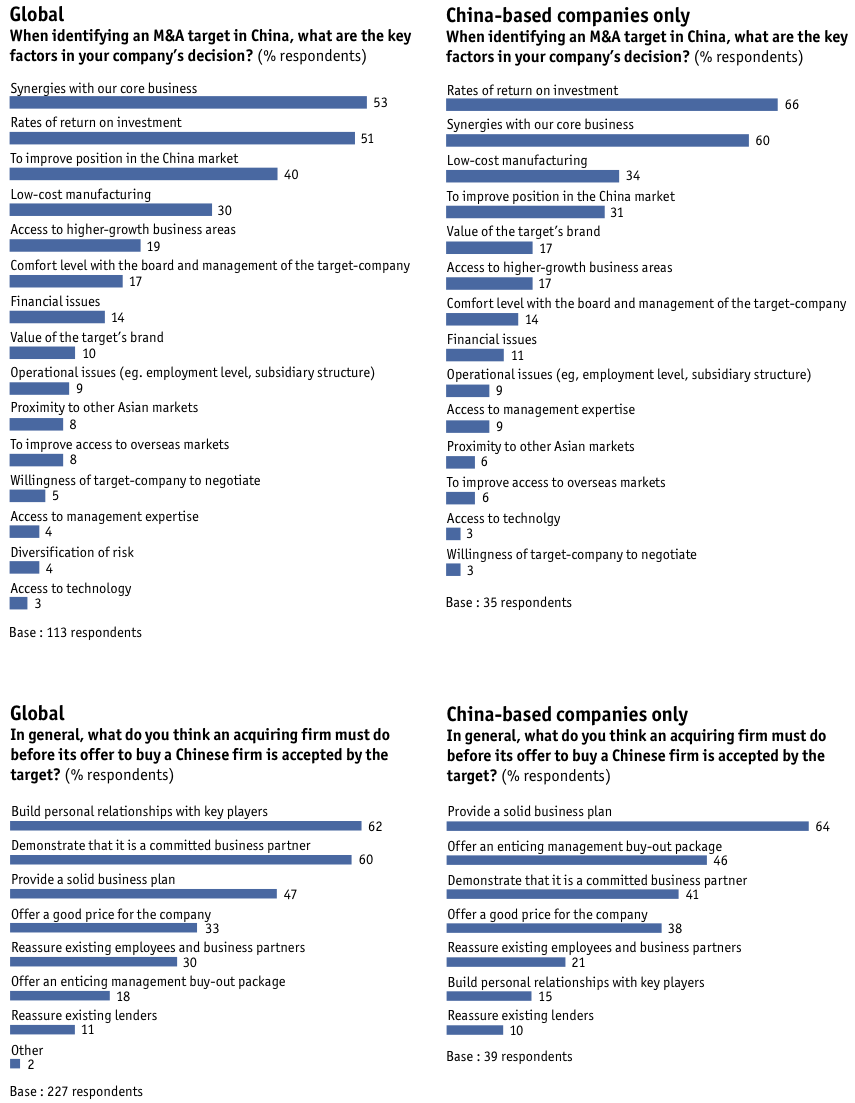
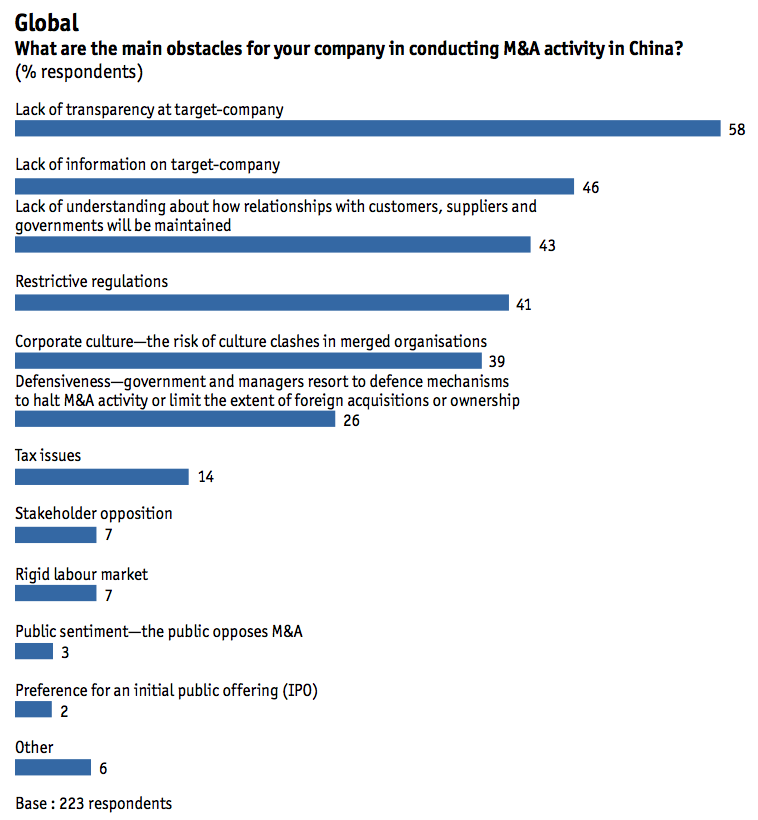
Navigating obstacles to M&A
But it isn’t easy to conduct M&A transactions in China. The main obstacles, according to the Chinese and foreign executives surveyed globally, are: lack of transparency at the target company (58%) and lack of information about it (46%). They also worry about how to maintain relationships with customers, suppliers and government authorities (43%) and the state’s restrictive regulations whether applied to foreign parties or to domestic firms (41%).
Not surprisingly, foreign companies are more worried about maintaining relationships post-M&A than are domestic firms, which after all operate in their native territory. Only 13% of respondents from the China-only segment cite this as an impediment; they are much more leery of the risk of culture clashes in merged organisations (62%). Curiously, only a third of non-Chinese respondents worry about cultural issues, suggesting that they may face serious post-integration problems later on because they seem to be underestimating this important matter.
The lack of transparency at a target-company can frustrate an acquirer, and makes it particularly imperative to run the target through the due diligence. But this is easier said than done. For executives in the global survey, the key hurdles to conducting due diligence on a company in China is simply the incomplete or inaccurate information on the target (83% say so). Then there is the target-company’s resistance on issues related to undisclosed liabilities (57%) and negative pressure from local and central authorities, which often own controlling stakes (also 57%).
Untrustworthiness of management is cited by 43% of global respondents, although it may be that the incomplete or inaccurate information complained about is due more to miscommunication and disorganised records (or lack thereof) than to a deliberate attempt to mislead. Certainly, four out of ten executives from outside China (and half of those from Europe) question the management of target companies. But mainland China respondents are more sanguine, with just 31% of respondents in the China-only segment expressing mistrust.
How best to navigate China’s dangerous M&A waters? The executives in our global survey overwhelming recognise the value of external advisors; virtually none declares never having used them. The majority say they will call on outside specialists for help on legal issues (72%) and tax matters (53%). Some welcome assistance with facilitating negotiations (44%), analysing financial issues (41%), and identifying potential targets (36%). Few see the need, however, for outside help in tackling organisational and human-resource issues.
Interestingly, the number of Asian respondents who say they need external advisors to facilitate negotiations is comparatively low (39%) compared with those who say the same in North America (59%) and Europe (46%). The Asian attitude mirrors that in the China-only segment, where only 31% of respondents say they will call on advisors to help with negotiations. Justified or not, Asian companies seem to be more confident than Westerners that their approach to the art of negotiation is more or less in sync with the way things are done in China. Some may also be sceptical of what value-added a foreigner can bring to the negotiating process, and may have issues as well with their high fees.
As for using external advisors to identify potential target-companies, few respondents from Europe say they have a need (18%). Compare this with the responses to the same question from survey respondents from North America only (50% say they use advisors to identify targets), Asia excluding China (44%) and China only (34%).
Six out of ten European respondents have no presence in China or have been operating there for five years or less, compared with just three out of ten among North American firms. As such, the European confidence about identifying targets may be the result of inexperience rather than internal ability.
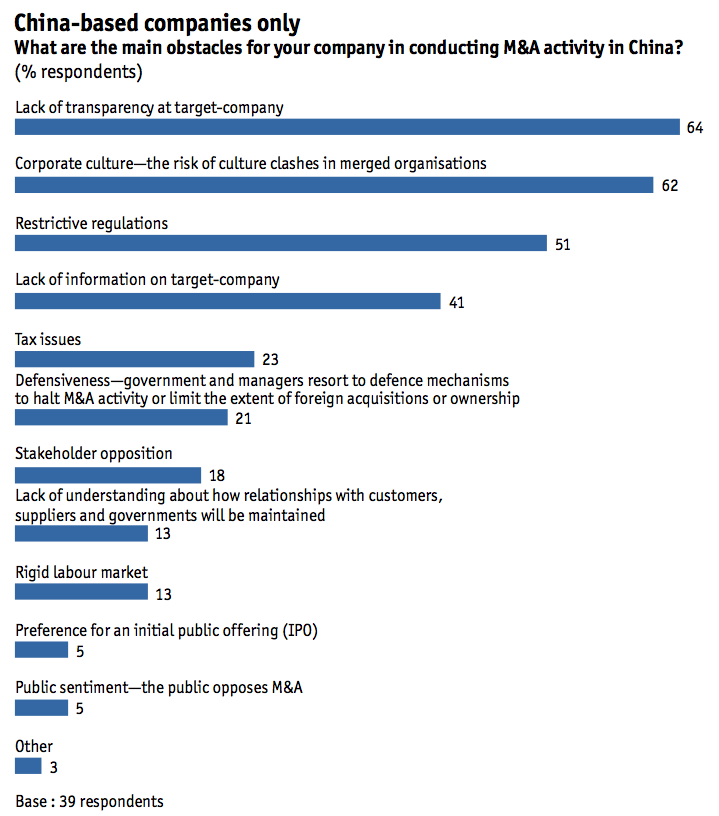
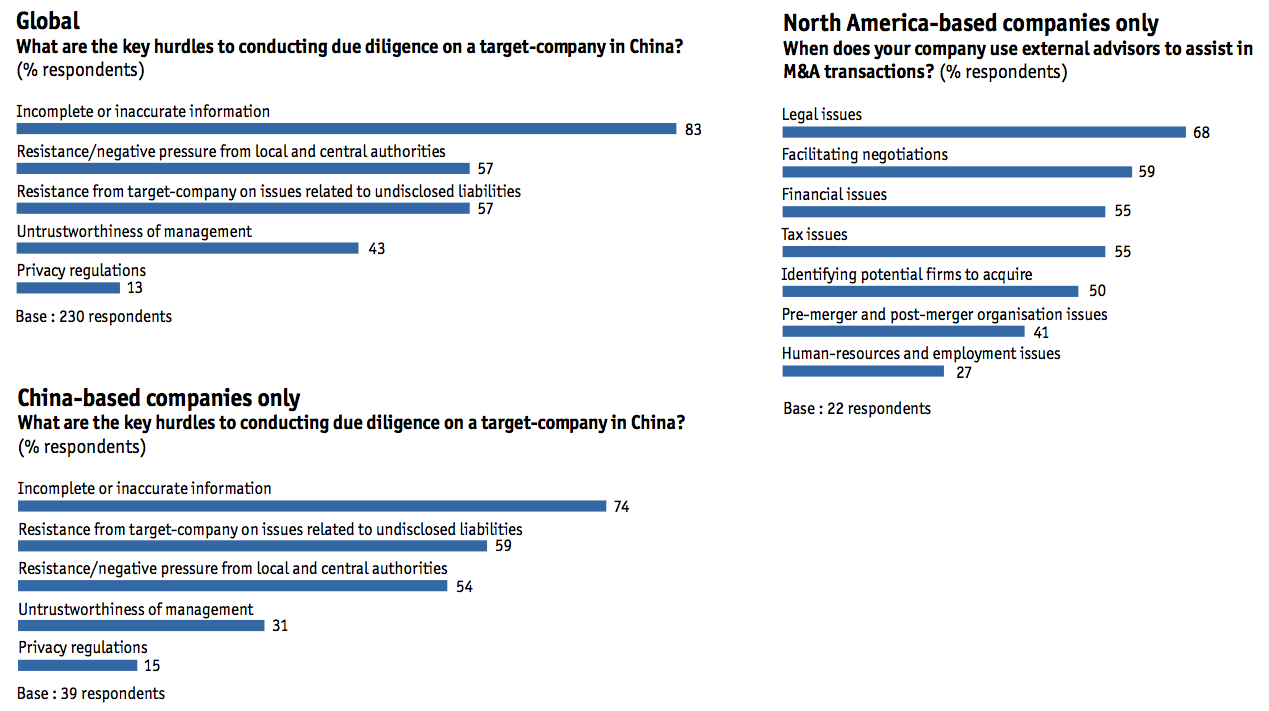
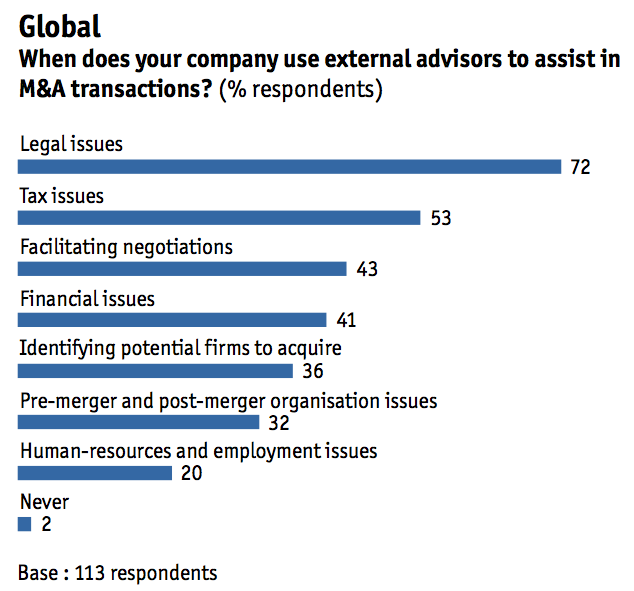

Operational issues
The differences between Chinese and foreign attitudes extend to certain M&A operational issues. For example, half of the respondents from the China-only segment judge the following as very important: integration issues, incomplete and inaccurate asset valuations, and fraudulent asset valuations. By contrast, integration issues are seen as very important by 23% of respondents from Europe, 28% of those from the rest of Asia, and 36% of those from North America. The proportion is also lower among foreigners who rate as “very important” the prevalence of incomplete, inaccurate or fraudulent asset valuations. What the majority of foreigners deem to be a very important operational issue is the difficulty of conducting due diligence on the target-company; only four out of ten China-only respondents regard this as very important.
Assuming that the Chinese respondents have more local knowledge and experience of the finances and operations of potential target-companies, foreigners may be underestimating the difficulties of post-M&A integration, which can cause serious problems down the road. They may also be attaching less importance to the possibility that the target-company will present incomplete, inaccurate and outright fraudulent asset valuations, therefore running the risk of making unpleasant discoveries after the purchase.
Another way to interpret these findings is to posit the assumption that foreigners are banking on due diligence to reveal weaknesses and problems, which is why they place the emphasis on this part of the M&A process. China-only executives, on the other hand, take it as a given that inaccuracies and outright fraud are prevalent, and therefore the acquirer should cut to the chase and not waste too much time on due diligence.
What are the most important people issues in the M&A process? In the global survey, respondents see cultural integration as critical (67% say so), followed by that perennial challenge of companies—retaining key talent (59% mention it). Leadership or management style and control are also seen as important by 56% of global respondents. There are no marked differences on these issues among China-only respondents. They also see cultural integration as critical (67% say so), followed by keeping key talent (62%), and leadership or management style and control (54%).
The need for effective communication inside and outside the new company cannot be over-emphasised. Nor can the need for integrating the business processes of the merging enterprises. The experience of Jollibee Foods of the Philippines, which acquired Shanghai’s Yonghe King in 2004, is instructive in this regard (see case study, Chapter 4).
Surprisingly, fewer than one in ten respondents to the global survey considers redundancy to be an important people issue in the M&A process. This is true in all the geographical segments, including China-only. Given the sizzling pace of China’s economic growth, especially in Shanghai, Beijing, Shenzhen and other eastern cities, it may be that workers let go after an M&A exercise can easily find other jobs, and therefore are not likely to cause trouble.
In any case, few redundancies need to be made in sunrise industries. This was made clear in the case of Jollibee Foods. The company says that it is, in fact, hiring more workers. It is a different story, of course, in deals involving overstaffed state-owned enterprises and consolidating companies in overcrowded sectors such as cars and big-city real estate. If economic growth were to slow, as some analysts forecast, many more merging companies in China may need to pay extra attention to redundancy issues.
What are the most critical success factors in the M&A process? Coping with redundancy issues clearly is not one. Cultural integration is considered important, though, by almost two-thirds of respondents to the global survey. Integrating business processes is also vital to 42% of overall respondents. The picture is somewhat similar in the North America segment (half of respondents agree) and in the Europe segment (41%), but somewhat different in the China and rest of Asia segments, where only a third of respondents regard integration of business processes as a critical success factor.
Indeed, the key success factor picked by China-only executives is the streamlining of management (39%), while firms from elsewhere in Asia choose focusing the merged company on its core competency (50%). By contrast, only one in ten of the executives surveyed from North America and Europe consider streamlining of management as critical to the success of an M&A deal. The divergence may be explained by the fact that two merging Chinese companies have their own full set of managers, while a foreigner buying a domestic firm may have only a skeleton crew in a representative office. Trimming the management ranks is therefore an imperative in a domestic-domestic M&A, but may not be much of an issue in a foreign-domestic combination.
So what are the reasons why a merged or acquired company could fail? Almost half of the respondents to the global survey blame a poor understanding of the operating environment in China. Three out of ten respondents point to the failure to achieve financial targets (31%), lack of proper due diligence of the target-company (30%), poor protection of intellectual property rights (27%), resistance and negative pressure from local and central authorities (27%) and the inability to enforce M&A agreements, particularly breach-of-contract provisions (26%). Respondents in the North America, Europe and Asia excluding China segments believe the same. Only surveyed executives in the China-only segment put a higher emphasis on failure to achieve financial targets (45% say so), followed by a poor understanding of the operating environment (42%).
In the end, however, everything is forgiven if the acquired company makes money. The overwhelming majority of the surveyed executives define the success of a merger in terms of its effect on profits (77%), followed by its effect on market share (59%), and effect on share price (37%).
There are variations. Respondents from China consider a merger’s effect on market share as a better gauge of success than effect on profits (74% versus 67%). In North America, more executives measure a merger’s success in terms of effect on share price (51%) than is the case in Europe (39%), Asia (36%), and China (31%). Asians also measure a merger’s success in terms of its effect on employee morale and motivation (43%), which is not really the case in Europe (28%), North America (27%), and indeed in China (26%).
There is one attribute in which China-only respondents are indistinguishable from their foreign counterparts. All agree that the success of a merger is measured by its effect on profits. Fully 77% of respondents in the global survey say so, as do 87% of respondents in the North America segment, 73% in Europe, 85% in Asia excluding China, and 67% in China. However, unlike the other respondents, those in the China-only segment rank effect on market share as the most important measure (74%). About four out of ten surveyed executives from China also use effect on corporate governance as a measure. Only 19% of respondents from Asia excluding China say the same, and an even fewer 13% from Europe and 11% from North America. It appears that, over time, Chinese companies may have to lower their expectations of exactly what an M&A can and cannot do.
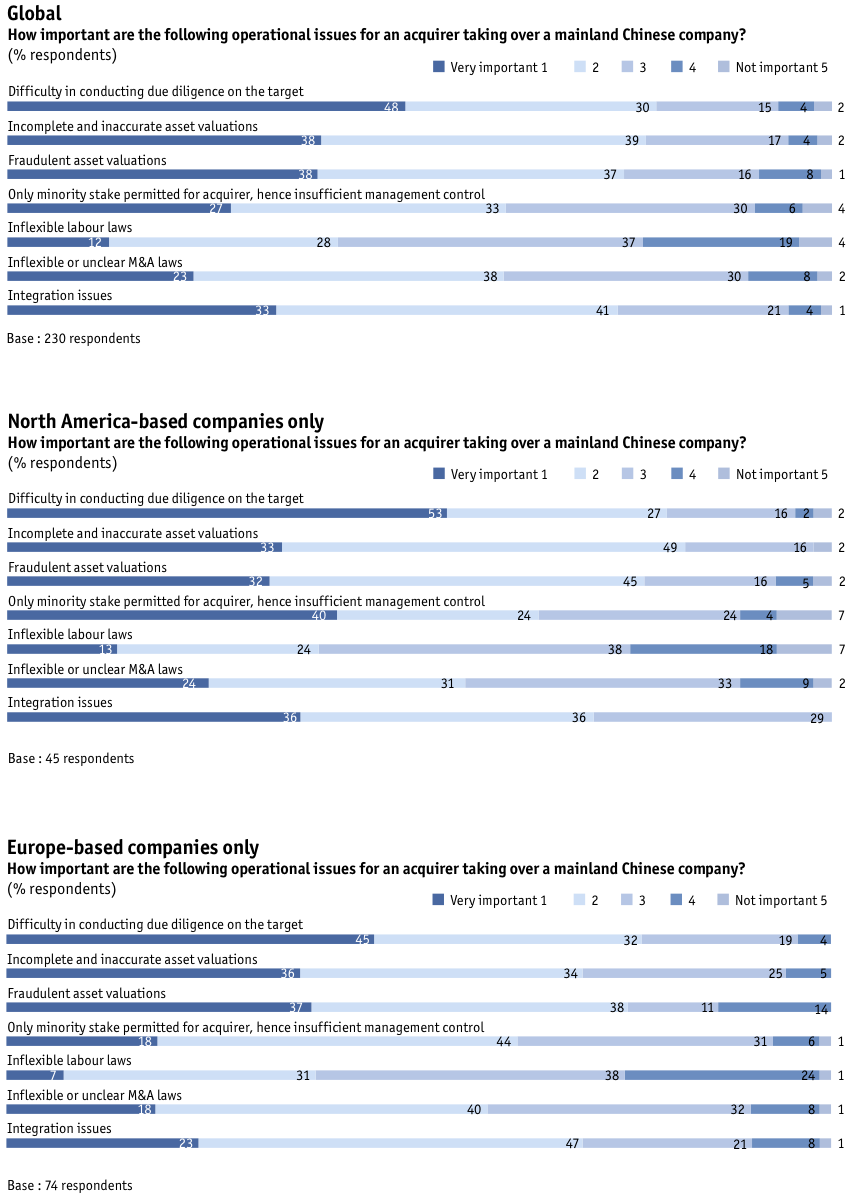
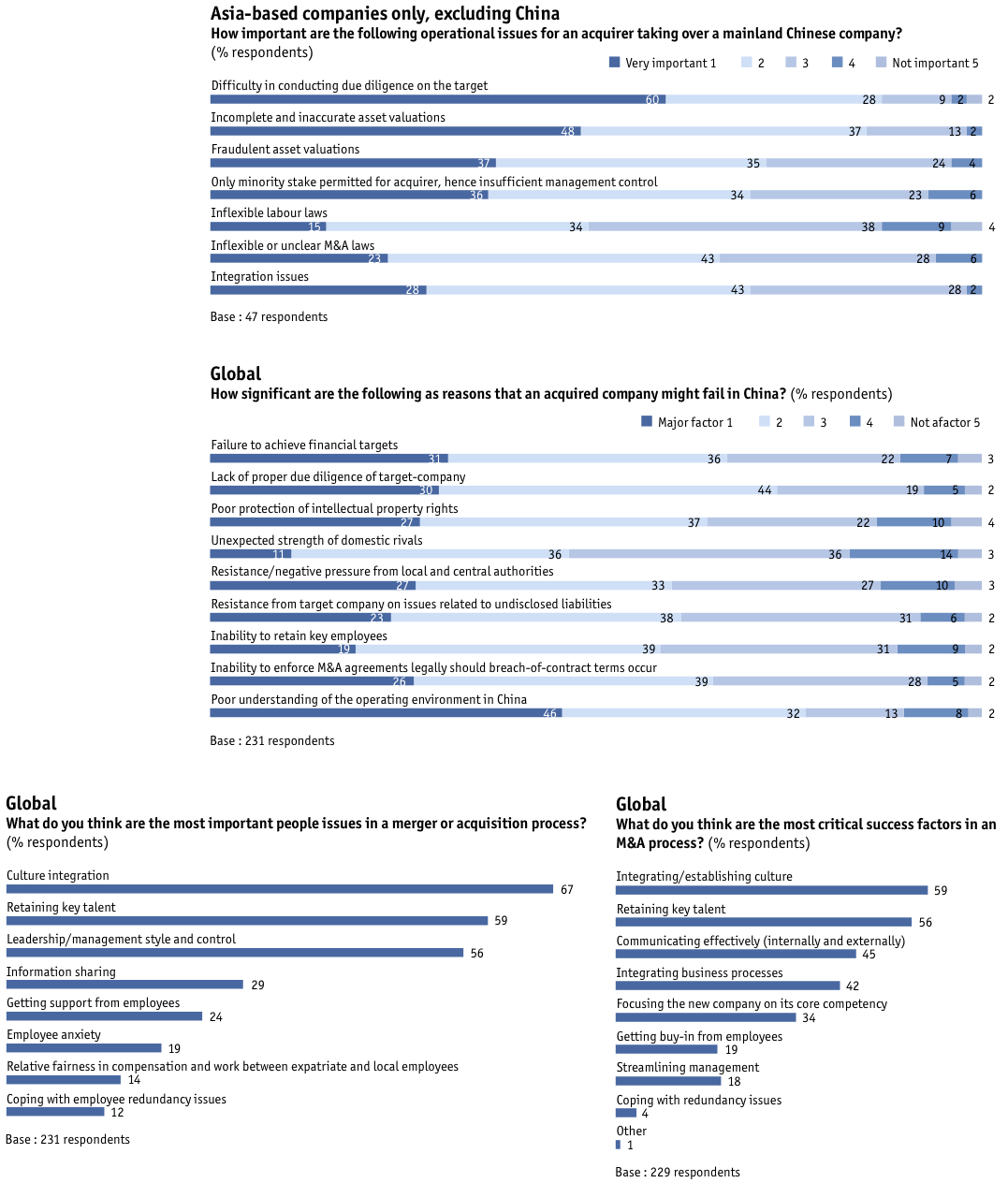

Chapter 4
Operational issues
Both foreign and Chinese companies worry in varying degrees about certain operational issues in a merger-and-acquisition (M&A) transaction. They should. According to the Economist Intelligence Unit survey, companies worldwide that are involved in M&A in China have a host of operational concerns. Post-merger integration is one, effective due diligence of target-companies is another, asset valuation a third, and there are several others. Although the procedure to conduct M&A is largely the same all over the world, there is a fine difference in certain aspects of a transaction in China that an acquirer would be wise to pay heed.
The great buy-out: M&A in China looks at the typical steps in the M&A process and how each operates in China. The following steps may not necessarily happen sequentially, and can take place in parallel:
- identification of target
- due diligence
- valuation
- negotiation
- regulatory approval
- legal issues
- integration issues
In China, identification of target, due diligence, and post-merger integration appear to cause the greatest anxiety. According to the global survey, 47% of executives interviewed complain of a lack of information about potential targets for acquiring companies. Even when a target has been identified, say six of ten respondents, lack of transparency at the target- company can present an obstacle to the M&A process.
Looking ahead to the integration phase, 46% of respondents report a lack of understanding on how relationships with suppliers, customers and government officials will be maintained after the merger, while 36% anticipate problems with the integration of corporate cultures and related issues. Despite all these worries, however, only 34% of respondents reported using external advisors for pre- and post-organisational issues.
Domestic companies are generally free to acquire or merge with another domestic entity, even a state-owned enterprise, subject to a few regulations. Foreign entities face a more complicated task in terms of gaining the requisite regulatory approvals. But they do have a variety of structuring options (see Foreign avenues).
Identification of target
Foreign-domestic M&A. For foreigners, the first step in identifying an M&A target company in China is to refer to the Catalogue for the Guidance of Foreign Investments in Industries, which sets out the industries in which foreign investment is prohibited, encouraged or restricted.
Prohibited foreign investments. This category includes the following:
- projects that endanger state security or harm the public interest
- projects that pollute the environment or endanger human health
- projects that occupy large tracts of farmland or endanger the security or efficient use of military resources
- projects that use manufacturing techniques or technologies unique to China
- projects that are prohibited under state laws and administrative regulations
Encouraged foreign investments. This category includes the following:
- projects related to new agricultural technology, construction of energy sources, transport and raw materials for industry
- projects using new or advanced technology, including those that can increase product quality, save energy and raw materials, raise economic efficiency, and alleviate shortages in the domestic market
- projects that meet international market demand, enhance product quality, open up new markets, and increase exports
- projects that involve integrated use of China’s resources or use of renewable resources, involving new technology or equipment for preventing and controlling environmental pollution
- projects that can develop the manpower and resources of central, western and northeast China.
Restricted foreign investments. This category includes the following:
- projects already developed in China, where the technology has already been imported and where capacity can meet market demand
- projects with an adverse effect on the environment and energy conservation
- projects involving exploring for and/or extracting rare or precious mineral resources
- projects in industries requiring central planning by the state
China’s accession to the World Trade Organisation in 2001 has accelerated the opening of the economy to foreign ownership. Non-Chinese can now own 100% of enterprises in retailing (in limited numbers, depending on the city), wholesaling, hotels, breweries, tyres, domestic-travel agencies in selected cities, printing of materials for packaging decoration, and certain construction projects, such as those that are beyond the capabilities of domestic firms. They will be allowed full ownership in late 2006 in insurance of large-scale commercial risks, reinsurance, and international marine, aviation and transport insurance. Foreigners can also now have majority ownership and control of medical institutions.
China has also moved on other industries. Foreigners can now own 50% of enterprises in value-added telecommunications services, including paging and provision of Internet services, and 49% in basic telecommunications services. They are also allowed up to a 50% stake in life insurance joint ventures, 49% in joint ventures in the securities industry and rail freight, 25% in aggregate in banks, with no one foreign investor owning 20%, and minority stakes in aviation, provided no single foreign investor owns more than 25%.
Domestic-domestic M&A. Understandably, local companies have the advantage in the M&A game. They are not covered by restrictions on ownership and access to industries, so they can fish for more targets in a larger ocean. They are not as deep-pocketed as foreign companies, however, particularly private-sector firms, which are less favoured by banks than are state-owned enterprises in the grant of loans. They are also covered by capital and asset restrictions under the Company Law, and like foreign enterprises, must comply with anti-trust regulations in making an M&A bid.
Trawling for targets. Only 37% of the 231 executives we surveyed globally say they use an external advisor to identify M&A targets in China, although the proportion is higher among those from North America (50%) and Asia excluding China (44%). There are few such advisors to begin with, and there seems to be considerable scepticism about what they can bring to the table. The attitude, especially among Chinese companies and foreign firms that have long operated in China, is that the acquirer can do a better job itself by using what one interviewee calls the “soft infrastructure” of business and other contacts.
But this requires a lot of hard work. “I remember when I used to do M&A searches in the US, you can just go to Lexis-Nexis,” says John Ying, managing director at Peak Capital, a private-equity firm in Hong Kong. “You can actually go to databases of pretty small companies because people need lines of credit and so on, and so they make their financials accessible. So even before you visit the company, you can have a pretty good idea not only of their financial situation and scale, but also who their five or six competitors are. This is just not possible in China.”
You may get formally reported financials in some industries, but there is no guarantee that these are either reliable or useful for M&A purposes. For example, state-owned companies typically do not report inventories or mark-to- market the value of their assets. A not-so-old joke says the boss in China keeps five sets of books: one for the tax bureau, one for the State Administration for Industry and Commerce, one for the wife, one for the mistress, and one for himself. The gibe points to a common belief among legal, accounting and risk management professionals that accounts in domestic companies do not provide a 100% accurate picture of the company.
This is why personal and business networks are very important in identifying potential M&A targets. “They really help you screen the wheat from the chaff,” says Mr Ying. Acquisitive companies can learn of leads while at banquets and cocktail parties, such as which supplier is losing market share or facing special circumstances such as an ageing founder without a successor. Other sources of information include one’s own employees and media stories. The object is not just to trawl for names, but also to get an indication of the reputation of the companies. Private-equity firms, particularly, place great importance on the integrity and honesty of managers (see The art of private-equity investing).
One option for deep-pocketed acquirers would be to look at Chinese companies listed in Hong Kong, Singapore or New York. This was the route America’s Anheuser-Busch took when it tussled with Anglo-African beer maker SABMiller for control of Hong Kong-listed Harbin Brewery. Acquiring a public company can be very expensive, of course, not least because buying a stake beyond a predetermined level automatically binds the purchaser to offer to buy the holdings of the rest of the shareholders at the same price.
Foreign avenues: types of M&A available to foreign investors
• Direct acquisition. An acquisition may, subject to prior approval, take place within China by the acquiring enterprise purchasing all or part of the non-listed equity interest of the domestic Chinese enterprise directly from one or more of the investors in the latter. Alternatively, an enterprise may be acquired by subscription to the requisite proportion of an increase in the target enterprise’s capital.
• Indirect acquisition. An acquisition may take place outside China by purchasing shares of the parent company of a Chinese enterprise listed on a stock exchange outside China’s economic jurisdiction, typically Hong Kong.
• Asset purchase. An existing or newly created foreign-invested enterprise (FIE) may purchase some or all of the business assets of a domestic Chinese enterprise.
• Debt-equity conversion. Foreign investors may acquire domestic creditors’ rights in a state-owned enterprise, enabling them later to convert such debts into equity.
• Merger. Mergers may be by absorption, in which the absorbed enterprise is dissolved and its registered capital and assets merged into the new entity; and by new establishment, in which both enterprises are dissolved and a new company established incorporating registered capital and assets from them. The foreign party in such a merger must be an established FIE.
The art of private-equity investing
Scratch a private-equity investor in China and you’ll meet an idealist. “We look for the best entrepreneur,” says Wayne Tsou, managing director at The Carlyle Group. “He needs to be capable, business-wise. He needs to have integrity, to have the same kind of philosophy as the Western investor in terms of corporate governance and compliance with international accounting standards.” Carlyle, he says, invests in managements, not companies.
John Ying, managing director at Peak Capital in Hong Kong, stresses integrity as well. “I would not say that fraud is the No 1 issue in China, but it is an issue,” he says. “On the other hand, you don’t want an incompetent, honest person, so we’re looking for someone with high integrity, someone who has energy, an entrepreneurial view of things, and could be a professional.” Adds Jamie Paton, managing director, North Asia & co-head Asia of 3i: “Trust is very important to us. Before investing, we spend a lot of time with the individuals involved to make sure our interests and theirs are aligned.”
With such high standards, the cynic might say, good luck finding companies to invest in China. Mr Tsou does say that Carlyle typically passes on every nine of ten investment opportunities it looks at. But the company still manages to find interesting Chinese firms to back, among them eBis, which supplies business hardware and software solutions to large organisations, and Target Media, an in-building interactive advertising company (see case study, Chapter 3). Carlyle has exited, and made huge gains, from three mainland companies and just recently acquired a 25% interest in state-owned China Pacific Life Insurance, the country’s third-largest life insurer.
Both 3i and Peak Capital have also acquired stakes in Chinese companies, accounting for part of the US$5.4bn in private-equity money that poured into the country last year. “We’re bringing capital into private companies,” says 3i’s Mr Paton. “Anything that’s connected to the middle class is a rapidly growing area that you want to be in. Healthcare is going to be very important because the population has more money, so they can look after themselves and also look after their elders. We believe there’s going to be a lot of interest in retail. You can roll out a chain of stores in the newer cities. Logistics is another area where there is room for private entrepreneurial companies to do well, along with media, financial services and even infrastructure, such as roads and ports.”
Mr Ying of Peak Capital adds manufacturing and technology to that list. “The new area that everyone’s looking at is energy,” he adds. “Not oil or gas exploration [which are closed to foreign investment], but emerging areas like piped natural gas to homes. It is obvious that China needs a ton of energy to grow, and whenever there is that strong a demand, by definition there is always an opportunity.”
Isn’t the field getting overcrowded, with strategic investors and private-equity money flooding into China? All three gentlemen say no. “This is a US$2.3trn economy,” Mr Ying points out. “When you have a country that big, there are tons of opportunities. Compared with the US, the number of players in private equity is still very small in both raw capital and number of players. I think saturation in China probably won’t occur in my working lifetime. You probably have a good 20 or 30 years of developing to go.”
Due diligence
The unknowns of the potential target naturally cause greater risk to an acquirer in a market where transparency and information tend to be opaque at best. In China, most professionals advise expanding the due diligence exercise beyond the basic legal and accounting framework. It should include a simple review of revenue and sales contracts, on the tax side, and verifying the company is legally registered with the State Administration for Industry and Commerce (SAIC), on the legal side, to a more thorough examination of historical tax issues, the reputation of senior management, and the company’s source of funds. If the acquirer is an American company, the target must also be in compliance with the Sarbanes Oxley Act (SOX) and the Foreign Corrupt Practices Act (FCPA).
Like company accounts, company registration details filed with the SAIC may not give the whole picture. Many professionals call the public search system antiquated. Improvements are being made in major cities such as Beijing, Shanghai, Guangzhou and Shenzhen, which are adding online, searchable company registration details to their services. Even then, the information made available is very basic, and can be suspect because the regulations governing the filing of papers with the SAIC tend to be broad and not uniformly enforced. Additionally, it is possible in certain situations for companies to fraudulently alter already filed documents.
Assessing the quality and integrity of top managers and other key employees is often done through personal contact during meetings and negotiations, an informal, unsystematic method compared with those used for the legal and financial due diligence. Dane Chamorro, China deputy country manager for risk management consultancy Control Risks Group (Shanghai), says that often “acquirers focus less on ethics and internal-control issues than legal and tax due diligence. [The acquirers] think things will change after the deal is completed, but they don’t”.
One informal tactic used by many business managers is to ask for information about the target from suppliers, customers, competitors and even local government officials. While this may be fine for the relatively simple task of identifying targets, such informal investigations have built-in disadvantages as a definitive way of judging reputation. For one, the individuals may regard the potential M&A deal from their vested-interest point of view and may not be completely candid with the buyer.
Hiring a due diligence specialist provides another point of view from which the acquirer can assess the target. A due diligence report focusing on senior management’s reputation, source of funds and business ethics conducted by a consultant specialising in the process can pinpoint issues the buyer’s business development managers could not broach with the target, or pull out valuable observations from stakeholders using a pretext approach. At the least, the buyer can attempt to avoid nasty surprises after the acquisition, and some findings may be useful in the valuation and negotiation stages.
This applies to tax issues as well. Ernst & Young, an accounting firm, has put together a list of some of the popular ways that companies in China use to under-report their tax liabilities (see Six ways the taxman is cheated). The would-be buyer must be sure it knows what the target’s contingent tax liabilities really are because the potential penalties, post-merger, can be as high as five times the tax payable, along with a surcharge of 0.05% per day on that amount. “And those responsible for the under-reporting of tax in China are subject to criminal prosecution,” warns Ernst & Young, “the penalties for which in certain cases, including in particular [value-added tax] fraud, go beyond prolonged imprisonment.” The purchaser must also know the impact on earnings if the target-company were paying taxes in full.
One way to take a short cut with regard to due diligence is to target Chinese companies with a private-equity investment. “I have to commend Baring Private Equity for trying its best to bring the accounting information to a level of integrity that is acceptable,” says Ysmael Baysa, chief financial officer of Philippine fast-food company Jollibee, which acquired 85% of Shanghai’s Yonghe King (see case study). “Frankly, we were impressed by the quality of Yonghe’s accounting information.” The downside for the larger strategic investors is that private-equity-backed companies are typically small, so doing an M&A with them may not be attractive. The private-equity firm would also be pricing the asset as high as it could.
What about due diligence of human resources? Companies would probe a target for legal, financial and business issues, and see this as a necessary step in the M&A proceedings. But they rarely bothered to review the target’s human-resources. However, of late there is a growing awareness of the need for human-resources due diligence in order to clarify financial risks, to elucidate the strengths and weaknesses of the target’s human resources, and to identify potential human-resource issues for integration. Companies may use all or parts of these services and in some cases rely on the auditor to cover some of the financial-related human-resources issues.
Clarifying financial risks is the reason most companies conduct human-resources due diligence. The aim is to examine apparent and potential financial risks such as pension liability, total compensation costs, or total benefit- related costs. These liabilities are useful in deal-price negotiation.
The second objective, to clarify the strength and weakness of a target’s human resources, is basic. This can be done by creating a Human Capital Portfolio that maps employees from the perspective of cost (total compensation) and competence. The latter is evaluated by the size of a job or position and performance data at an early stage of negotiations, when access to employees is limited. It would be evaluated again at a later stage when access to employees is easier, and would include assessment data. A Human Capital Portfolio indicates whether employees’ total compensations match their jobs/performances. Those who are overpaid will be earmarked for reshuffling to other jobs or for being let go. On the other hand, those who are underpaid or are high performers will be earmarked for retention. A Human Capital Portfolio can be an early indication of deal breakers and a guiding tool for a successful integration. An acquirer also needs to know a target’s overall human-resources management on issues such as evaluation and reward. These are issues that are not clarified by merely exchanging human-resources documents—they require deeper analysis through diligence.
The third objective of human-resources due diligence is to identify issues for integration. As the survey results reveal, cultural integration is a major success factor in an M&A transaction. Company “culture” is defined as the aggregation of individual behaviours which make up how work gets done. It is about how a business result is achieved by the behaviours of people, and the drivers that are most likely to produce these desired behaviours. It is very important to know at an early stage whether the desired outcome is likely to produced by people, and what changes are required.
Six ways the taxman is cheated
• Delays in revenue recognition. Sales are recognised and invoices for value-added tax (VAT) are issued only when the cash is actually received, usually several months after the goods were delivered or the services were rendered. The obligation is to delay the obligation to pay VAT or Business Tax.
• Failure to recognise income. Cash sales and other income are not recorded in the statutory books and records, while expenses that were not actually incurred would be recorded. The objective is to avoid paying VAT or Business Tax and Corporate Income Tax.
• Misapplication of tax holidays. A holiday is obtained to which the entity is not strictly entitled, typically through an informal arrangement with the tax authorities. Income and expenses may also be booked in advance or deferred so they can be recognised during a tax holiday year.
• Under-reporting of individual income on behalf of employees. Because individual income tax rates and level of social security contributions are high, employees may be paid more than what is actually reported, a practice that can present complications to an acquirer that wants to be fully tax-compliant.
• Related-party transactions. One example is transfer pricing, in which the company sells goods at or just above cost to an offshore related party or related Chinese entity with a tax holiday or preferential tax rate, which then sells the goods to the end customer at a hefty margin.
• VAT exports. Imported materials used for production of exports are exempt from VAT, so a company using these materials for domestic sales production make it appear that its products are for exports.
Manila’s Jollibee serves Chinese food
Ysmael Baysa, chief financial officer at Jollibee Foods, still remembers that first meeting in early 2004. The US$710m-a- year Philippine transnational had just bought Yonghe King, a mainland Chinese fast-food noodle chain, and senior Filipino executives were getting to know their counterparts in Shanghai. “There were long periods of silence,” recalls Mr Baysa, who was previously finance director at US multinational company Procter & Gamble in the Philippines, Malaysia and Singapore. “They were not used to being consulted, to be asked to disclose problems and propose solutions. They were used to being told what to do.”
Heavily influenced by the US, which ruled the Philippines in the 19th century, many Philippine companies adopt Western ways of management. Jollibee likes to operate from the bottom up, a mindset it wants to inculcate in Yonghe King. “It’s taking some time,” Mr Baysa admits. “They are very sensitive about offending their bosses and other people in the room. They needed a period of adjustment to figure out that they will not be penalised for speaking up. Nowadays it’s different. They are not as open as Filipinos, but you can expect them to express what they feel the company should do.”
People issues
Not that Yonghe King was doing badly under its previous management. Founded in 1995 by Taiwan investors, the noodle enterprise enjoyed investment support from Baring Private Equity Partners and had grown into a 77-outlet chain in ten cities by the time Jollibee bought 85% for US$22.5m. Controlling shareholder Baring sold all its shares, but husband-and-wife founders Steven Lin Yu Au and Michelle Lee Yu Lin kept some of theirs. Both remain directors at the new Yonghe, although Mr Lin has vacated his post as president to become chairman, allowing Jollibee to put in his place Jeffrey Chao, who used to run McDonald’s restaurants in Taiwan and oversee Kentucky Fried Chicken stores in China.
Jollibee also parachuted in a Filipino chief financial officer (CFO) because Yonghe had no one exercising modern CFO functions such as business analytics, performance management and decision support.
Still, the management team and workforce were kept intact. “There were no firings, although some managers resigned to pursue other opportunities,” says Mr Baysa. “In fact, we actually hired more people.”
New local recruits now head marketing, operations, network development, research and development, and other departments that were previously understaffed or non-existent. Yonghe has opened 24 new restaurants since the takeover; the target is to expand to 1,000 outlets China-wide by 2011.
Some of the hiring is being done ahead of schedule, resulting in higher overheads than programmed in the feasibility study. “We were planning on hiring a marketing manager only in 2007, when we anticipated that the business would need one,” says Mr Baysa. “But we felt we need to improve our understanding of the Chinese consumer, improve Yonghe products and the efficiency of operations faster than planned.” The tight labour market was another spur. “It’s very difficult to find the right talent in China. There are many workers, but high-level management and technical skills are rare commodities. If we wait too long, we might not get the kind of people we want.”
The next challenge is to keep the workforce happy and motivated. “First, we give them competitive compensation. That’s increasing our overheads even more, but you have to bite the bullet,” says Mr Baysa. “Second, and equally important, we constantly articulate our vision of what we want to become in China. Our new hires are achievers; they are not only after compensation. They want to belong to an organisation they can be proud of, a company that will become big and prestigious in China. It’s really important that they are fired by excitement in joining a group called Jollibee that has high ambitions in Asia.”
Lessons learned
It helps that Jollibee is an Asian company with Chinese characteristics (founder Tony Tan Caktiong is Filipino-Chinese), one that understands and practises the art of cultivating personal ties within and outside the firm, and appreciates the importance of giving face.
As a private-sector company, Yonghe has also been run from the beginning as a profit-oriented business, so Jollibee did not really need to deal with problems associated with state-owned enterprises, such as poor customer service. The aforementioned reluctance to be forthcoming with opinions is one of the few people problems.
But looking back, Mr Baysa says Jollibee could have done some things differently, primarily the pace of reform at Yonghe. “We were afraid that if we made so many changes, we might damage a business that was, after all, comfortably generating cash flow,” he explains. “We did not want to interfere too much. But what we have found out is that we have been more careful than necessary. The problems we thought we would encounter were the problems we did meet, and the solutions that worked in the Philippines are also working in China. And our Chinese employees are more willing to learn and change than we expected them to be. We can actually do much more than we thought we could.”
There are areas where the Filipinos defer to Yonghe, particularly in external matters such as dealing with the government, applying and renewing business licences, and relations with franchisees. But in general, Jollibee is finding that operational matters such as taste preferences are remarkably similar in the Philippines and China. Indeed, Yonghe managers have suggested introducing Jollibee’s hamburgers in select Chinese cities. Jollibee once had a presence in Xiamen, but it closed the burger outlets because of poor performance. Perhaps it will have better luck this time around with Yonghe’s help.
Valuation
If the due diligence does not turn up fatal flaws, the two parties may proceed to the issue of money. How much should the acquirer pay? Arriving at the “right price” is a major undertaking in an M&A transaction in any market, but none more so than in China. Target-companies have been known to set a price based on asset replacement value — how much it would cost today to replace what the company bought years and years ago — plus a premium. A good appraiser is almost as important as a good lawyer in this case, says James Chen, founder of Holly High Capital, a Beijing-based boutique investment firm.
He recalls the value that Fujian Shuijing Beer put on itself, which came to 80 times earnings. Fortunately, Belgian brewer InBev (formerly known as Interbrew) bought the stake. An equity investor would have balked, but a strategic investor like InBev looks not only at the target company’s intrinsic worth as a going concern, but also at its synergies with its other properties in China and elsewhere, its scarcity value, and even the cost to it down the road if a competitor were to buy the company. An added complication, when it comes to state-owned companies, is that the asset must be appraised by the relevant state agencies, which are tasked with making sure the target-company is not sold at fire sale prices.
Buying private-sector companies is in some ways easier because the state is not involved as an owner, but the valuation can be equally tricky because of the founding entrepreneur’s understandably high estimate of what his life’s work is worth. The preferred valuation is to value the target company as a going concern and avoid getting bogged down in discussion over land rights, property and equipment, brand value and so on. The question to ask: where is the company now in relation to its peers, and where will it be next year, in three years, in five years, given the trends in its industry, its business model, quality of management, earning power, the state of its cash flows and balance sheet? If the company or its peers are listed, the stock market price can provide a baseline.
What if the due diligence reveals tax evasion and other irregularities? A private-equity firm will often simply walk away, but a strategic investor may consider taking a risk if the prize is important to its overall strategy in China. In this case, it can propose to buy selected assets of the target company, not the enterprise as a whole. “An asset acquisition is cleaner,” says Herbert Smith’s Brinton Scott, because the buyer can then protect its reputation and shield itself from future legal and other liabilities. But there are tax implications on such asset transfers, and considerable delays in completing the deal because of the need to form new entities and obtain new licences.
If the M&A deal is structured as a purchase of equity, one popular option is to stagger the payments over several years, allowing the purchaser some leverage in case problems are found post-acquisition. Warranties and indemnities may be incorporated in the agreement to cover such eventualities, but the acquirer will then have to run after the seller if the total amount had already been paid. Another practice is to structure part of the compensation as a performance bonus, as Jollibee Foods did. It agreed to pay the founders of Yonghe King US$22.5m, of which US$11m was to be paid in three years’ time, and only if certain performance targets were met. Founding entrepreneurs are typically very confident of their company’s prospects, and therefore often agree to very high targets.
Negotiation
When talking to acquirers and targets, the word “respect” comes up many times in the course of discussions about the negotiation process. “Equality is the main principle,” says Zhang Jianwei, president of transportation powerhouse Sinotrans. “Regardless of the size of the company, the negotiator must give respect to the managers.” Holly High’s Mr Chen cites an old Chinese saying that a person will get three times the reward by offering respect to another. Tan Zhi, chairman of Shanghai Framedia Advertisement Development, negotiated the acquisition of eight competitors (see case study, Chapter 3). He says he never used the word “acquisition”, which has negative connotations in Chinese, but referred instead to “our merger” or “our co-operation”.
The concept of respect applies not just to the chief executive, but to all stakeholders the acquirer must win over to complete the deal. In many cases, stakeholders are key employees who the buyer wants to keep on the team post-merger or post-acquisition. The tone of the meetings with these managers and stakeholders can colour negotiations and morale going forward.
Respondents to the Economist Intelligence Unit global survey comment that building personal relationships with key players (66%) is critical to the target accepting an acquirer’s offer. Interestingly, the more subjective personal relationships are followed by more business- savvy assessments like showing the target that the acquirer is a committed business partner (61%) and providing a solid business plan (46%). Price is accorded only fourth place in importance (33%).
For US-based companies and foreign firms listed in the US or with subsidiaries there, the negotiations must be conducted in such a way as to avoid violating the FCPA. Outright bribery of regulators and company managers is a clear-cut case, but what about throwing a banquet where regulators are invited? You can hardly attend a business function in Beijing or Shanghai and not rub shoulders with government mandarins, so involved is the state in commerce as owner, shareholder, manager and regulator. Then there is the question of tea money and gifts, seen in China as nothing more than courtesies, but which can be interpreted as something else in the US. The assumption is that the value of these give-aways would be a determinant, although this has not yet been tested in US courts.
Crossed objectives can make negotiations lengthy and frustrating. Chinese industries that have been opened to foreign investment change rapidly and the definition of a good deal or a good business plan can change within months. For example, Paris-based Inergy Automotive Systems’ attempted acquisition of Yangzhou Auto Plastic Products (YAPP) failed despite three years of negotiations and a signed Memorandum of Understanding due to changes in the market, which allowed YAPP to consider alternative development plans (see case study, Chapter 2).
Managing the expectation of the target-company’s employees and executives can also prove a slippery slope during negotiations and post-acquisition. Communication is the key, so say 45% of our global survey respondents, to understanding expectations ahead of time. The target state-owned enterprise (SOE) may be focusing on employment numbers, while the acquirer may be counting on cutting positions for instant profitability. Another common scenario involves one party expecting instant globalisation of management skills and technology, while the other party wants to take a slow-but-sure approach.
Negotiation methods vary. It took Mr Tan of Framedia no more than four meetings in negotiating his company’s eight acquisitions using the straightforward approach—tell me what you want, this is what I can give, let’s compromise. On the other hand, negotiations between big multinationals and equally large Chinese domestic companies can drag on for years as the two sides keep an eye out for other acquirers and targets and changes in the foreign ownerships and regulatory regime. The “clean team” method to deal with post-deal integration is just making its way into China’s negotiation methodology (see section on Integration issues).
Negotiation with the target makes up one step. Closing the deal is a different story.
Respondents to our global survey considered access to the right people in government (68%) and understanding local laws and regulations (66%) as critical to closing success. Naturally, legal counsel becomes involved in all aspects of negotiations, particularly in discussions involving local, provincial and possibly central government bodies such as the Ministry of Commerce and SAIC, whose workings can be ambiguous and intimidating even for domestic companies.
Regulatory approval
Often, the two parties start the regulatory approval process early in the negotiations, even if there is no guarantee that the talks would bear fruit. Just getting to know what approvals are needed, let alone getting those approvals, can take months or even years. “We had one deal where our clients were getting a concession to operate a toll road,” recounts Kevin Roy, a New York attorney with Herbert Smith in Hong Kong. “We had to contend with a whole range of approvals from different entities, including for advertising on the billboards and for the operation of the rest stops.”
No wonder nearly three-fourths of our global survey respondents (72%) say that their company uses external advisors to assist in the thicket of legal issues surrounding an M&A transaction. The preference is to hire mainland Chinese lawyers who have the knowledge and often the personal contacts to negotiate the muddy regulatory waters. They may work under the direction of the acquiring company’s own lawyers and the external legal firm it has retained. “No government anywhere is model perfect,” says Mr Roy. “Particularly in China, you have different entities and different agendas. The approval of one agency may not be indicative of the action other entities may take.”
His advice is to get “an informal pre-clearance prior to doing too much on a deal, especially where the transaction is innovative or broader than what is normally permitted. This means talking informally and brainstorming with the appropriate regulators to minimise the risk of an unpleasant surprise in the end.” How politically sensitive is this deal going to be? How socially sensitive? How economically sensitive? The point, says Mr Roy, is to “try to get an idea of what the regulatory obstacles are going to be up front. This can both enhance the likelihood of ultimate success and keep unexpected delays to a minimum.” If the deal is in a sensitive industry like banking or financial services, the informal talk can be on a no-names basis.
Foreign-domestic M&A. For foreign companies and wholly owned foreign enterprises (WOFEs) in China, a perusal of the Catalogue for the Guidance of Foreign Investment in Industries quickly leads to further research regarding industry, financial, environmental, labour and safety regulations. All M&A deals need the go-ahead from the Ministry of Commerce and the relevant level of SAIC. Depending on the industry, investment vehicle and the target company, approvals may also be required from the local government, the State Administration for Foreign Exchange, and industry watchdogs or ministries. For example, insurance companies need approvals and licences from the China Insurance Regulatory Commission while telecom players require the nod from the Ministry of Information Industry.
The requirements do not pertain only to nationality and ownership levels. In the finance industry, for example, qualified foreign entities should command high-quality assets, with a capital adequacy ratio higher than 8% and total assets of over US$10bn. The minimum asset qualifications for qualified foreign insurance enterprises is US$5bn. Foreign steel companies looking to acquire domestic enterprises should have annual output of 10m tons of general steel or 1m tons of specialised steel, as well as their own proprietary technology. They must also satisfy strict requirements on environmental protection, energy saving, scale enlargement and technology upgrading.
Under the Provisional Rules on the Merger and Acquisition of Domestic Enterprises by Foreign Investors, effective in 2003, a foreign company or WOFE can acquire the non-tradable shares of state-owned enterprises, but must obtain approval from the State-owned Assets Supervision and Administration Commission (SASAC) and local governments. These shares are in companies carved out of the SOE and then listed in China and elsewhere, usually in Hong Kong. However, foreign entities are not yet allowed to buy holdings directly owned by the state.
Domestic-domestic M&A. For domestic companies, M&A limitations are largely based on capital and asset restrictions. According to the Chinese Company Law, domestic companies, aside from holding and investment companies, cannot participate in investments worth over 50% their net assets (audited as of end of previous year). Holding and investment companies should have registered capital over Rmb30m and obtain a licence from the relevant authority.
Domestic companies seeking to acquire the assets of an SOE are also governed by specific regulations. Transactions should be approved by SASAC (the ultimate shareholders of the companies). If given the go-ahead, these deals would not require a public tender. For an M&A involving a provincial or townships enterprise or asset, the approval should come from the relevant local governments, and the transaction should be conducted via an asset transaction centre after a public tender.
There are ways for local governments and the enterprise to skirt these last requirements. They can categorise the transaction as part of liability restructuring or state-owned enterprise restructuring, for example, rather than an M&A. The regulations can also be bypassed if only one purchaser is making a bid, an exception that creates loopholes for local governments and would-be acquirers to exploit.
Legal issues
When the two parties have agreed on the valuation and major outlines of the deal, the lawyers sit down and hammer out the details. A well-crafted and enforceable contract that reflects the wishes of both parties is essential in an evolving market like China, where some commercial laws are ambiguous or conflicting and where a new regulation can change previous ones in unforeseen ways.
Mr Roy of Herbert Smith says China’s commercial legal system has actually improved in the past few years. He calls the 2003 Provisional Rules on the Mergers with and Acquisitions of Domestic Enterprises by Foreign Investors a “watershed”. Before this, he says, “there wasn’t really a coherent set of rules for people to look to”. But being new, these laws have yet to be tested in court. And the judicial system is not yet fully mature to objectively adjudicate commercial disputes arising from M&A transactions. Outside of Beijing and Shanghai, court proceedings and judgments are often spotty, at best.
The key legal issue is enforceability. True, most in China would do everything to keep disputes within the company. “Personally, from my experience with Chinese over 15 years, the last thing that comes to their mind is to go to court,” says AJ Devanesan, president of Singapore’s Asia Pacific Resources International Holdings (APRIL), which has acquired a Chinese pulp and paper company (see case study). “That’s more the Western way. The Asian way is to settle the problem among ourselves.” But where the stakes are high, as in cross-border deals, the acquirer, no less than the target, has an obligation to shareholders to make sure the contract is enforceable.
Graeme Johnston, author of The Conflict of Laws in Hong Kong and a partner specialising in dispute resolution at Herbert Smith in Shanghai, stresses the importance of a dispute settlement clause. “Your basic choice is between court resolution and arbitration,” he says. “Court resolution often isn’t very attractive to foreign investors for two main reasons. The first is that they tend, rightly or wrongly, to be sceptical of the domestic Chinese court system. The second factor is that litigating outside China against a party whose only assets are in China usually isn’t a very good option because China doesn’t predictably enforce other countries’ judgments. So you’re left with arbitration, but you’ve got to find a venue and rules that both sides are comfortable with.”
Mr Johnston says, however, that onshore arbitration under the auspices of the China International Economic and Trade Arbitration Commission (CIETAC) is making great strides. A government-sponsored body but with considerable operational independence, CIETAC introduced significant reforms a year ago, allowing, for example, greater choice of arbitrators (including non-Chinese arbitrators), and greater scope for a more thorough testing of evidence, though Mr Johnston cautions that it is important to address such matters specifically in the arbitration clause. “If you’re comfortable with CIETAC,” he says, “it can in some cases prove more straightforward in practice to enforce CIETAC arbitration awards in China than it is to enforce foreign awards.”
One other important legal issue is the question of how specific a contract should be. The Chinese approach tends towards the non-common law tradition, in which the courts are expected to fill in the gaps, rather than the Anglo-American tradition, where every little detail is specified at great depth. The temptation is to defer to the Chinese way just to get the deal done fast. But it’s always better to have it in black-and-white.
Integration issues
What about the morning after? When the ink dries on the agreement and the new management takes over, the post-integration blues may begin. The Economist Intelligence Unit global survey shows that a majority of respondents say the leading reasons for post-deal problems are integration issues related to corporate culture integration, retention of talent, and communication issues.
This is a universal and persistent problem. Often it’s not just a question of integration, per se, but also the speed with which it is done. Some value is always lost as early as immediately after a deal announcement is made, quantified in several studiestobeaslowas10%toashighas50%of organisational productivity or performance. In a typical M&A scenario, employees feel insecure and spend most of their time speculating about what would happen to them. Others jump ship, taking their experience, skills and even customers with them. Several months pass by after the deal is closed, but plans for integrating the two operations are still being developed. The benefits of the deal, much ballyhooed in the press and communicated to shareholders, are nowhere in sight.
Ideally, integration plans should be ready for implementation as soon as the deal is closed. But this is not always possible in the US and the European Union, where antitrust laws forbid acquiring companies and their targets to share competitive information prior to the completion of an M&A transaction. However, this is not yet the case in China, which has yet to adopt a draft Anti-Monopoly Law (AML). “The AML outlines broad concepts on prohibited monopolistic activities, but does not offer details on whether pre-merger activities may raise antitrust issues. Nevertheless, China’s competition law regulatory agency—which has yet to be created—ultimately will have broad authority to implement the general concepts in the AML. How the law will be interpreted, applied, and enforced remains unclear,” says a recent report by Mercer Human Resource Consulting.
Attending to integration details long before the deal’s consummation is particularly important in China, especially when the acquirer is a foreign company. China’s labour laws and historical focus on a holistic approach to employee management (sometimes including housing, crèches and preschools, gifts at holidays, training schemes), can leave employees feeling left out if the acquirer minimises benefits to the letter of the law, or even less. The matter warrants a culturally sensitive and creative approach. The earlier the foreign acquirer assures the employees of the target-company that it will respect this tradition, the more likely integration will proceed smoothly.
• Redundancy. However, one interesting finding of our survey (see Chapter 3) is that only 12% of the total respondents consider redundancy to be a major people problem in a China M&A. This is true among the surveyed executives from China and Asia (both 15%), North America and Europe (both 9%). One reason for this is that, in many M&A agreements, the target-company is obligated to clean up the rolls before the handover, and the cost of the redundancies would have been factored into the selling price.
Another reason is that, contrary to popular perception, says Holly High’s Mr Chen, making redundancies in China is in fact much easier than it is in Western countries. The cost and timing are relatively smaller and shorter in China. He relates the case of one client that took over a year to negotiate redundancies with a company the client wanted to acquire in a Western country. “Only the big players can afford to lay people off in Western countries,” observes Mr Chen.
For APRIL, for example, it was a relatively simple matter to let go of some 200 workers after it took over Shandong Rizhao Pulp and Paper. What the company did was to coordinate closely with the local authorities and to offer retraining to those who wanted a second chance. “They were temporary workers who we felt were not required,” says Mr Devanesan. “After undergoing training, those who still didn’t pass the minimum requirements were let go, but in agreement with the local labour bureau, paying compensation which all parties agreed on.”
A word of warning, though. While redundancies might be easy for companies to implement, human-resources managers in China sometimes spend a considerable amount of time dealing with the fall-out. This includes handling complaints made to local bureaux by workers that have been let go.
• Retention. The larger people issue, and one that clearly comes out in our survey, is retention of key talent. Letting go of excess workers is one thing, keeping the “stars” is another. The latter is rated the most important people issue by the majority of respondents (59%), particularly executives from Asia (64%) and China (62%). While the acquirer will want to have as strong a role as possible in running the target-company, it also knows that the original management team has the vital experience and contacts that are very important in doing business in China.
The wise acquirer will bend over backwards to win over the talent it wants to keep. The usual ways are to offer more money, or raise a key employee’s status in the company through promotion and greater responsibilities. The other way is to bind a talented individual emotionally to the company. Anecdotal evidence suggests that both Chinese and foreign companies suffer from retention problems, particularly as the traditional reluctance of employees to switch jobs has changed in the past decade, and isn’t as unthinkable as it used to be.
Salaries have stabilised as more foreign firms arrive in China, so offering a higher salary does not always work. Another company may offer more. In an EIU white paper in 2005 entitled Domestic companies in China: Taking on the competition, more than half of the 176 domestic Chinese companies surveyed said that the most important strategy in hiring and keeping staff was a higher level of performance-related pay. Company image was also a draw, according to 37% of surveyed executives, opportunities for training and development was the next most-favoured strategy, followed by opportunities for promotion (36% and 28% of respondents respectively).
These findings are in keeping with Chinese companies’ perception of “human capital” (人 力資源) as a resource, requiring investment and sound management in order to receive optimum returns, says the EIU report. For example, Lenovo promotes young talent aggressively—three of its seven most senior executives are under 40 years old—and is among the first Chinese companies to offer stock options to employees.
What can companies do to retain key talent after a merger? Companies interviewed for The great buy-out: M&A in China were split between using soft options like training programmes and benefits versus more concrete options like higher pay scales or post-acquisition contract agreements of up to three years. It seems companies are still weighing the benefits of different approaches and have not settled on one method for keeping employees.
To retain the goodwill of workers post-acquisition, Mr Tan of Framedia agreed to keep the promises made by the previous boss, even if it meant paying large bonuses. He then instituted a two-month integration period, sending a team comprised of members from each department at headquarters to train the new staff in Framedia’s standard operating procedures and inculcate its company culture. For its part, Wumart, a leading retail chain in China, thought beyond pay when integrating employees, including those obtained through an M&A transaction, into the company’s culture (see case study).
Indeed, effective employee communication during a merger is critical to a merger’s success. This should focus on: getting employees to understand and accept the reasons for the merger, and looking at how the merger will change personal labour conditions.
It is important to explain the reasons for the merger. Employees want to hear from their direct bosses about issues such as organisational change. Managers and supervisors therefore are key messengers and need to be properly briefed. It is also imperative that communication about the merger suits the needs, culture and media preferences of all affected parties.
As for personal labour conditions, communicating these is complex before, at and after the close of the merger. It deals with a variety of issues such as pay, benefits, roles and responsibilities, loss of jobs and changes in culture. During a merger, employees can become distracted due to the amount of change, but more importantly due to the uncertainty and unpredictability of the future. They would want to know about changes in remuneration policies and processes, bonus arrangements, benefits and share schemes. In addition, some employees will be let go, while others will be retained to ensure a smooth transition as well as the success of the future organisation. Effective communication has a strong impact on retention efforts. If retention packages are provided, they need to be explained thoroughly and as soon as possible in order to stem any departures of employees a company wants to keep.
• Cultural integration. Such integration is seen as an even more important people issue in China than retention, according to our survey. Fully 67% of respondents, the highest proportion, identify cultural integration as the most important people issue in a merger or acquisition process. This should not be surprising. Differences in culture between firms are generally acknowledged as a major source of attrition after a merger, and yet these differences are rarely investigated closely as the acquirer heads towards closing a deal. Often companies fail to even identify the nature of the “culture” that exists in the other company. Is this culture based on nationality or social norms? Is it company-specific, related to location or job description? Without defining the type of culture prevalent, it is impossible to deal properly with issues of cultural integration. An acquirer therefore must identify the preferred “culture” in various potential targets at the doing-the-deal stage, and certainly after it is closed.
One common misperception is for managers in foreign companies to view Chinese companies as a bloc, and vice versa. In reality, corporate culture is much more complex involving both national cultural mores, the culture promoted by the senior management and a melding of both.
For the most part, the problem in China revolves around a company-specific culture. For example, privately owned companies with a strong leader who retires post-acquisition often develop a power vacuum unless the acquirer puts in an equally strong management team and sufficient internal controls. Then there is the SOE whose workers have internalised the communist ideal that everyone is equal. They are often nonplussed when the new bosses require everyone to focus on the customer, and implement a system where top performers are rewarded while those falling behind are chastised. Some find it difficult to adjust to a culture where their performance is constantly graded against others.
In cross-border M&A, the culture integration may involve national traits. This was the case for Jollibee Foods. “In the Philippines, we are more democratic, raised to be open in expressing our point of view,” says Ysmael Baysa of Jollibee Foods. “We disagree openly with our bosses. In China, the culture is more paternal, and under communism, more authoritarian. So it’s okay for the boss to just tell people what he wants done. In the Philippines, if you keep doing that, people will get turned off.” The staff at Yonghe King, he says, are now exposed to a culture of openness, and he believes that they are happier. “We’re getting more information from the field, on top of what we hear from the bosses. We get more substance, and people feel more appreciated.”
Corporate governance can be an issue as well, as indicated by the aforementioned joke about the boss keeping five sets of books and the discussion on the ways companies can cheat the taxman. Mr Zhang of Sinotrans points out that most SOEs do not come from a corporate culture of responsibility, and adjusting to international corporate standards takes time and training. For many SOEs that have listed on an exchange or merged with a multinational, adjusting to international standards of integrity and ethics, intellectual property controls, international accounting and auditing standards, and compliance with SOX requirements remains a big leap. Several listed SOEs hire external consultants to assist in this adjustment process.
It appears that most acquirers, though, approach these and human-resources issues in-house, rolling out programmes already used at headquarters after the completion of the acquisition. Only 22% of executives surveyed globally hire human-resources or employment consultants and 34% an organisational consultant for assistance in post-merger integration.
The real question here is not whether in-house or foreign experts are hired. That depends on the acquiring company’s confidence in the quality and experience of its own human-resources specialists and its estimation of the value-added (given their high fees) of external consultants, who may or may not know how to navigate the mainland Chinese workplace. Of more immediate import is the readiness of the acquiring companies to hit the ground running as soon as the acquisition or merger is finalised.
Given the lack of antitrust regulations in China, one may expect that integration plans would have been made even before an M&A agreement is signed. But this is apparently a rare practice. At Jollibee, the focus of negotiations was the price and the structure of payments. Baring Private Equity Partners, which owned a big chunk of Yonghe King, was talking to other would-be acquirers even as it was negotiating with Jollibee. The Philippine company was itself wary of tampering with the Chinese target, which was after all a money-maker and was thus presumed to know the local market much better than the foreign acquirer. The mindset was that, in the post-acquisition integration, the mainland Chinese managers would take the lead, with Jollibee enhancing what they were already doing, rather than changing things by fiat from Manila (see case study).
Fortunately for Jollibee, and also for APRIL, the Chinese enterprises they acquired were reasonably well run and the managers and rank-and-file knew it. Their confidence in their own abilities, the fact that their company was making money, and the happenstance of the foreign acquirers being partly Chinese—all these helped to minimise productivity losses stemming from staff worried about the morning after. But what if the acquirer were not as sensitive? Michelin’s experience with Shanghai Tyre comes to mind (see case study).
The soured partnership between the two also illustrates the trend in foreign-domestic M&A deals in China—that of an unequal marriage. Unlike the case in, say, Japan, where a transaction is typically a merger of equals and there is a balance of power between the acquirer and the target, in China a transaction is typically an acquisition, an assimilation rather than a merger. Acquirers are usually strong foreign (or domestic) multinational companies buying up weak Chinese companies. An insensitive acquirer can create resentment that could affect post- merger operations.
Typically acquirers bring to an acquisition a certain management style that is based on the company culture, which in turn could be based on national traits. For example, a US company may bring a US management style to a joint venture or acquisition, and may want the Chinese target’s senior management to be able to speak English. A Japanese acquirer might bring the same requirements to the target-company. It is in the acquirer’s interests, though, to identify the preferred “culture” of the target-company before it signs on the dotted line, or even in the post-close stage. Most importantly, it needs to recognise that Chinese employees may have a different perspective from their own on management and integration issues. As yet, those issues are still largely undefined, and Chinese companies need to develop a Chinese post-integration style that is suited to their requirements.
In other cases, an acquirer takes a gradual approach, providing training and performance targets to the acquired company’s staff prior to making any big changes. The approach the acquiring company takes depends on its own corporate culture to a certain extent. European companies in general are more tied to the internal systems used at headquarters, while US companies tend to give more independence to the target, although they are mindful of the latter’s adherence to the law, professionalism and business ethics.
Chi Jingtao, human-resources director of COFCO, likes the independence approach. “The primary reason COFCO acquires a company is to acquire a good business. Our first thought is to increase profits and increase business, so we expect the management to reach those targets,” he says, adding that he reserves the right to make personnel changes after an adjustment period. A number of US multinational companies approach M&A human-resources integration in the same way. One business development manager concluded that for his company to look at a target, the senior managers must be doing a good job. The first consideration remains keeping the operational managers on staff, while integrating them into the overall framework and company culture. Interestingly, the approach by state-owned COFCO’s Mr Chi, echoes that of US companies in that it provides management systems, strategies and principles for the acquired company to follow, but expects the latter’s management to implement and adjust to the overall framework.
It should be noted, however, that in our interviews and global survey for this study, few companies reported using such human-resources matrixes as employee turnover or satisfaction, to judge the success of integration. Profits remain the main indicator of a successful integration. Nonetheless, both domestic Chinese and foreign multinational companies interviewed say they use both internal integration teams and outside consultants to assess human-resource issues pre-integration. A multinational company, which declined to be identified, reports using both internal teams and consultants to assess potential integration issues pre-acquisition. The business team managing the acquisition determined the make-up of the assessment team according to the size, company culture and personal dynamics with the target.
Mr Chi says COFCO uses an assessment matrix for the target’s senior managers near the close of the deal to determine possible challenges during integration. The assessment matrix evolved through cooperation with outside consultants and COFCO’s senior managers who have years of M&A experience. Mr Chi cites COFCO’s acquisition of Xinjiang Tunhe Investment, a Shanghai-listed manufacturer of tomato-paste products that was previously owned by D’Long Strategic Investment, a now-bankrupt Chinese company. COFCO’s assessment found that most of Tunhe’s management was well trained in modern methods, but one senior manager’s integrity was compromised due to his previous experience with D’Long. COFCO managed to exclude the manager from the acquisition, and Tunhe’s business now runs smoothly. Framedia’s Mr Tan says he used a similar process when acquiring eight competitors. He asked managers with a potential conflict of interest to step down prior to acquiring the company.
The companies interviewed for this study state that compared with previous years they were more vigilant about assessing their targets’ management pre-acquisition. Mr Chi says that the only time his company regretted an acquisition was due to due diligence not being thorough pre-acquisition, causing liabilities to surface post-close. COFCO and most state-owned companies have a propaganda or communications department that has been in place for years. Previously designed to ensure the political education of employees, this department in some companies has evolved to become a modern communications division disseminating the company culture. Foreign companies that buy SOEs can get a headstart by using this department to divert communications problems from the outset.
Clean team. In potentially nightmarish M&A cases, one helpful approach is to call upon a “clean team” to address post-deal integration. This is just about making an appearance in China, although it is fairly popular with companies in the US and UK which use the time between shaking on a deal and getting regulatory approvals to get a head start on integration issues. Completion of an average acquisition in the West takes 10-12 months, with a big chunk of that time spent waiting for antitrust and other regulatory clearances. A clean team allows the two companies in an M&A deal to start working on integration planning without defying disclosure regulations The concept for clean teams is taken from the practice in the computer sciences, medical-devices and other sectors to use “clean rooms” to manufacture products free from contamination. In an M&A context, “contamination” refers to the disclosure of specific, confidential information that could affect competition between the parties of the transaction either during the pre- closing period or in the event the transaction falls through, says the Mercer report.
A clean team uses outside consultants (with expertise in accountancy or human resources, for example), former/retired employees, and employees who will leave the company after the M&A. In this way, vested interests are taken out of the talks, and the clean team thereby does not flout any regulatory rules. It can then use the waiting period before approvals to assess targets and acquirers and to devise post-deal ways to change or implement new systems and processes, including for accounting, human resources, training, corporate culture, and supplier and vendor relationships.
Equally important, the clean team can start working early on the task of defining the “culture” of the target-company in clear and concrete terms. What are the aggregate individual employee behaviours that produce desirable outcomes at the target-company? How different are these behaviours from those in the acquiring company? What plans can be made now to bridge those differences? Which behaviours should be rewarded, and which ones should be sanctioned? What level of employee empowerment and entrepreneurship should be encouraged? The clean team can answer these and other questions early in the game, and draw up an actionable plan that the acquirer can implement after the deal is finalised.
Will the clean team approach work in China? As the country’s antitrust regulations have not come into full force as yet, some acquirers may not see a need to use this technique as they can start to discuss integration issues. Indeed, moving fast in China is not the issue, doing it right is more important. Even so, a clean team assessment and integration planning can give acquirers a certain peace of mind. According to the Mercer report, clean teams are used in China and Japan sparingly for “best practice” purposes (and not at all in India). Considering culture differences pose the greatest threat to post-deal integration, it is important to start addressing potentially problematic issues earlier.
As yet acquirers do not appear to have settled on one method for approaching integration concerns. On the positive side, a growing awareness of the importance of employee retention, culture integration and communications means that companies have realised the need to search for ways to tackle the important issue of integration.
Wumart integrates employees into its culture
Wumart believes a company can’t “buy” managers; it must develop them. A leading retail chain in China, Wumart tries to integrate its employees into the Wumart culture. This is no mean task. It has used mergers and acquisitions (M&As) to expand, and much of the M&A activity has been with state-owned enterprises. This has meant absorbing about 10,000 employees from a static business model into Wumart’s more dynamic operations. “For Wumart, the problem is one to be solved through ‘Chinese medicine’, rather than overnight change,” explains Xu Ying, associate director of finance. “We have to guide them, and change their minds on a daily basis.” Wumart has a training institute, which each year offers short programmes for 2,000 cashiers, section chiefs and others. Last year the company added 98 stores, and could have opened more but didn’t have enough staff. Ms Xu adds that Wumart has no issue with people costs, which have remained at 3-4% of sales since the first store opened in 1993.
Shanghai Tyre and Michelin: an unequal marriage
Shanghai Tyre & Rubber was desperate to find a white knight in 2001. Although its Warrior brand was China’s most popular tyre, the company was bleeding copiously because of an excessively ambitious programme begun in 1997 to grow revenue from Rmb4bn to Rmb10bn by 2000—a dizzying 150% jump in three years. Excess inventories, unpaid accounts receivable, corrupt procurement practices, and a tax evasion case contributed to cause huge losses in 1999 and 2000. If the company had another bad year, it would be de-listed from the Shanghai stock exchange.
Enter multinational Michelin. The French tyre giant agreed to pay Shanghai Tyre US$170m for the assets of its subsidiary, Warrior Passenger Car Tyre, which were then injected into Shanghai Michelin Warrior, a new company owned 70% by Michelin and 30% by Shanghai Tyre. The Chinese enterprise was left with a loss-making radial tyre unit, which manufactures tyres for heavy trucks. Michelin agreed to buy this unit at a later date.
Five years on, there has been a reversal of fortune. Shanghai Tyre is profitable again, helped by China’s vigorous economic growth, exports and internal operational improvements. But Shanghai Michelin Warrior is in the red. “Michelin has a fully owned factory in Shenyang, which makes Rmb200m a year,” Jim Xue Jianmin, chief financial officer at Shanghai Tyre & Rubber, told CFO China, the Economist Intelligence Unit’s sister magazine, in 2005. “How is it that Michelin Warrior loses Rmb100m a year?” Michelin Warrior had declined to speak to the magazine.
Unequal marriage
The problems at Michelin Warrior point to what can happen when a proud Chinese pioneer is forced by desperation into a merger-and-acquisition (M&A) deal. The new management of Shanghai Tyre had approached Michelin, which had jumped at the chance to gain access to China’s revered Warrior brand, even though it had already set up a similar tyre joint venture in Shenyang in 1995. By its thinking, Michelin believed it had been fair, even agreeing to pay Shanghai Tyre Rmb20m a year in royalties for the use of the Warrior trademark. But Shanghai Tyre apparently had been resentful from the outset—the bride and groom were not equal, said Mr Xue, because she (Shanghai Tyre) got only 30% while he (Michelin) had 70%.
In 2004, Mr Xue sent auditors to Michelin Warrior to examine its books, but says the findings were inconclusive. Soon after, the French company proposed raising Michelin Warrior’s registered capital to Rmb2bn from Rmb680m in order to expand capacity to 14m tyres. Mr Xue was livid, interpreting the proposal as an attempt to dilute Shanghai Tyre’s stake. He suspects that Michelin’s goal is to turn Michelin Warrior into a wholly owned foreign enterprise, as it did with the Shenyang joint venture in 2003 when China deregulated the tyre industry. At Shanghai Tyre’s insistence, the new capital infusion was trimmed to just Rmb300m. The company vows to make sure its stake in Michelin Warrior will remain at 30% even if it has to borrow money to keep it that way.
Another source of discontent was the deal for Michelin to buy the now-profitable radial tyre unit. The French company tried to exercise this part of the agreement in 2002, even engaging Valery Giscard d’Estaing, the former president of France, to lobby China’s Ministry of Commerce. Its confidence restored, the resurgent Shanghai Tyre made a counter offer that hinted of a lingering rancour from the 2001 deal: Michelin can pay the same amount under the old agreement, but it will get only a minority stake, certainly not 70%, in whatever new enterprise that would be set up. If Michelin wanted 100% of this new entity, it must pay US$100m.
Can this marriage be repaired?
Michelin appears to be bending over backwards in recent years to accommodate its increasingly assertive partner. It has not pursued the purchase of the radial tyre unit, for example. And despite its 70% stake, it deferred to Shanghai Tyre on the 2004 capital injection, even though as a joint-stock company, Michelin Warrior needs the approval only of the majority of shareholders on such issues.
But it seems Shanghai Tyre will not be mollified. “If I were to run Michelin Warrior, it would surely be profitable,” says Shanghai Tyre’s chairman, Fan Xian, who is also Michelin Warrior’s vice-chairman. Memo to foreign investors: When acquiring a Chinese icon, look beyond the business logic to the emotions involved. Perhaps Michelin would be having better luck managing Michelin Warrior today had it been more sensitive to the apparent grief and humiliation Shanghai Tyre felt when selling out in 2001.
COFCO: getting closer is all about compatibility
For China National Cereal, Oils & Food-stuffs Corporation or COFCO, one key objective in buying another company is the chance to acquire a good operational management team. So much so, that COFCO pulled out of a recent acquisition bid when it learned during the due diligence process that the management on which the target-company had built its reputation had already left. The discovery scuttled the deal.
Assessing the quality of the management team in target-companies is the responsibility of Chi Jingtao, COFCO’s human-resources director. He makes this assessment at the due diligence stage of a merger-and-acquisition transaction, and also tackles human-resources (HR) issues that could cause difficulties during integration. Such issues as whether or not the target’s HR systems and procedures contain information compatible with COFCO’s own. Or whether the costs of the HR department can stand scrutiny to determine, say, if salaries correspond to market standards. Mr Chi says that sometimes owners give themselves fabulous salaries, or form separate companies with extra workers on the books. Then there is the character of the target’s HR manager: does the individual have the skills and experience to work within COFCO’s human-resources system?
Another major concern is about the target’s corporate culture. Mr Chi and his team judge if the target’s corporate culture can adapt easily to that of COFCO, which, although it is a state-owned enterprise, does not subscribe to the traditional “iron rice bowl” thinking of the average SOE. The modern approach is partly due to COFCO’s revised business strategy developed with consultants like Hewitt, Mercer and McKinsey in 2000 as a run-up to COFCO International’s listing in Hong Kong. “If the [target] company has an ingrained planned-economy culture, then it is very difficult to change,” notes Mr Chi. Like 67% of respondents to the Economist Intelligence Unit’s global survey, he considers assimilation of company culture to be critical. “After acquisition, the company has to accept COFCO’s core values,” says Mr Chi.
Assimilating the acquired company only starts post-acquisition. While COFCO has considered hiring outside consultants to handle some aspects of integration, Mr Chi says his team so far has done it in-house because internal staff understands the COFCO culture better.
Mr Chi sees training as the most effective method to integrate acquired management teams. Personal meetings are used, as well as a survey designed through company experience and input. COFCO includes senior managers in internal group meetings and sends senior COFCO managers to train the new team. Middle-level, operational managers are trained by 5-7 members of COFCO’s human-resources unit. Other experts from different COFCO departments support the training team.
In the end, the success of Mr Chi’s efforts will be measured by increased profits and shareholder value of the acquired companies. But in the meantime, he has his work cut out for him. Besides managing the HR department’s role in M&A transactions, which include integrating four acquired companies in 2005, Mr Chi also oversees the HR systems for the conglomerate. The drive to achieve appears to come from the very top—COFCO’s chairman, Ning Gaoning, a mainstay on Chinese Entrepreneur magazine’s annual List of Most Influential Chinese Entrepreneurs, was quoted in a December 2005 COFCO press release as saying that he expects “brainstorming from top to bottom of the organisation”.
APRIL deals with integration issues at Rizhao
Shandong Rizhao SSYMB Pulp and Paper is now a Sino-foreign joint venture known as Asia Pacific SSYMB (Shandong) Pulp and Paper. It has an annual output of 170,000 tons of top-grade white paperboard and 130,000 tons of bleached sulphate wood pulp, which are used for packaging of cigarettes, medicines, cosmetics, and beverages.
State-owned Rizhao was bought over in 2004 by Singapore’s privately held Asia Pacific Resources International Holdings (or APRIL), a supplier of paper products to China since 1995. APRIL’s president, AJ Devanesan says the acquired company had been run reasonably well, but barely a year under APRIL’s management, the new company is operating more efficiently and profitably.
There are problems, of course. “They had a state-owned enterprise culture, whereas ours is basically customer-focused, performance-driven, and encourages proactive teamwork,” says Mr Devanesan. “For them, everybody is equal and should be treated in the same way. We treat top performers very well. We give those who perform poorly the benefit of the doubt, but if they don’t improve after we point out their deficiencies and send them to training courses, we look for better people.”
APRIL did not renew the contracts of about 200 temporary workers. But most permanent employees, including senior managers, were retained, although a new general manager and finance director were appointed. Some executives were deployed to the project to build a second and larger mill, a task for which they were qualified because of their experience in the construction of the original facilities. Meanwhile, 20 or so managers and employees are being sent in batches to Indonesia to attend the APRIL Training Institute. They are expected, in turn, to train employees in China in the APRIL way, using company materials translated from English into Chinese and adapted to local conditions.
“Good communication and team-building are absolutely essential, especially with senior managers,” says Mr Devanesan. “Sometimes people tell us they don’t like what we’re doing. We try to take their concerns into consideration and take the time to explain why we are doing things this way rather than the old way.” That many APRIL executives are Mandarin speakers from Singapore and Hong Kong helps a lot. “And we have a very transparent evaluation system. In China, if you treat people firmly but fairly, they will go along with you. But if they think there is favouritism and unequal treatment, they will object strongly,” says the APRIL president.
Good communications are important for APRIL, which cultivates relationships as a matter of course in Shandong province, China’s largest producer of pulp and paper. “You have to get to know people in business as well as people in power because this is the Chinese way,” explains Mr Devanesan. “You need to make friends or at least get to know people on an informal level before you can really do serious business in China.”
The personal touch
Personal ties helped APRIL learn in 2003 that Shandong Rizhao was available. Its owners, the government of the port city of Rizhao and the investment bureau of Shandong province, were talking with a Western paper company about a stake sale. “The negotiations had apparently been going on for a long time and we sensed a level of frustration [among the local officials],” recalls Mr Devanesan. “So we said, ‘Why don’t you sell the company to us?’” That’s exactly what they did. In 2004 the two state-owned agencies sold 90% of Shandong Rizhao for an undisclosed sum and APRIL cemented its status as one of the world’s biggest operators of pulp and paper mills.
Mr Devanesan says both sides conducted the transaction in a professional manner. The first thing SSYMB did was to inform the Western company of APRIL’s interest. “We didn’t want to spoil Rizhao’s and our relationship with them,” says Mr Devanesan. Then APRIL made a presentation on its vision for Rizhao, making sure to link its plans for the company’s development with that of the city and the province as a whole. Commissioned only in 2002, the state-of-the-art pulp and paperboard mill was a showcase project and a source of pride for the local authorities.
This is something that old China hands understand. Mr Devanesan, who has been doing business in the mainland for 10 years, says Chinese officials, whether at the central or local levels, rarely think short-term. “They have much longer perspectives than many companies do,” he observes. “They look at a business 20 years out, asking what the benefits of setting it up will be over a long period.” Shandong regarded the mill as a strategic asset, one that they aim to develop and expand so it can serve as an engine of growth for the entire province.
Happily for APRIL, this goal fitted right into its own ambitions. After the 1997 Asian financial crisis, the Singapore company was forced to sell a paper mill near Shanghai in order to complete its projects in Indonesia, where its fibre plantations and production facilities are located. APRIL intended to re-establish production facilities in China, which is a major buyer of its pulp and fine paper products. “We always had plans to build sustainable businesses with economies of scale,” says Mr Devanesan. The Rizhao mill’s pulp machine was of reasonable size, but APRIL wanted bigger facilities—a desire totally in sync with Shandong’s long-term provincial plan.
Due diligence and the hard part
But APRIL was no fool. Before making an offer, it conducted due diligence on three fronts: a technical evaluation, done by its own engineers and consultants from Finland, a legal review by a Shanghai law firm, and a financial examination by Ernst & Young. The business review—looking at synergies in production, sales and distribution, among others—was done in-house. This part of the process, counting from the time the two sides made contact, took about six months. The due diligence did not uncover fatal defects, and a Memorandum of Understanding (MOU) was signed.
Then came the hard part. While an inter-party task force worked to fill in the details of the broad principles in the MOU towards the drafting of a sale and purchase agreement and a final contract, APRIL began negotiating the regulatory maze. “China has a lot of rules and regulations,” says Mr Devanesan. “First you have to go to the city level, then the provincial level, and then the central level. Every time you make a small change [in the project conditions], you have to go through this routine. In Europe, in South America, these things would take, I would say, 25% of the time it took us in China.” The approval process would have been shorter if Rizhao were a private-sector enterprise, not a state-owned enterprise, and if only one shareholder were involved, not two.
The issue of valuation, however, was resolved relatively smoothly. APRIL agreed with most of the demands of Rizhao’s selling shareholders. Did APRIL overpay? “For us, it was not how wide the difference was between our valuation and theirs,” replies Mr Devanesan. “We were looking more at the upside potential rather than turning the business around and making a little more money out of it.”
In APRIL’s judgement, the synergies and growth prospects were worth the money it paid. The mill is perfectly located at the gateway to Shandong, which has excellent logistics facilities, a very good and expanding port, highway and railway system, and land for expansion. It fit APRIL’s China strategy well. As a result, this foreign company seems so far to be comfortably riding a Chinese dragon.
Outlook
The way forward
What next for mergers-and-acquisitions (M&As) in China? The trends highlighted in this white paper, from the country’s continued economic expansion to its many consolidating industries to the opening of previously closed sectors to foreign investment to new rules and regulations, clearly point to an acceleration of M&A activities. James Chen, founder of Holly High Capital, a Beijing-based boutique investment firm, compares the China of today to the US in early 20th century, when mergers and acquisitions in the steel, chemical and automobile industries created the forerunners of the present-day business titans. “Now is the right time to get into M&A in China,” he says.
The State-owned Assets Supervision and Administration Commission (SASAC) of the State Council, the body that supervises and manages state-owned enterprises and guides their reform and restructuring, is counting on it. SASAC expects mergers and acquisitions to increase in every industrial sector, with more developed industries like household electronics, textiles and automobiles taking off first. “Eventually, M&A will develop a rhythm, including domestic companies acquiring foreign entities,” forecasts Wang Zhongming, director of SASAC’s Economic Research Centre in Beijing. M&A is an important stage in China’s company reforms, he adds, noting that China’s premier, Wen Jiabao, in his address to the National People’s Congress in mid-March 2006, declared the government’s intention to boost investment and consumption, and double China’s per-capita GDP by 2010.
There has been grumbling among conservative elements about what they see as the state’s restructuring of state-owned companies and then allowing foreigners to enjoy the profits. But Mr Wen and President Hu Jintao appear resolute. “Retrogression offers no way out,” Mr Wen told the National People’s Congress, the top legislative entity in China. “We must unswervingly press ahead with reform and opening up.” For inbound investment, the banking industry will likely stay at the forefront, although the buying will spread out to the smaller regional and city banks, since all the five state- owned mega-banks, except for the Agricultural Bank of China, have now signed up strategic investors.
A closely watched test case is a recent bid by a consortium led by Citigroup of the US for 80% of the technically bankrupt Guangdong Development Bank, China’s 11th largest lender. The assumption is that the Citigroup consortium must have had some pre-deal informal discussions with regulators, and may have got indications that its offer may be approved. If so, would-be acquirers will be looking closely at how they, too, can be exempted from the cap of 25% in aggregate foreign holdings in Chinese banks. But the prospect of the consortium taking over Guangdong Development Bank recently appeared clouded after Mr Wen said that China must continue to have a dominant controlling share in state-owned commercial banks.
A number of other industries will come into play towards the end of 2006. Most notably, investment regulations in the state-controlled telecommunications sector are expected to be made more transparent in August 2006, when hearings for the Telecommunications Law of PRC are due to be held. The proposed measure has been 26 years in the drafting. It is on the agenda of the National People’s Congress, which meets again later this year. If finalised, the law is expected to bring more open policies and more transparency to the telecommunications industry.
The 2006 Company Law, which recognises profit distribution according to the percentage of equity holding based on paid-in capital, has already been ratified. This is a new idea to China, says Adam Li of the Junhe Law Firm in Beijing, and will probably cause initial confusion among companies and regulatory bodies. But the law can potentially boost M&A because it clarifies the rights of the shareholders to company profits, and explicitly states for the first time how profit dividends are to be apportioned. Another piece of reform that is a positive for M&A is the current move to transform the huge volumes of unlisted stakes held by various government entities into tradable shares, after a suitable lock-up period. Li believes purchasing these shares will become a common way to carry out acquisitions in China.
Along with the opportunities, however, come risks. Brinton Scott, a lawyer with international law firm Herbert Smith in Shanghai, warns that there is much uncertainty about whether and when China will issue a comprehensive anti-trust/merger control law. Currently, foreign buyers of Chinese companies must walk their way through the uncertainty of articles 19 and 21 of the 2003 Law on Mergers and Acquisitions, which seek to prevent any one foreign company from gaining too dominant a role in the Chinese market. The law allows a third party to request the Ministry of Commerce to examine the anti-trust implications of an M&A transaction. Some of China’s larger state-owned enterprises could be in violation of the anti-trust measure if judged strictly by the letter of the law.
Another grey area is hostile takeovers (see The battle for Harbin Brewery). In other economies, this type of M&A forces companies to be efficient, productive and well-armed to fend off an unwanted suitor—or to become hunters themselves. This seems unlikely to happen in China in the foreseeable future. After all, hostile takeovers have yet to take root in Japan. “We’re waiting for a test case,” says Kevin Roy, also of Herbert Smith. A hostile bid by a domestic company for another domestic firm, or a fight between two Chinese enterprises for a third would be intensely followed. Even more incendiary would be a hostile bid by a foreign firm for a Chinese target—and, equally, a pugnacious takeover by a Chinese conglomerate for an overseas corporation, especially with an American name.
Everyone is watching Chinese outwards M&A, too. No one expects resources giants like CNOOC (see case study, Chapter 1) to be put off by setbacks like the failed Unocal bid, so urgent is China’s need to continue feeding the energy and materials needs of its economy. Other consumer-oriented Chinese companies in the mould of Lenovo and TCL (see case study, Chapter 2) will almost certainly try to become global players, in part because of the cutthroat competition in China.
Hopefully they will take the time to learn from the mistakes of these two pioneers. They will not move as fast as some foreigners believe because they still have to solve management bandwidth and other skills-set problems at home. But they likely would have grown big enough at home from domestic-domestic M&A. If so, the next wave of China’s would-be multinational companies may be better armoured for the challenges ahead.
The battle for Harbin Brewery
It is often billed as China’s first-ever hostile takeover, but there is considerably less to this claim than meets the eye. In 2004, Anheuser-Busch, US maker of Budweiser beer, defeated Anglo-African SABMiller in a battle for China’s Harbin Brewery. SABMiller had acquired 29.4% of Harbin in 2003 and then made a bid the next year for the rest of the shares it did not own at HK$4.30 a share. But Anheuser-Busch countered with a far juicier offer of HK$5.58 per share. SABMiller folded its tent, and Anheuser-Busch acquired Harbin Brewery beer, barrel and brand for US$765m.
So was it a hostile merger and acquisition (M&A)? Yes, in the sense of two parties wrangling over ownership of a third company. But this was not a case of a foreign firm fighting it out with a Chinese enterprise, or two mainland Chinese companies warring over a third. The first, a foreign-domestic squabble, is extremely unlikely to happen in China, given the state’s high level of involvement in the economy and its protectiveness towards domestic businesses. Two domestic players bidding against each other is more likely, but has yet to occur.
As for a foreign company taking over a Chinese enterprise against the will of its management or workers, that seems virtually impossible now. But things change in China, so although this seems unlikely in the medium to longer term it cannot be ruled out entirely.
The battle for Harbin was also made possible by exceptional circumstances, chiefly the fact that Harbin Brewery was incorporated and listed in Hong Kong, which has a fairly comprehensive takeover code. In China regulations even for plain-vanilla M&A are unclear, and all deals require extensive government approvals — which can take a long time. Even then, the takeover fight was a first, too, in Hong Kong, whose close-knit local business community favours negotiation over confrontation. “If the target-company is listed and incorporated overseas, without a dominant or state shareholder, yes, it would be easier to contest a Chinese deal,” says Edward King, a managing director at Morgan Stanley in Hong Kong. “Without these elements in place, it can be very challenging.”
Valuable insights
All that said, the Harbin takeover does yield insights into the M&A environment in China. Harbin Brewery had initially welcomed SABMiller as a strategic investor. On paper, that acquisition looked like a win-win for both sides. The Harbin municipal government, which owned the brewery, got US$87m in cash while the company, in which the municipal government still had a 29% interest, gained access to SABMiller technology and management know-how. For its part, SABMiller, (one of the world’s largest brewers, along with Anheuser-Busch and Heineken), with US$9.9bn in sales, got a channel to tap Harbin’s commanding 30% market share of China’s beer-drinking northeast region.
But the relationship eventually unravelled. The Harbin government felt that SABMiller was offering too low a price for its remaining 29% stake and stories circulated about an increasing coldness between Harbin Brewery managers and those from SABMiller. Eight months into the exclusive strategic partnership, the local government sold its stake to a newly formed private investor group called Global Conduit for HK$3.25 a share. The very next day, Anheuser-Busch bought that entire 29% for HK$3.70 per share, and joined the battle with SABMiller.
In an interview with CFO Europe, a sister publication of the Economist Intelligence Unit, Malcolm Wyman, chief financial officer of SABMiller, said that the company had no regrets about the way it handled the M&A. “Harbin was just one asset and every asset has a value,” he pointed out. “If we got carried away, buying at auctions or tenders like that, we would have paid for everything. That is one of our strengths — knowing when to walk away.” SABMiller felt that HK$5.58 was just too much, and so opted to sell to Anheuser-Busch and walk away with a handsome US$124m gain on its original investment made in 2003.
It’s too early to say who is right and who is wrong here. It may be that both bidders made the correct call based on their unique circumstances and strategic plans in China. But the lessons are clear. One, a foreigner that owns a substantial stake in a Chinese company and with an exclusive strategic investor agreement, as SABMiller did, can still be dislodged from a seemingly impregnable position. Two, Chinese sellers are increasingly sophisticated about the worth of their holdings, and willing to consider all options to get what they believe they deserve. Let the buyer beware.
Appendix: Survey results/global
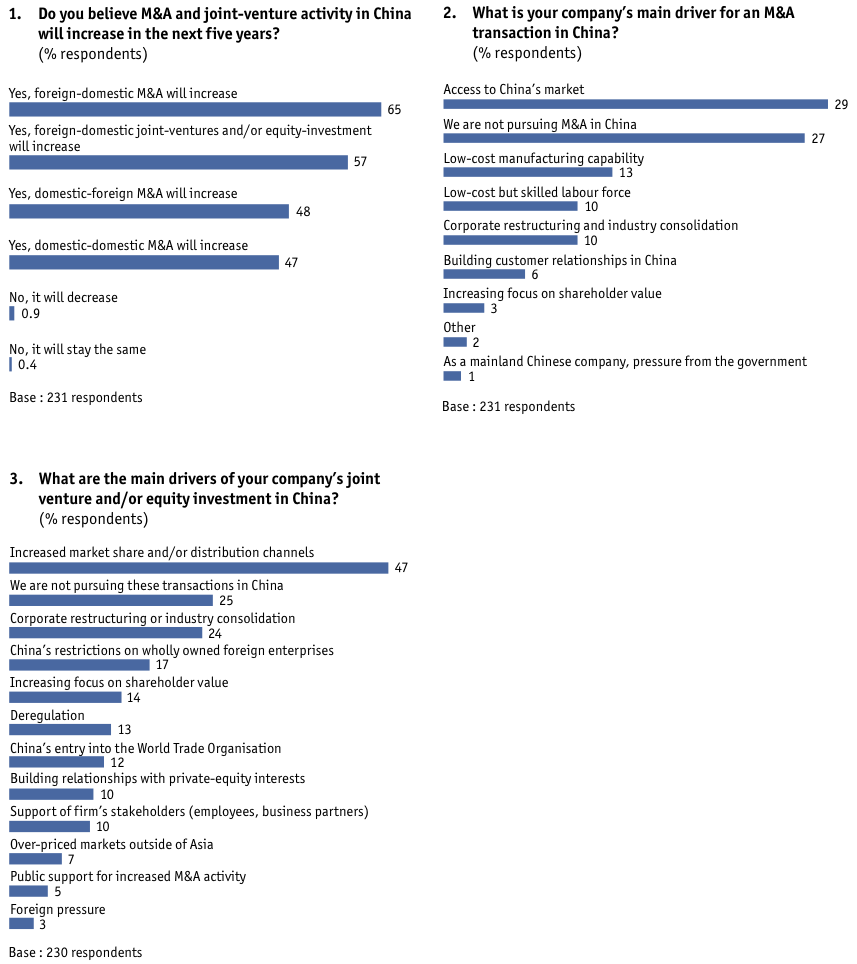

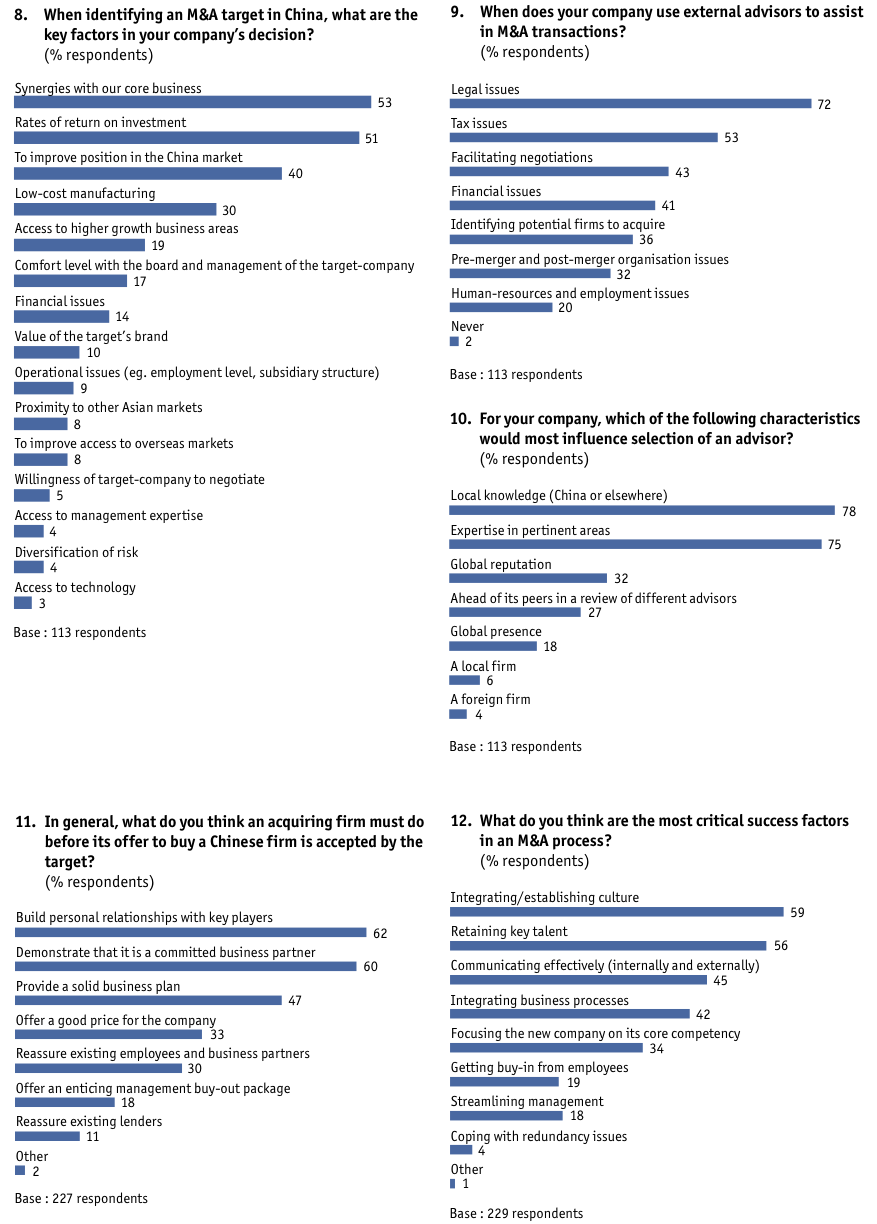
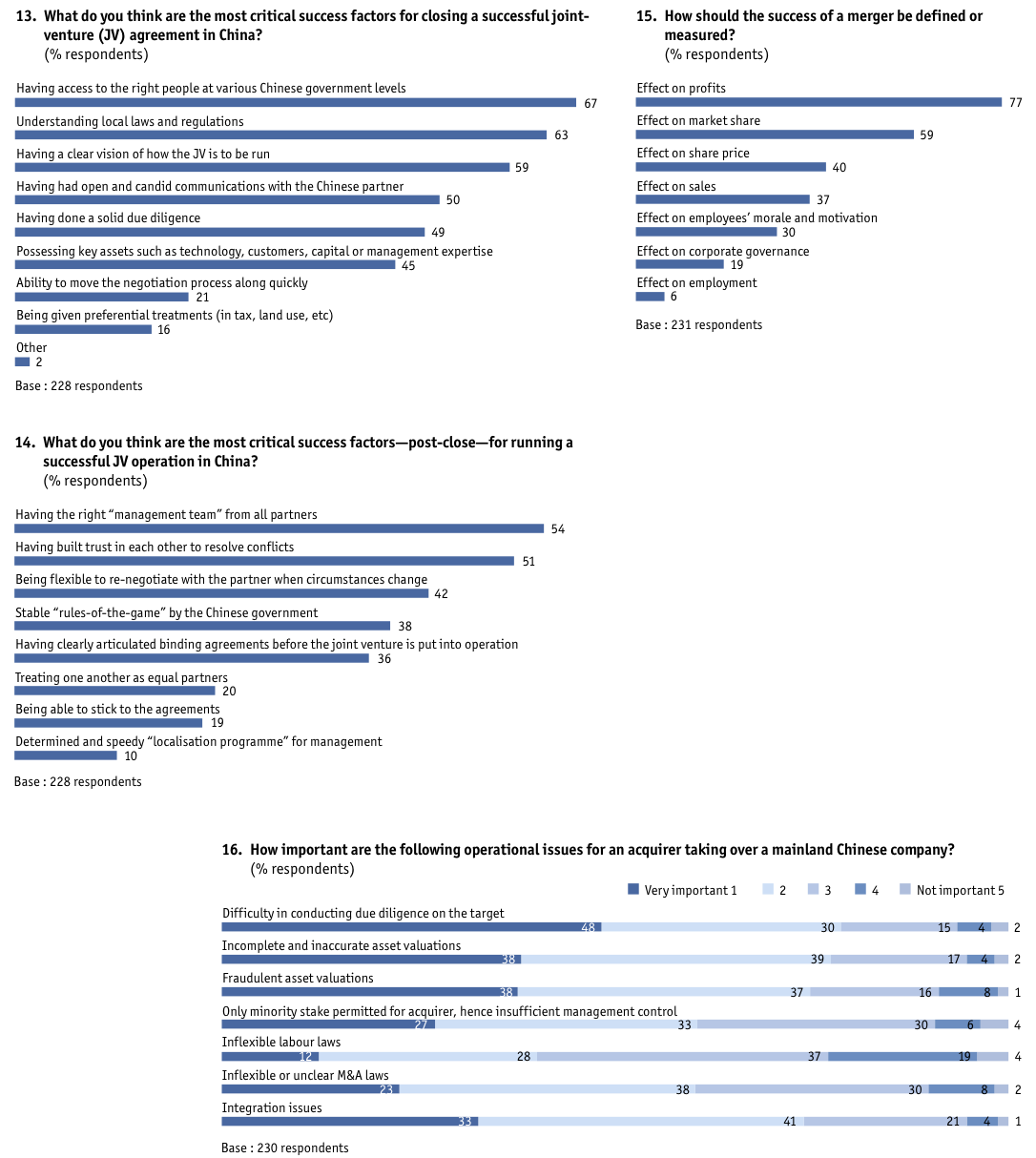

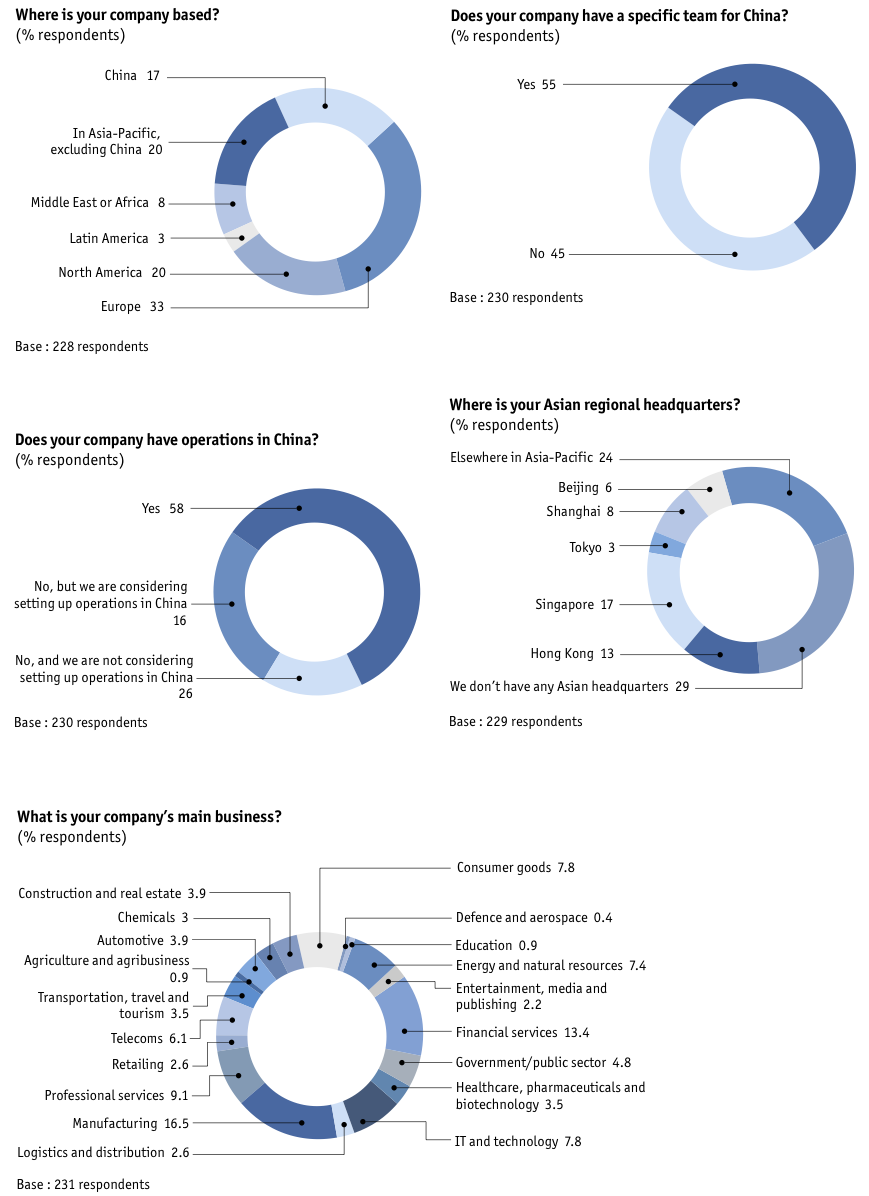
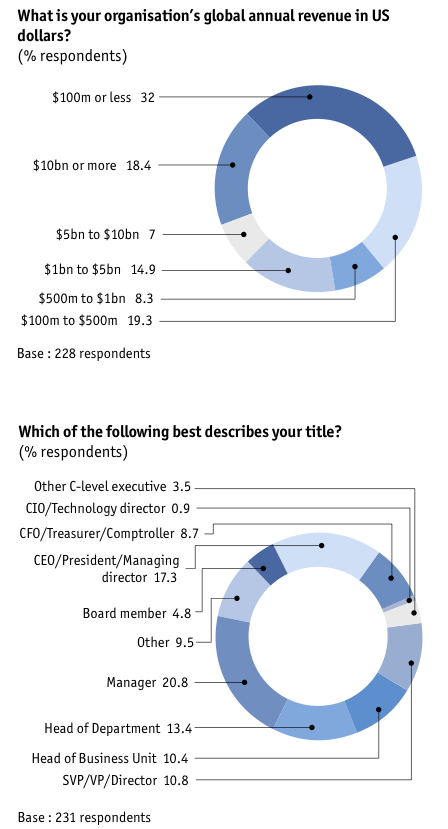
Appendix: Survey results/China-based companies only
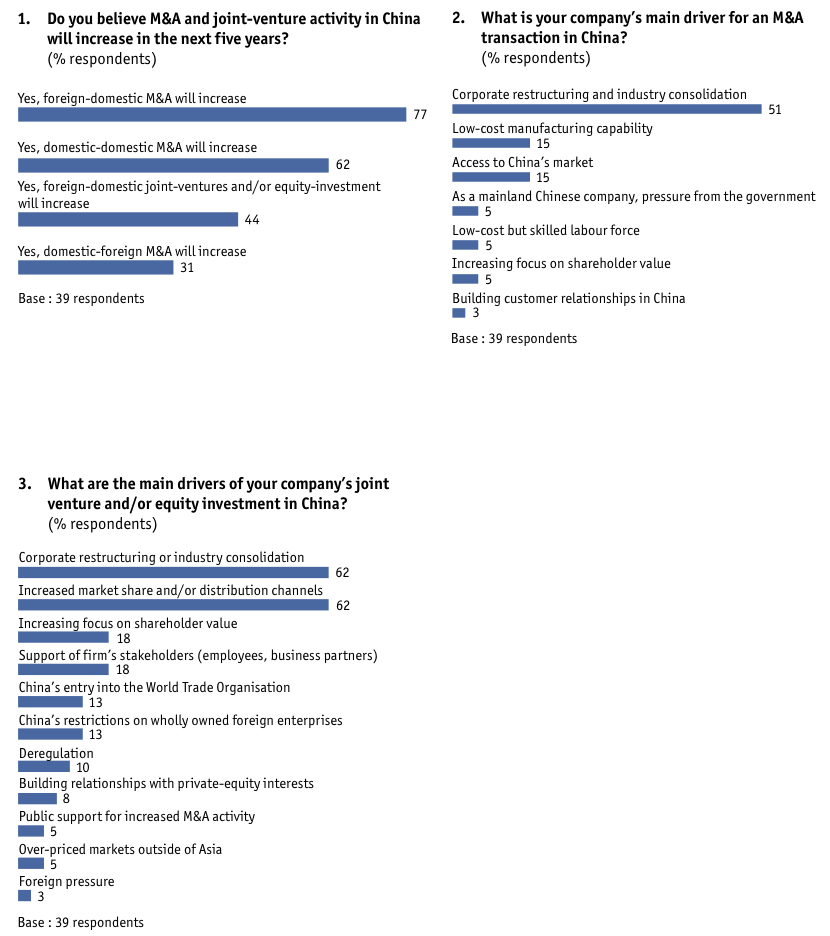
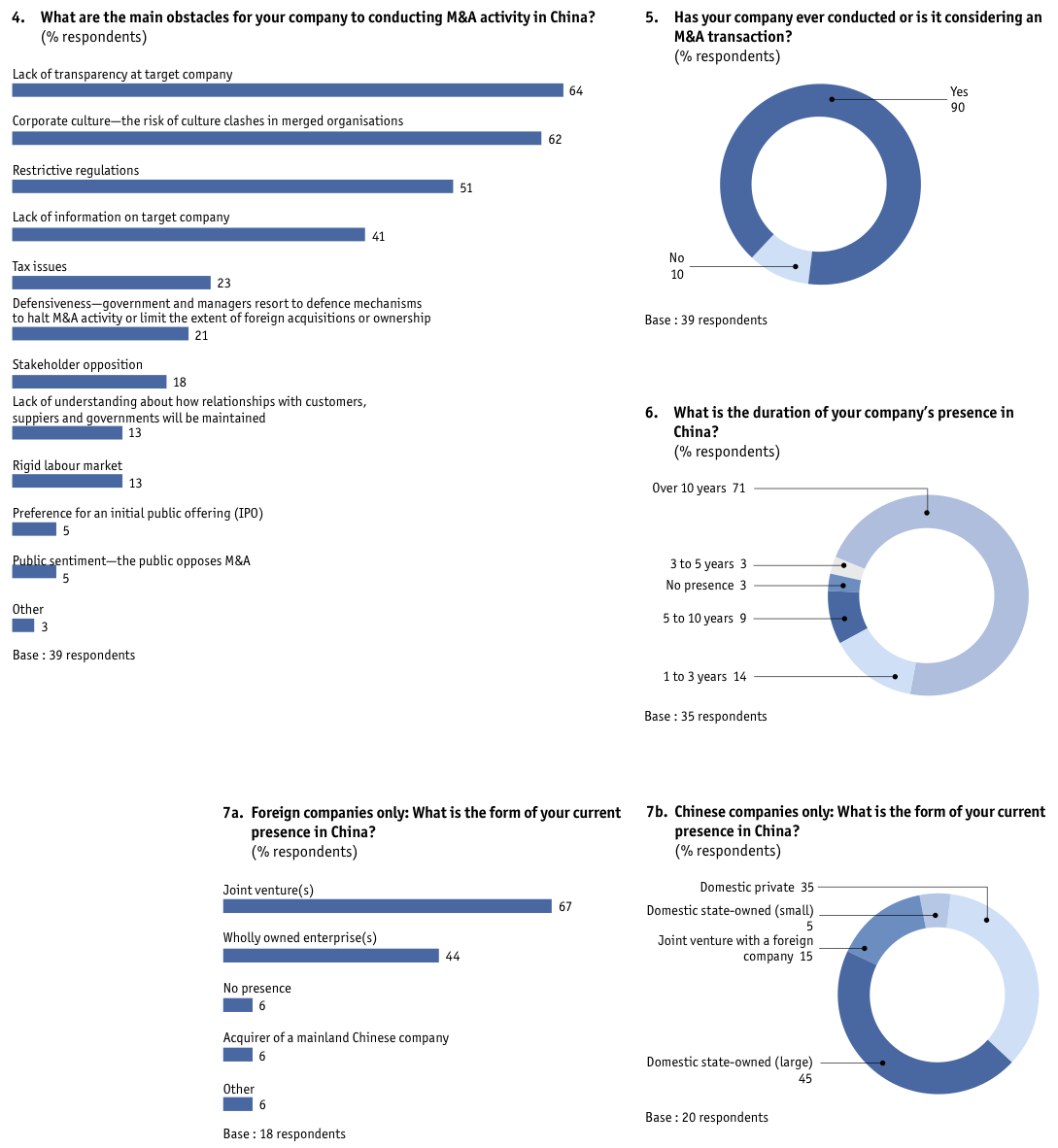
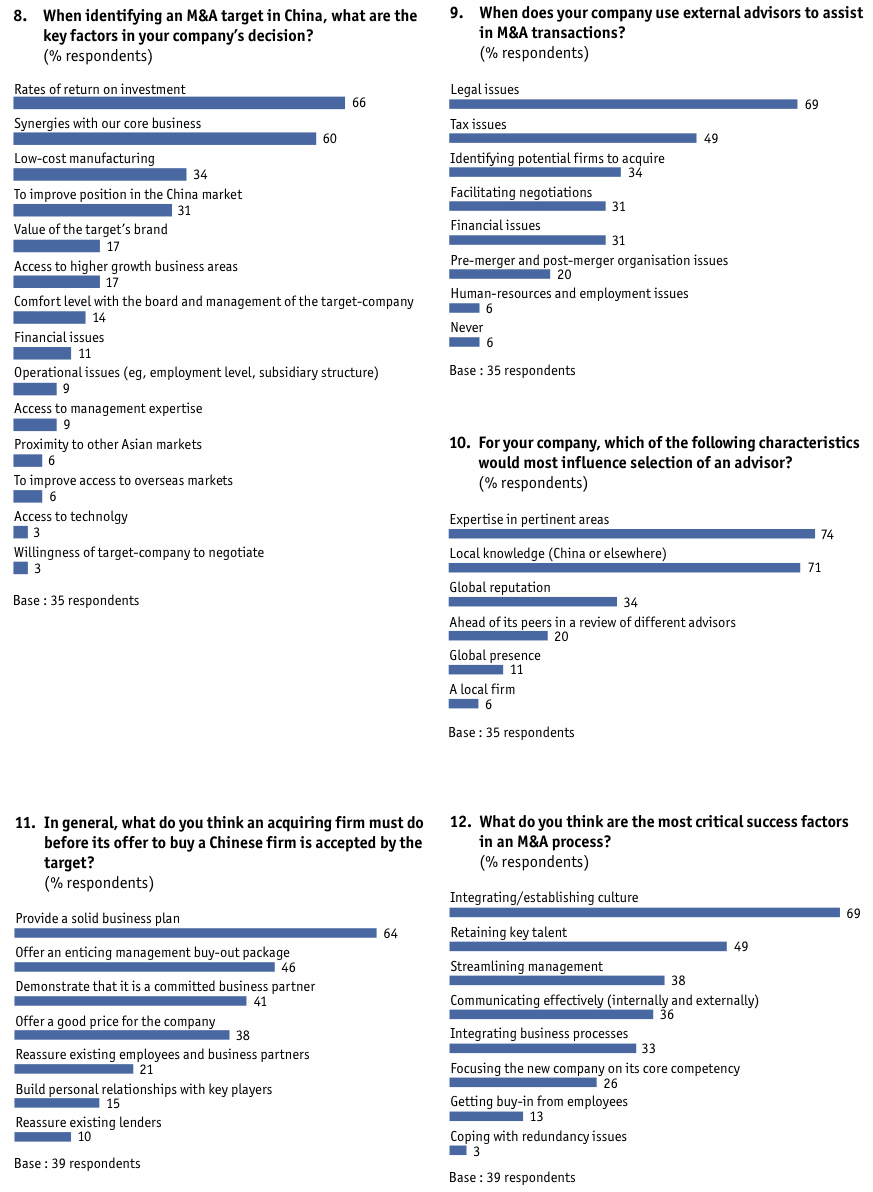
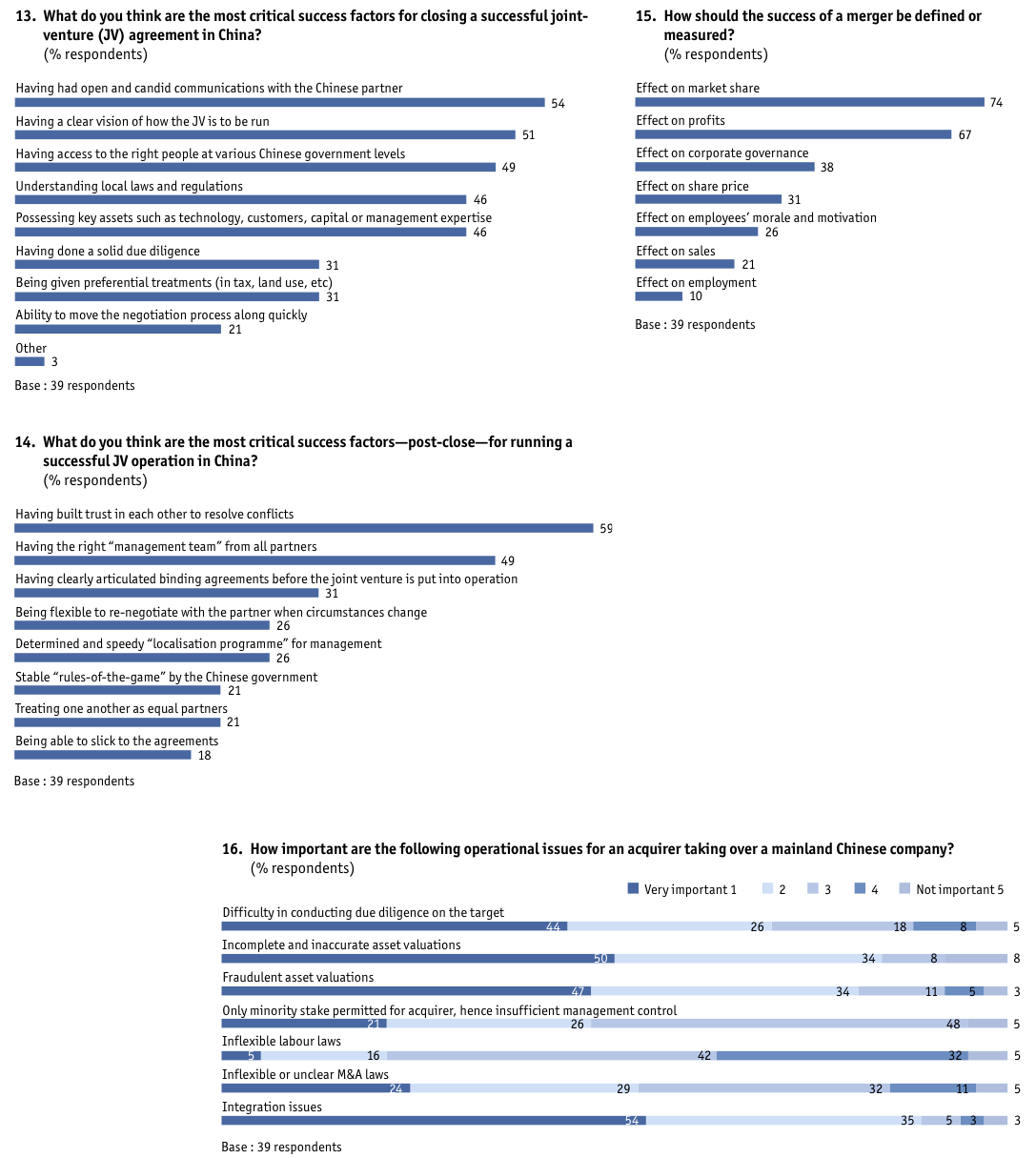
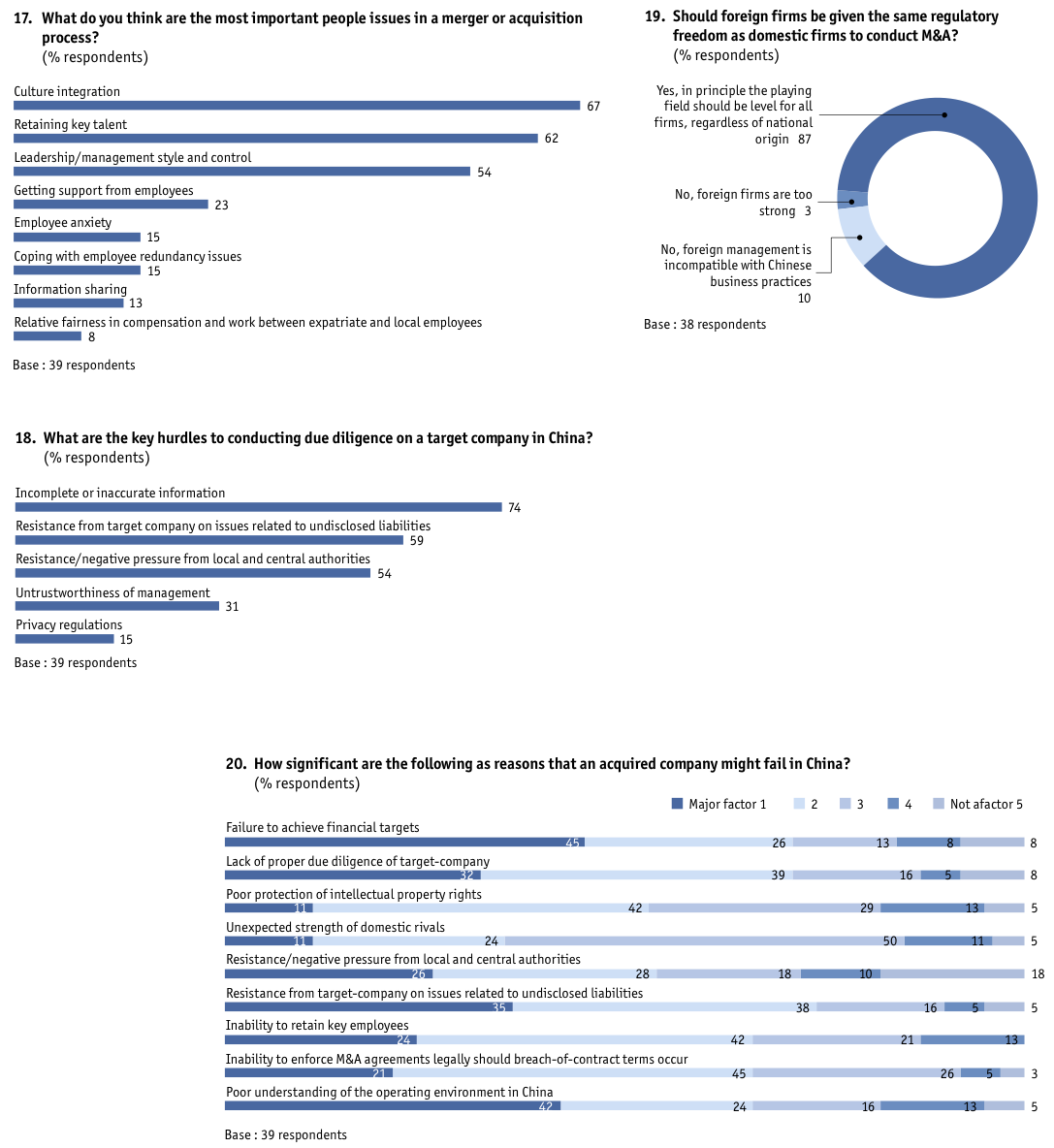
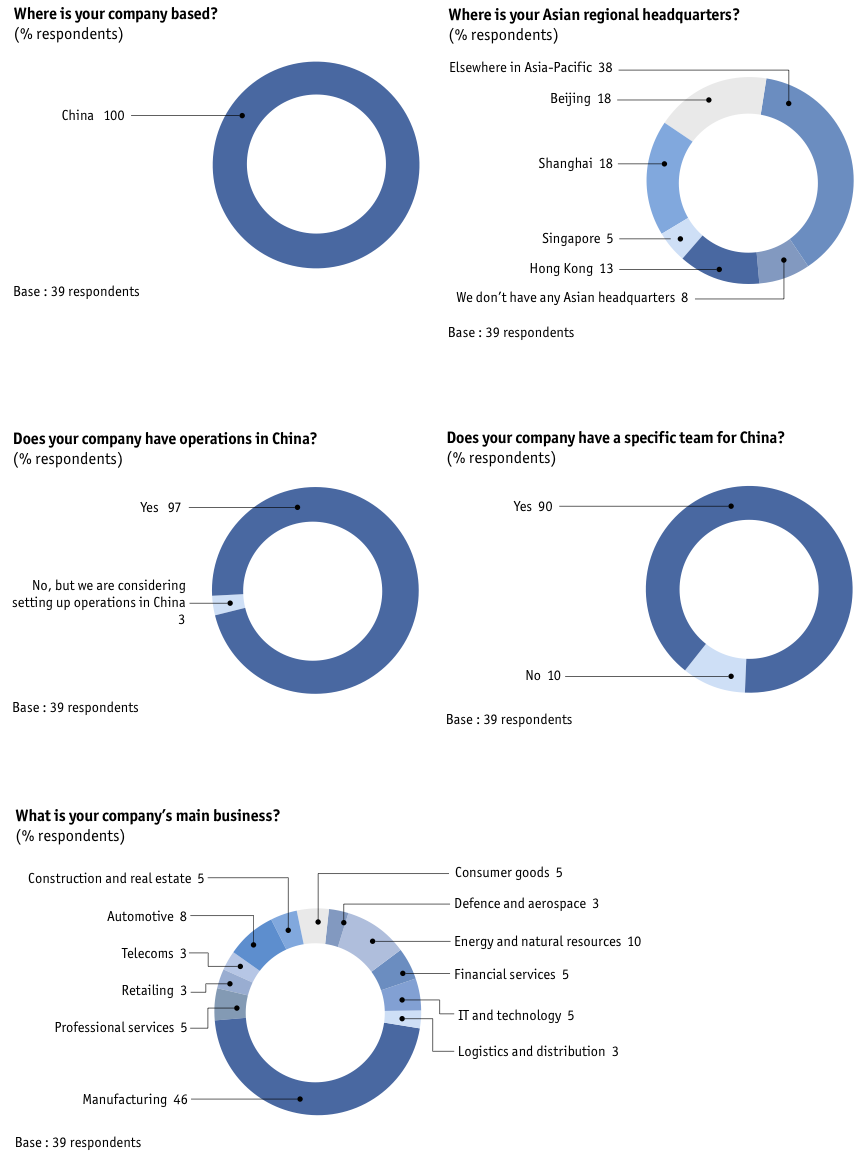
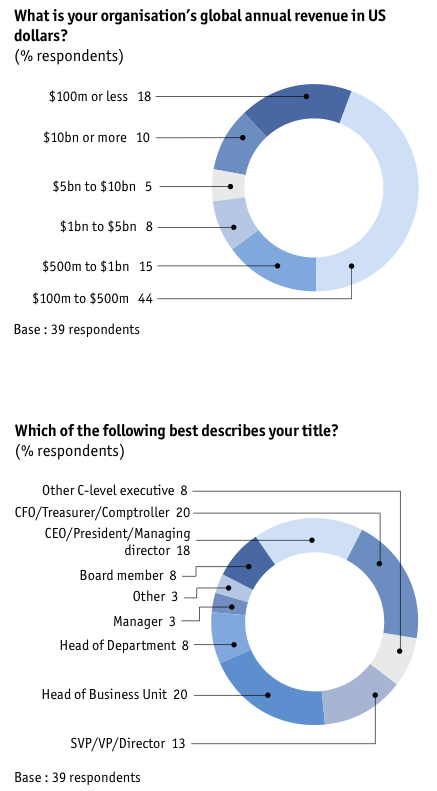
Appendix: Survey results/Asia-based companies only, excluding China
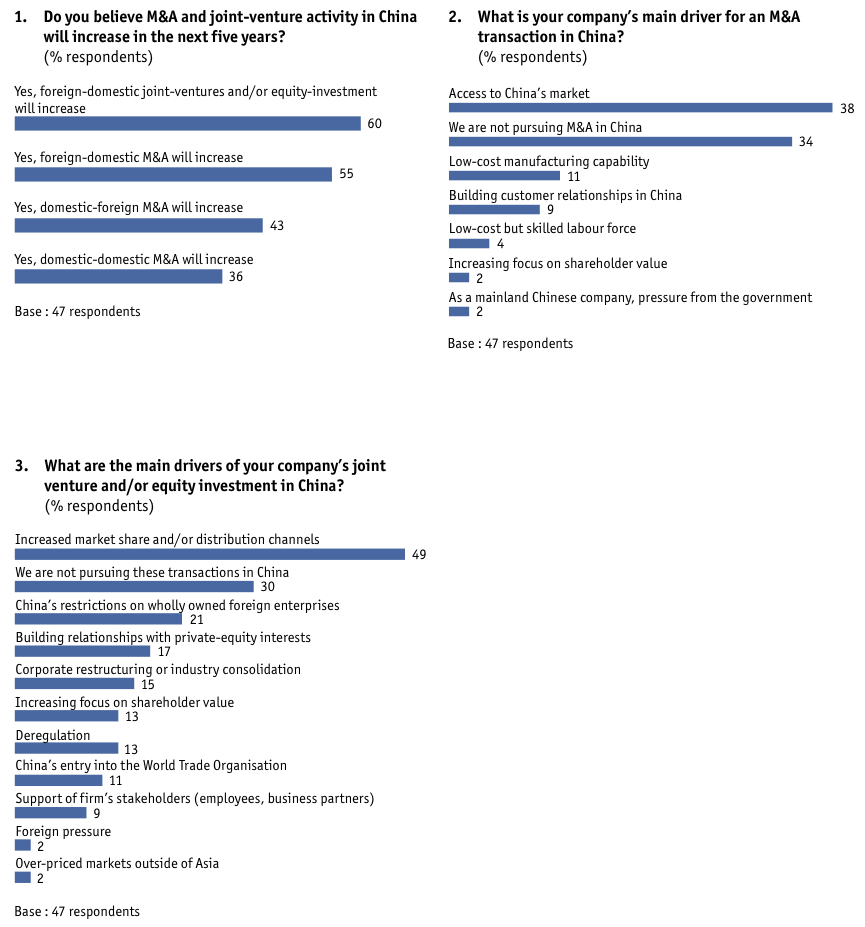
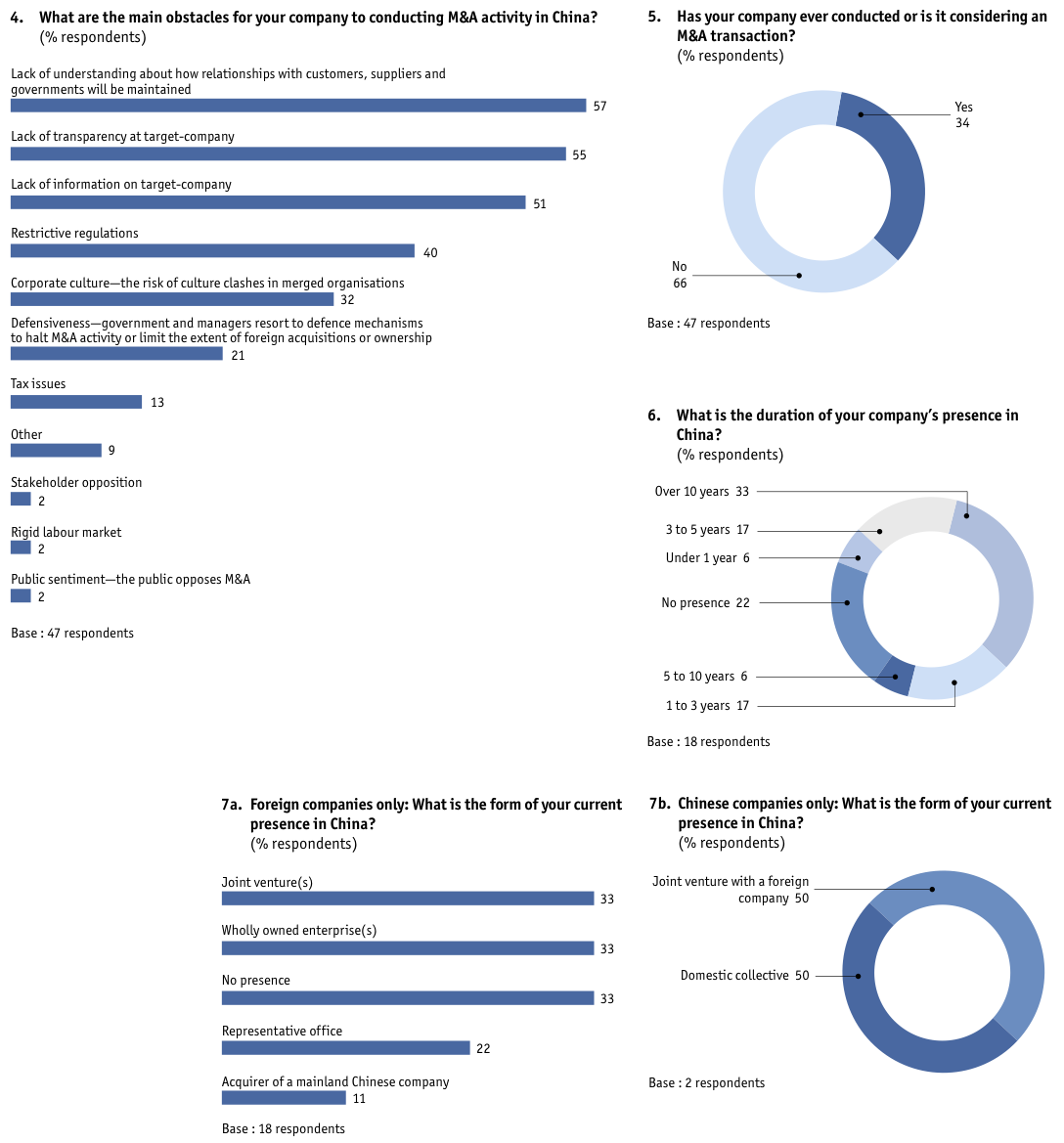
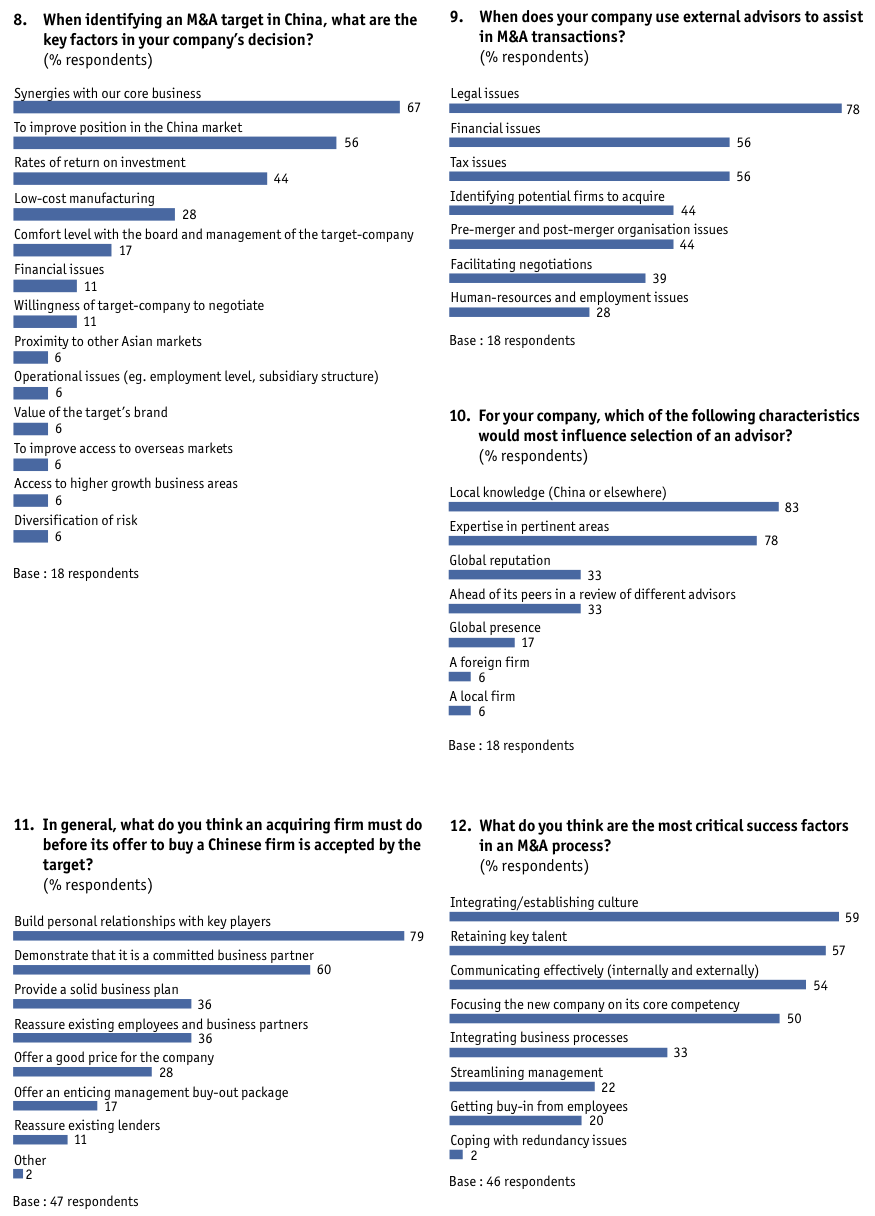
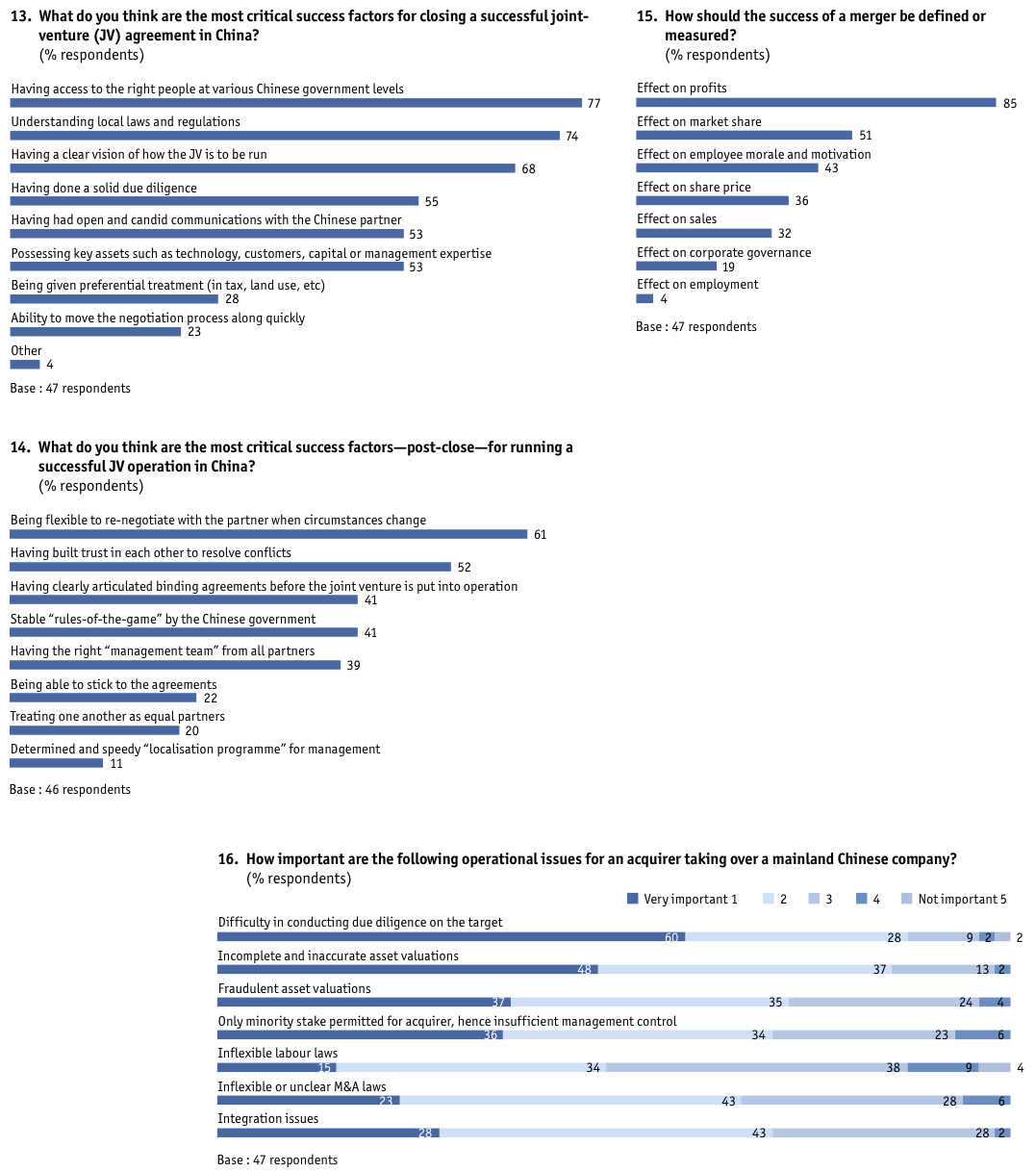
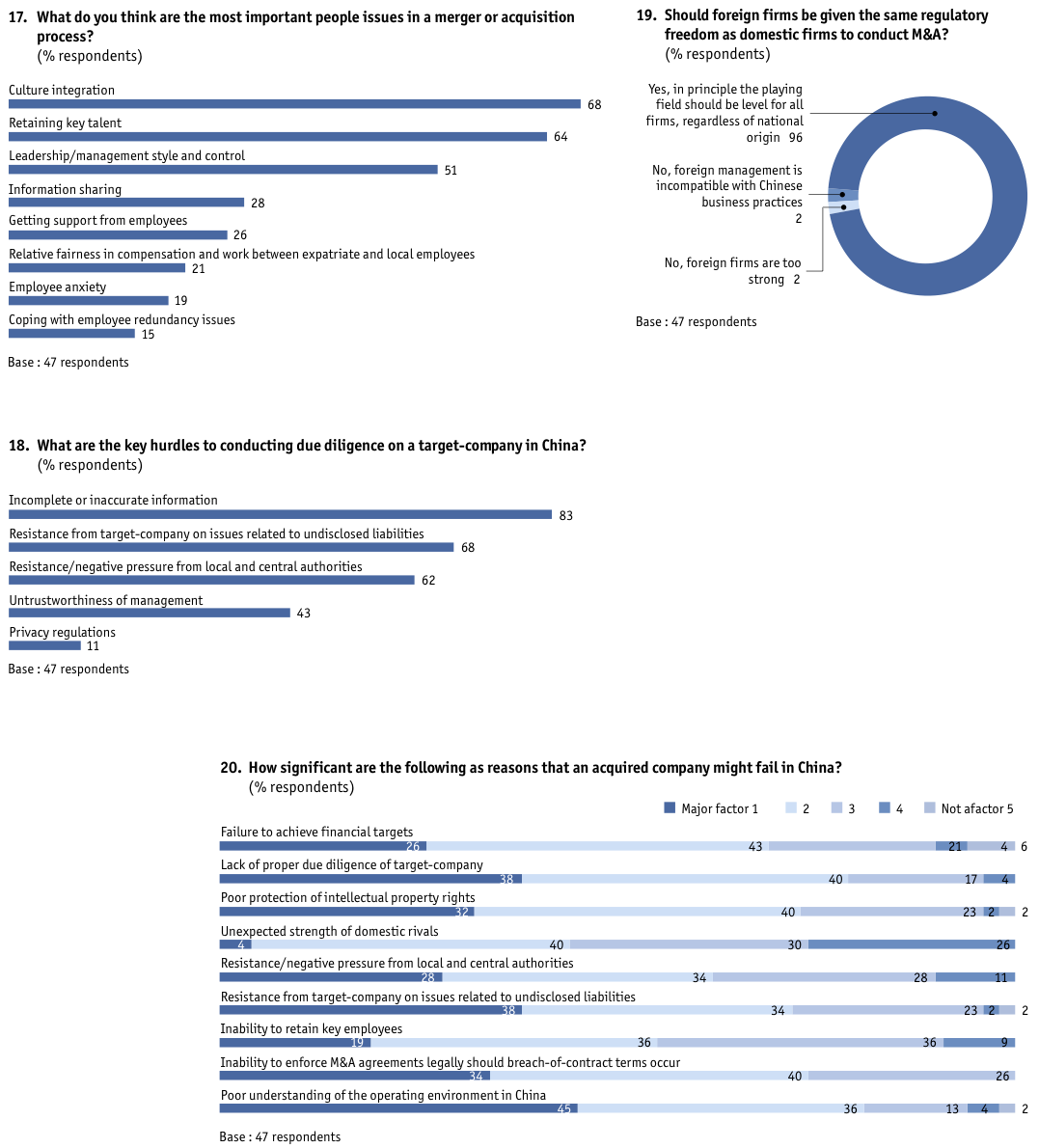
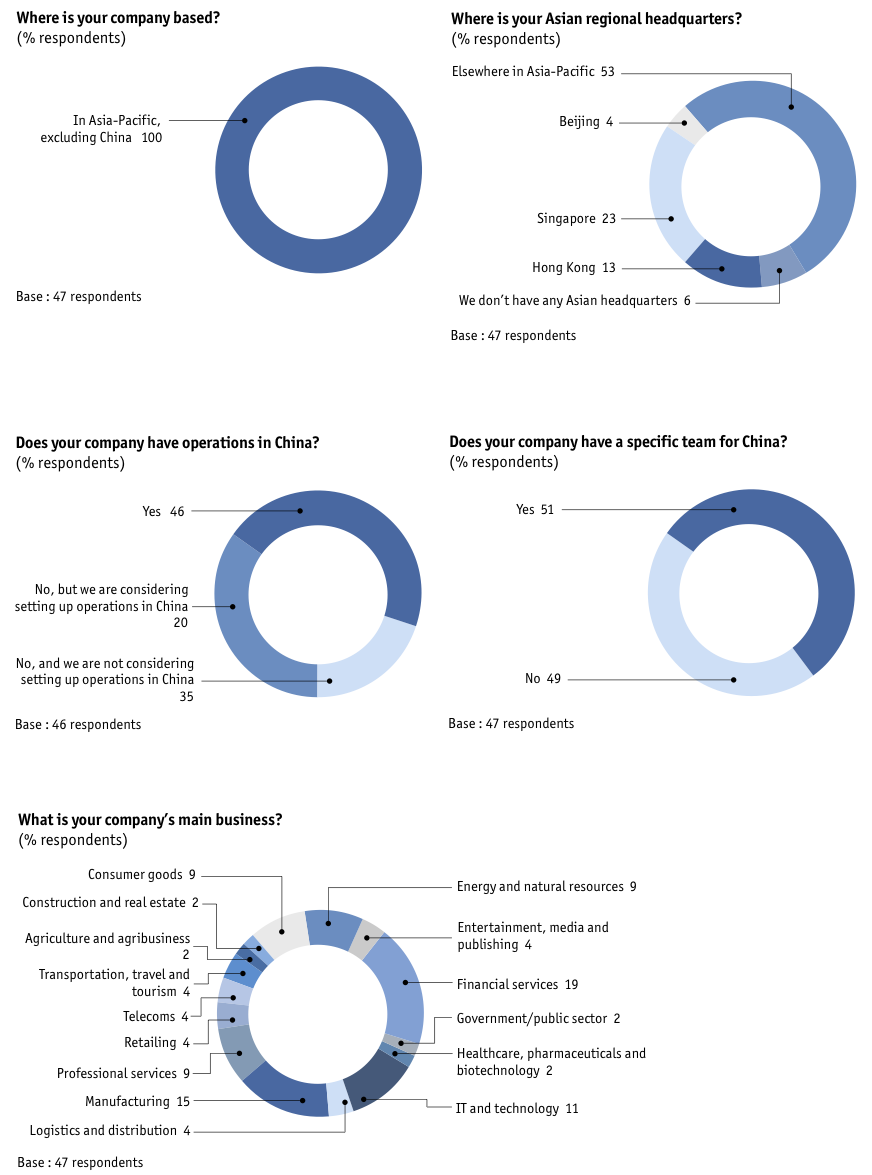
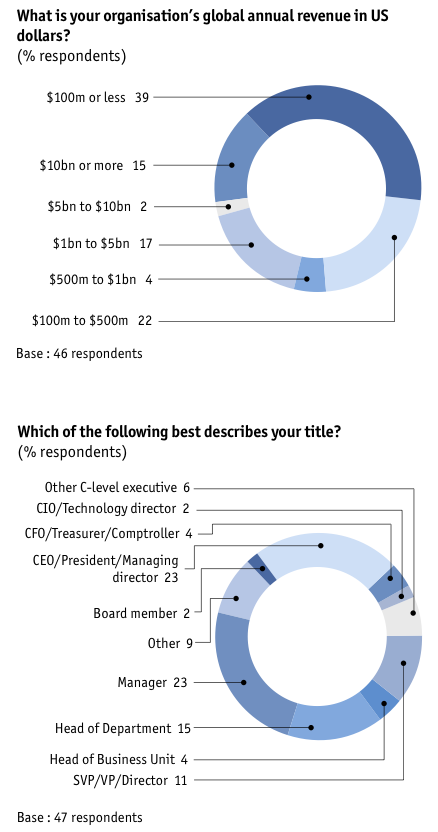
Appendix: Survey results/North America-based companies only
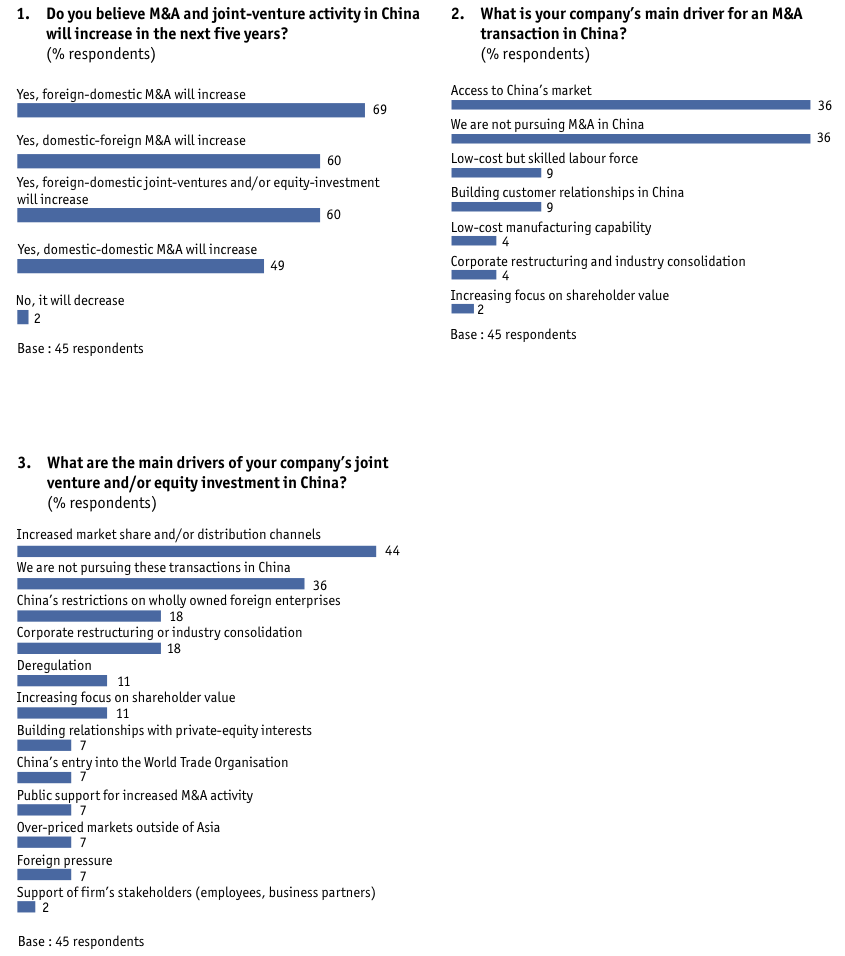

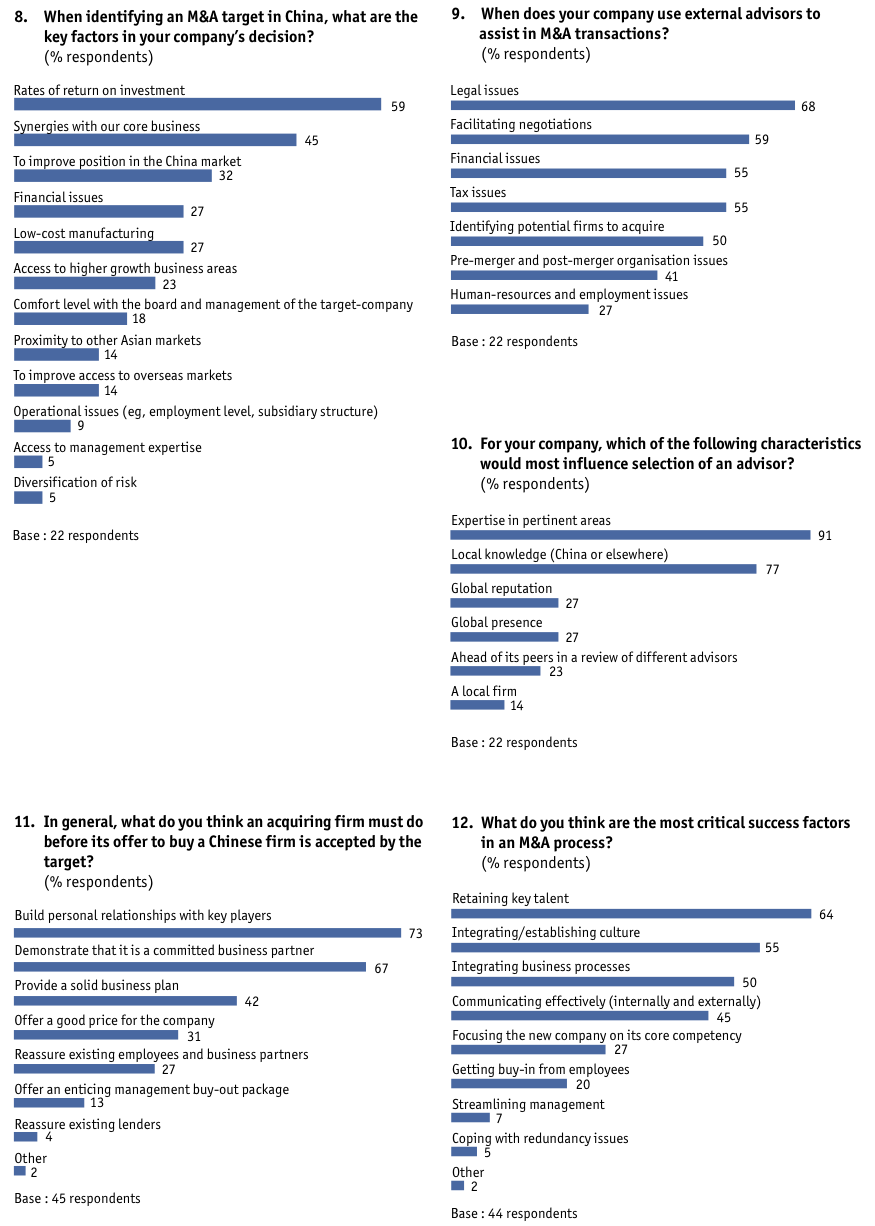

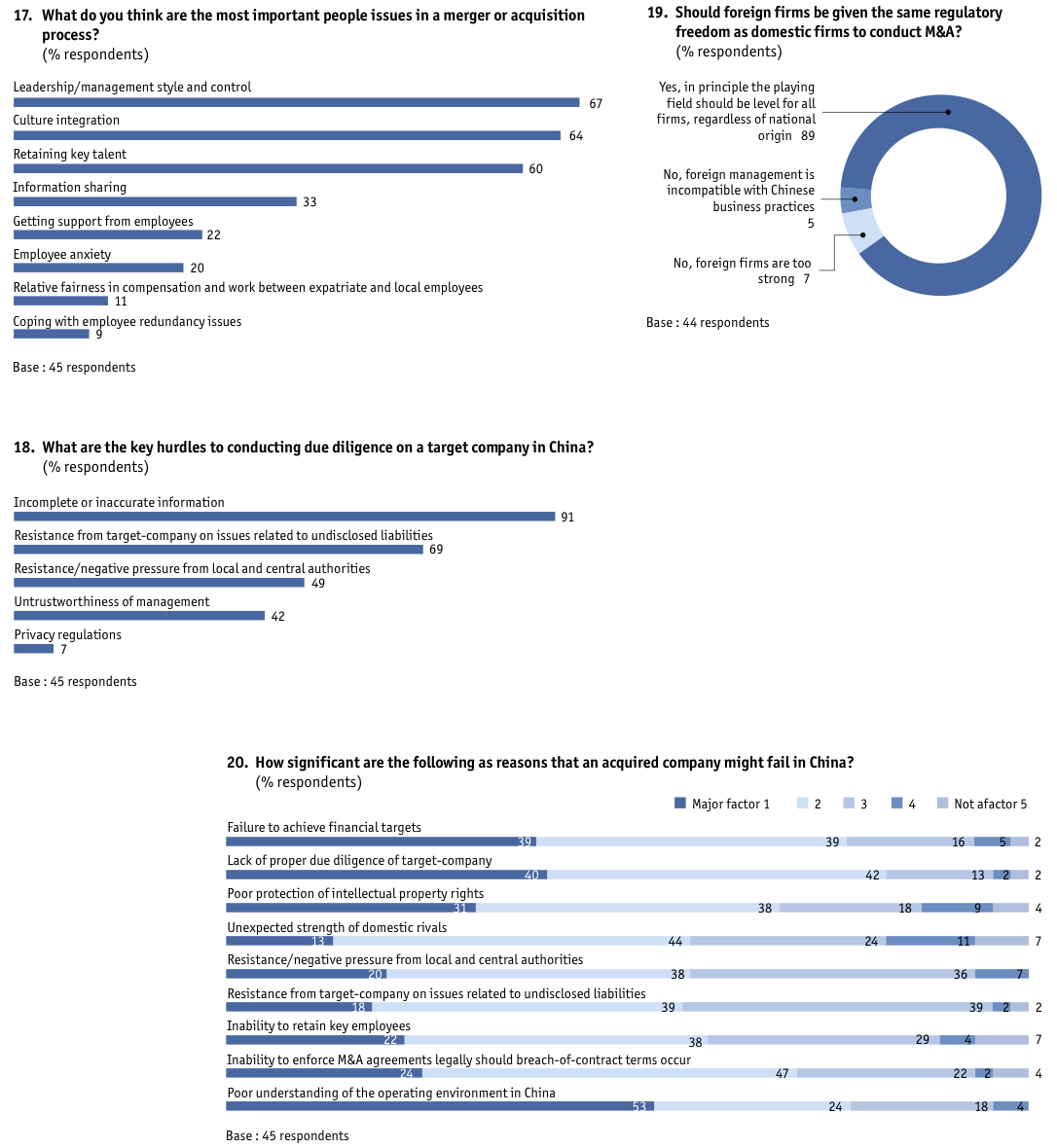
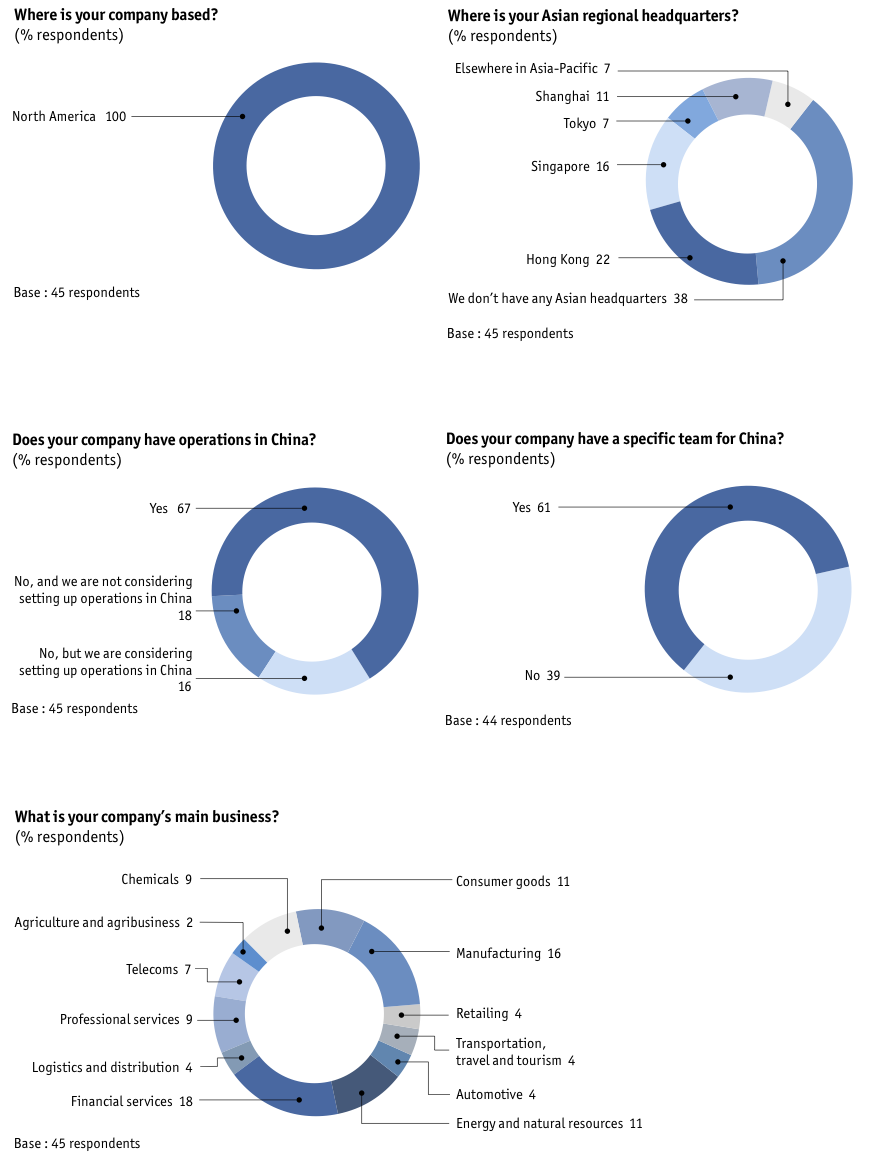
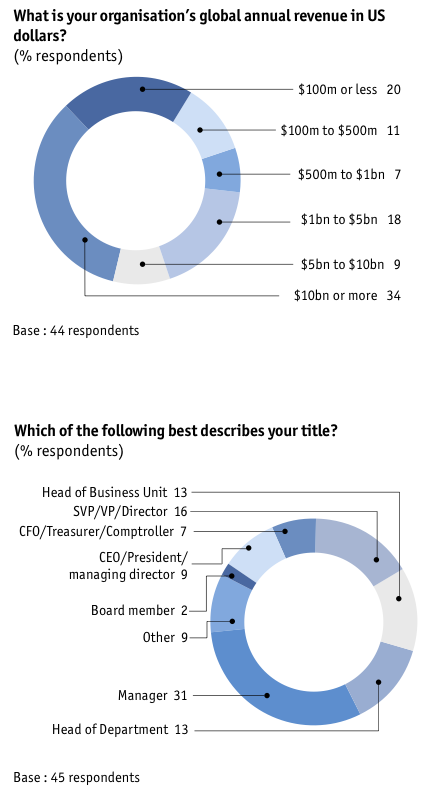
Appendix: Survey results/Europe-based companies only

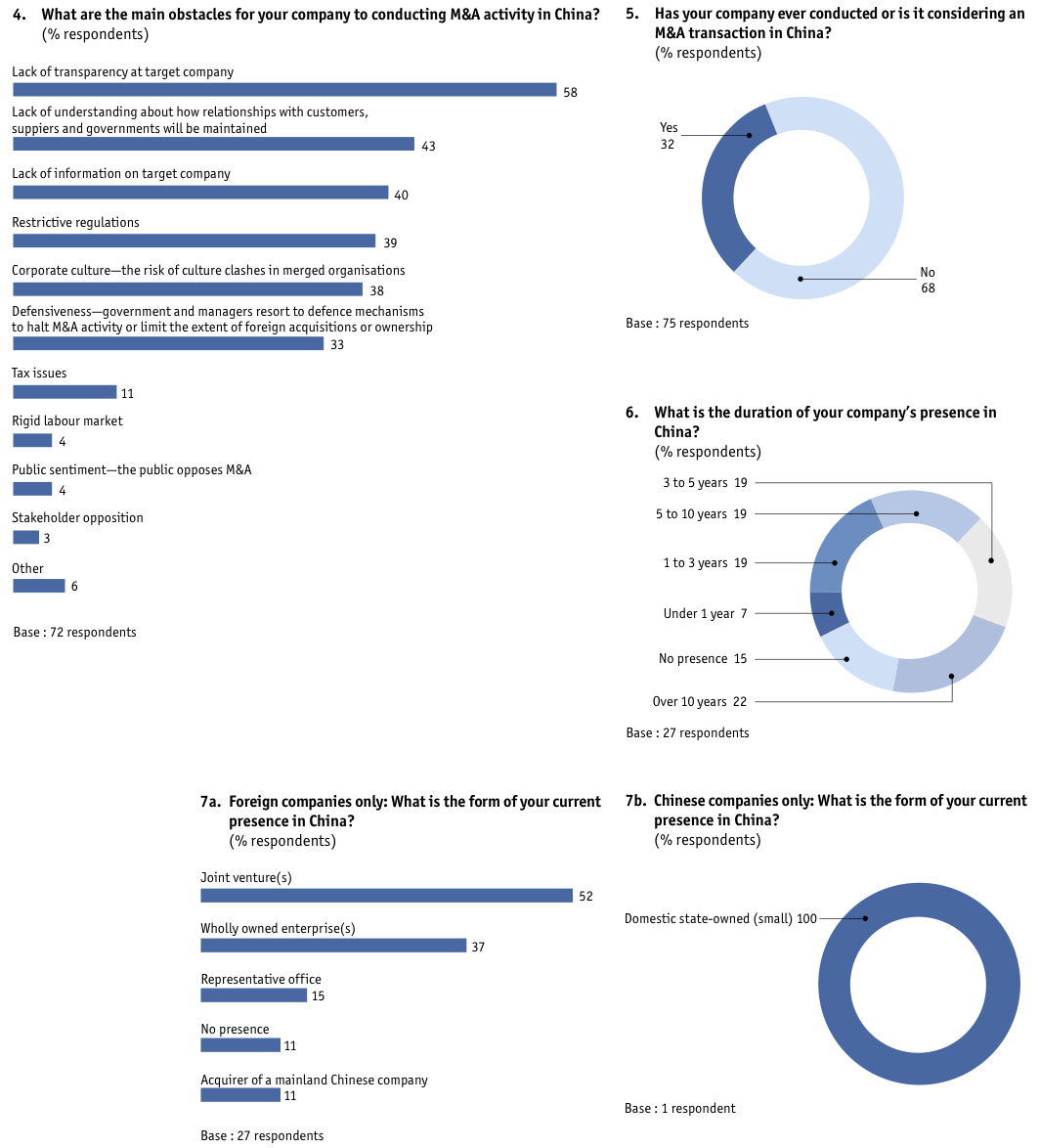

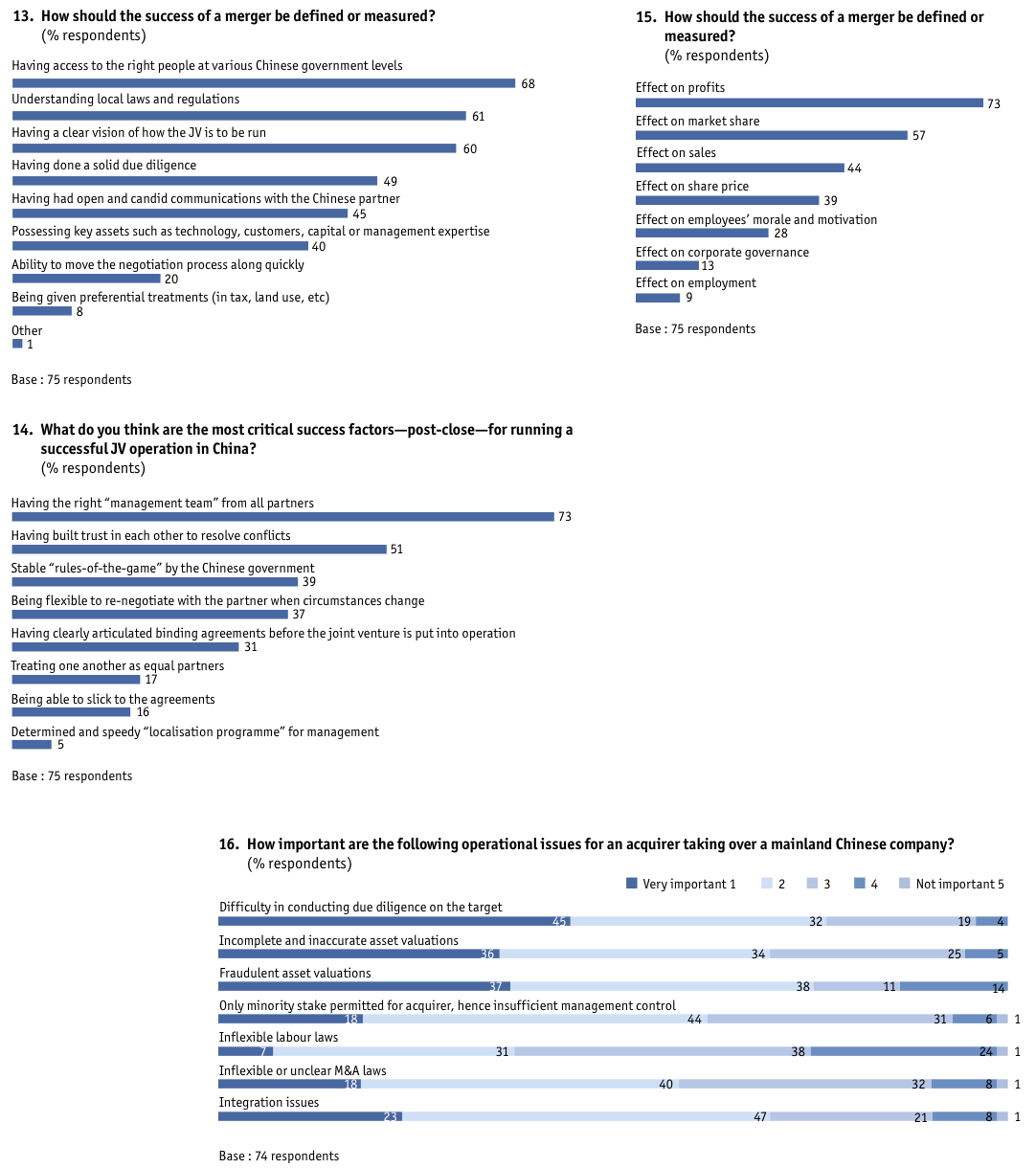
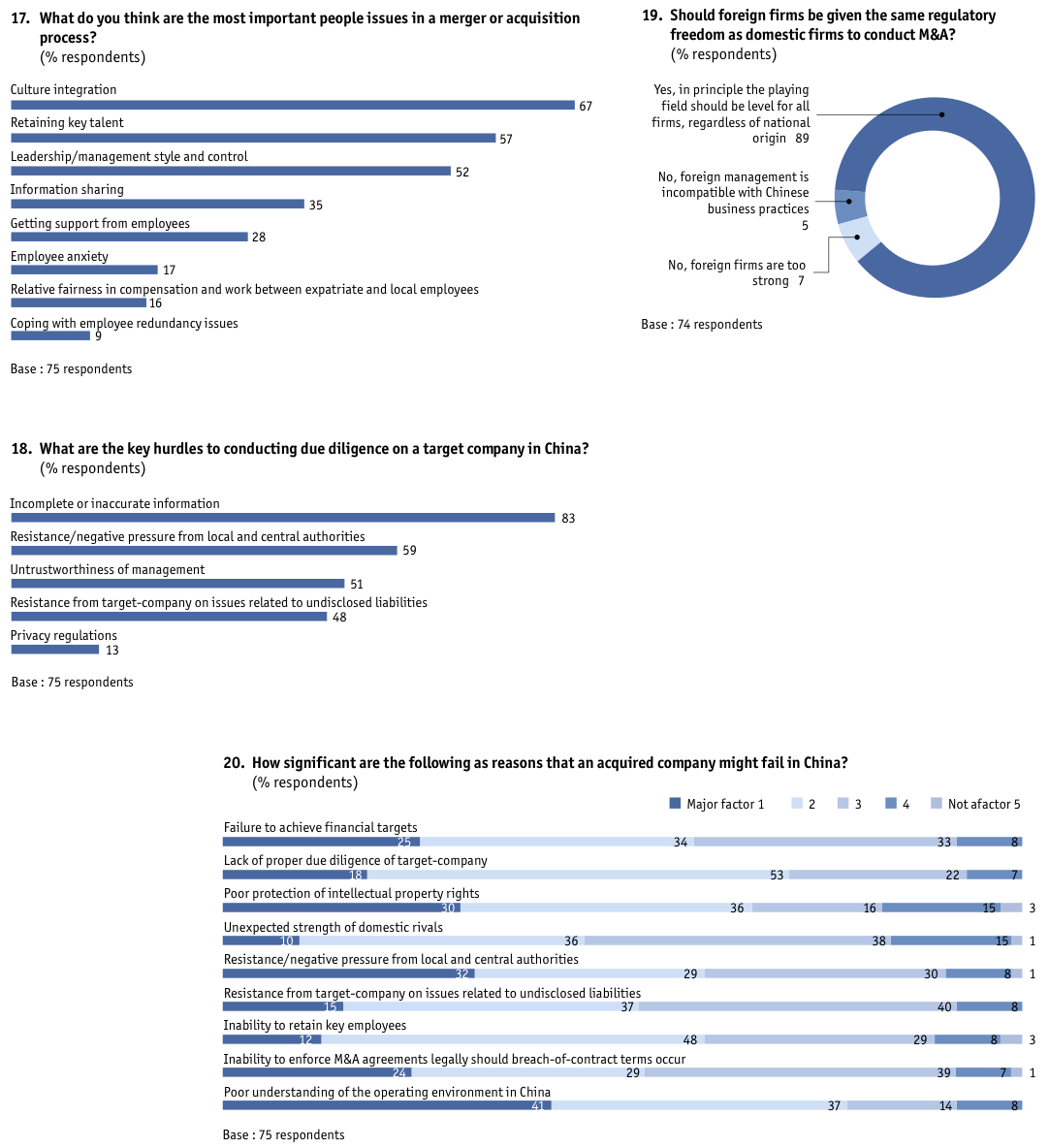
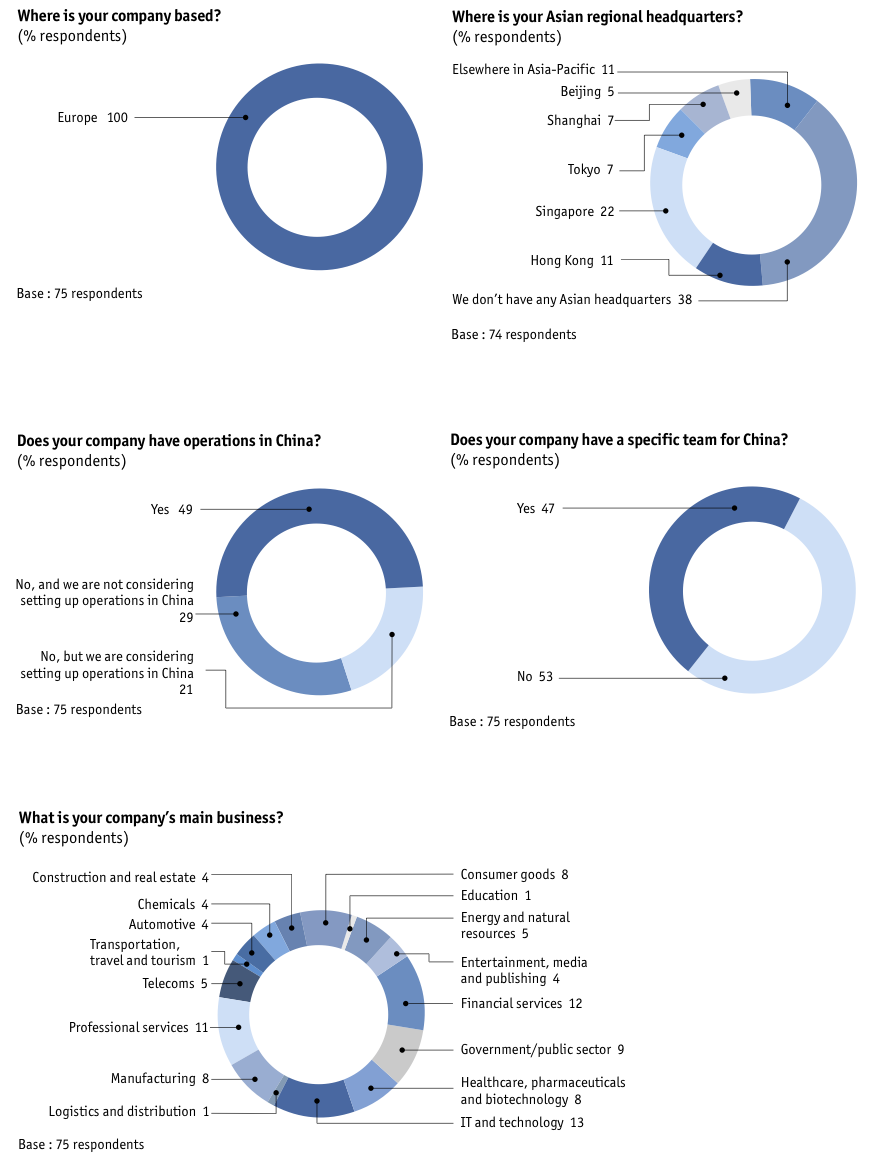
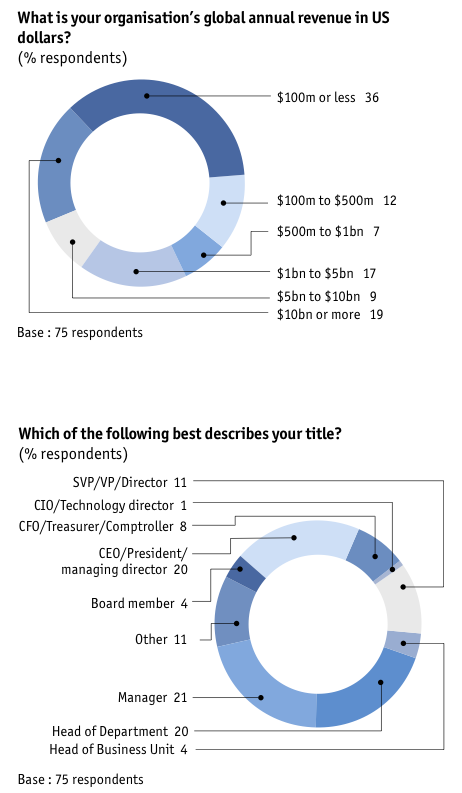
TAGS:


Stay up to date with M&A news!
Subscribe to our newsletter


